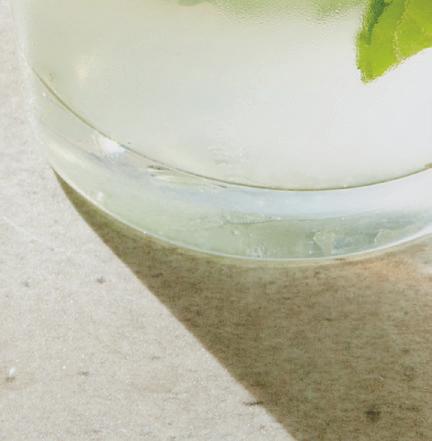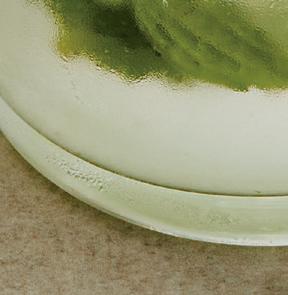






























Those who love to cook make more than food in the kitchen. They make the most of every moment together—sharing stories, creating delicious flavors and simply enjoying the company of close friends. For more than 80 years, Le Creuset has been a part of these special times, and a colorful companion to all who savor food—and life—to the fullest. To learn more about Le Creuset’s classic French quality, and the joys of cooking with premium enameled cast iron, visit www.lecreuset.com.















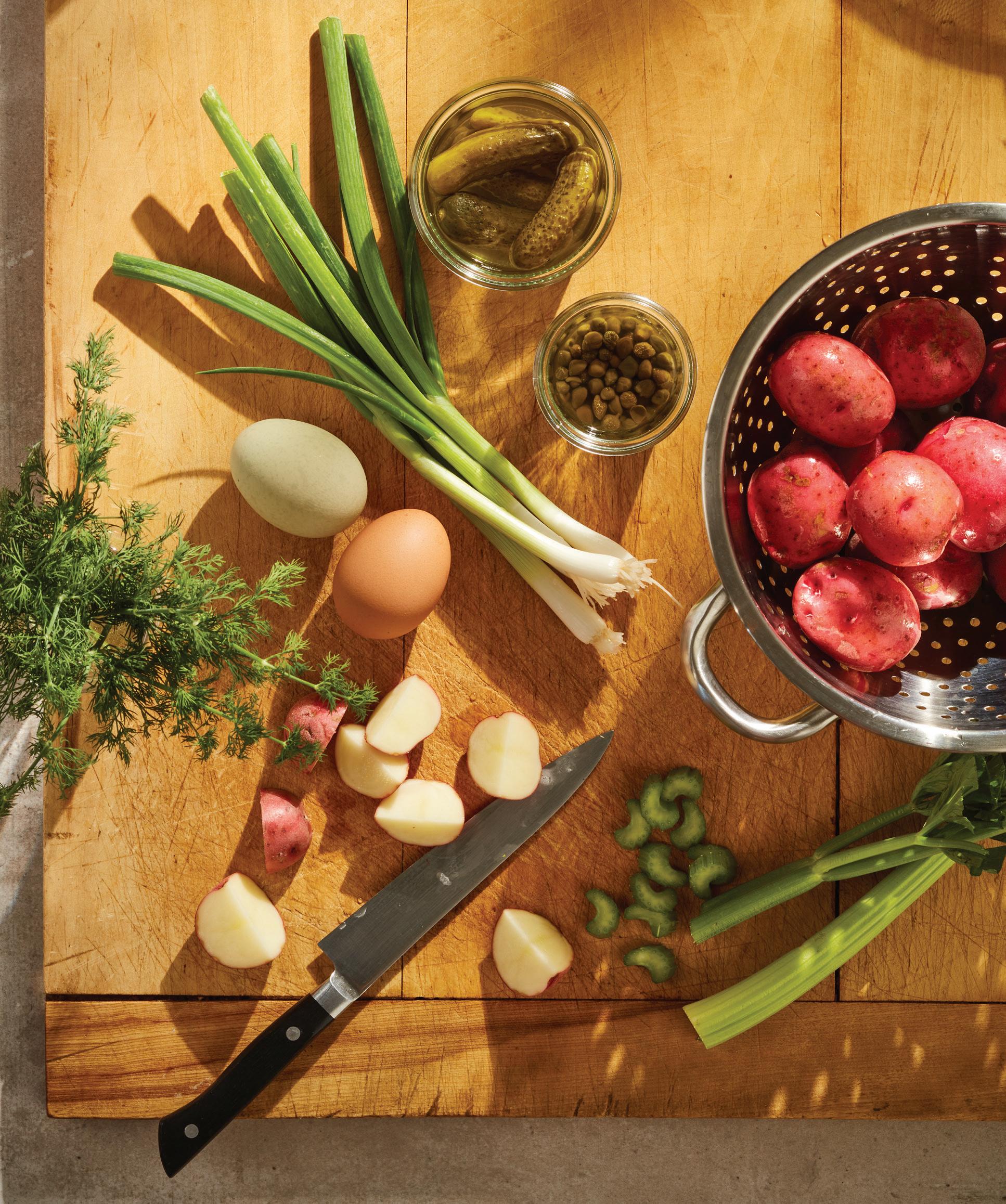
Every barbecue needs potato salad. This uptown version might just steal the show (page 23).
“If summer had one defining scent, it’d definitely be the smell of barbecue.”
–KATIE LEE
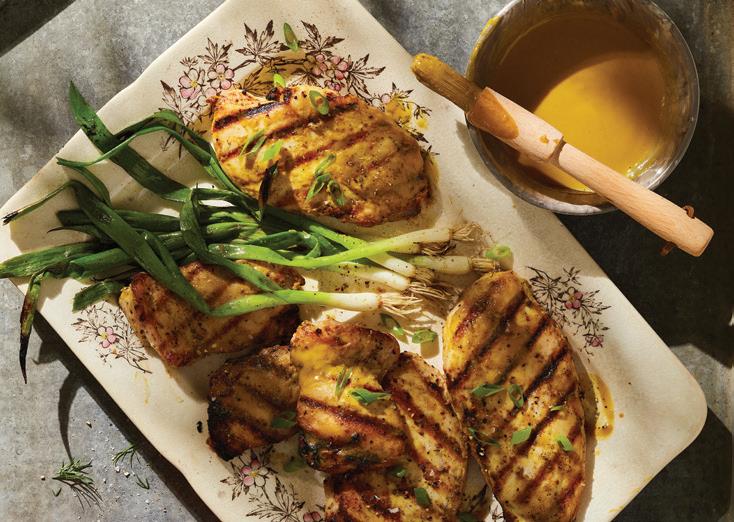
Dish up cool sides and main meals with creative salads.
RECIPES BY KATHY KORDALIS

Leafy greens pack a nutritious punch into any dish.
BY MACY HARDER
It’s prime time for juicy, tasty tomatoes.
BY MARY SUBIALKA
Master flavor with the right equipment and creative ideas for nextlevel grilling.
BY ALESHA TAYLOR
Elevate this season’s cookouts with regional barbecue styles and updated tasty sides.
BY MOLLY STEVENS

52 Back to the Basics
Chef Rocco DiSpirito reflects on food, family, life in the kitchen, and his new cookbook “Everyday Delicious.”
BY EMMA ENEBAK
Nourish your body and mind with these tasty A to Z summer tips and helpful tricks.
BY MACY HARDER
Beat the heat in the kitchen and enjoy more of your day while the slow cooker makes dinner.
BY MARY SUBIALKA
Elevate your cookout with innovative, smoky vegan creations.
RECIPES BY TERRY SARGENT
Mix up party-size cocktails for breezy summer entertaining.
BY MARY SUBIALKA
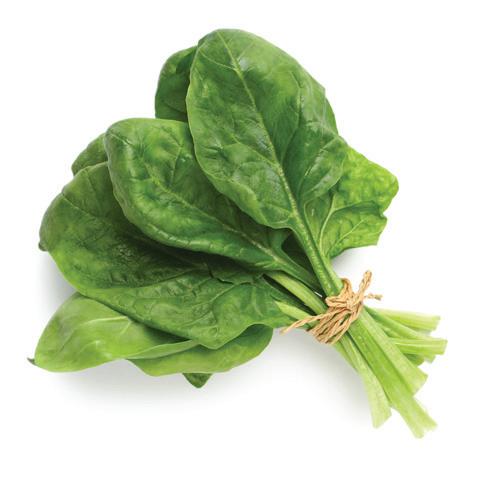
BE “STRONG TO THE FINISH” AND EAT YOUR SPINACH. See page 4
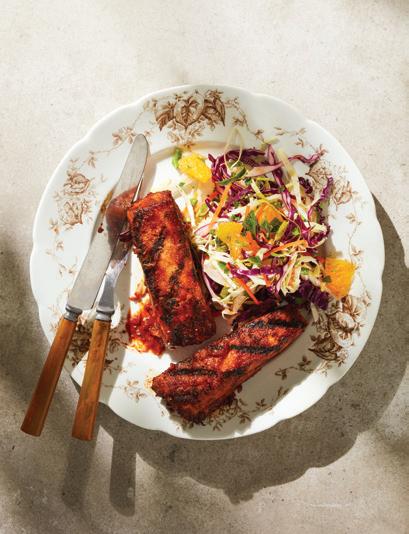
ON THE COVER
Country-Style Pork Ribs with Tangy-Sweet Barbecue Sauce, page 24
PHOTOGRAPHER
Terry Brennan
FOOD STYLIST
Lara Miklasevics
PUBLISHER
Tammy Galvin
EDITORIAL DIRECTOR
Alesha Taylor
CONTENT DIRECTOR
Mary Subialka
CONTRIBUTING
EDITORS
Emma Enebak
Macy Harder
CREATIVE DIRECTOR
Ted Rossiter
ART DIRECTOR
Olivia Curti
PRODUCTION DIRECTOR
Deidra Anderson
ADVERTISING COORDINATOR
Sydney Kell
SALES & MARKETING SPECIALIST
Tausha Martinson-Bright
VOLUME 20, NUMBER 2
Real Food magazine is published quarterly by Greenspring Media, LLC, 9401 James Ave. S., Suite 152, Bloomington, MN 55431, 612.371.5800, Fax 612.371.5801. All rights reserved. No part of this publication may be reprinted or otherwise reproduced without written permission from the publisher. Real Food is exclusively operated and owned by Greenspring Media, LLC. Printed in the USA. realfoodmag.com
The pages between the covers of this magazine (except for any inserted material) are printed on paper made from wood fiber that was procured from forests that are sustainably managed to remain healthy, productive and biologically diverse.
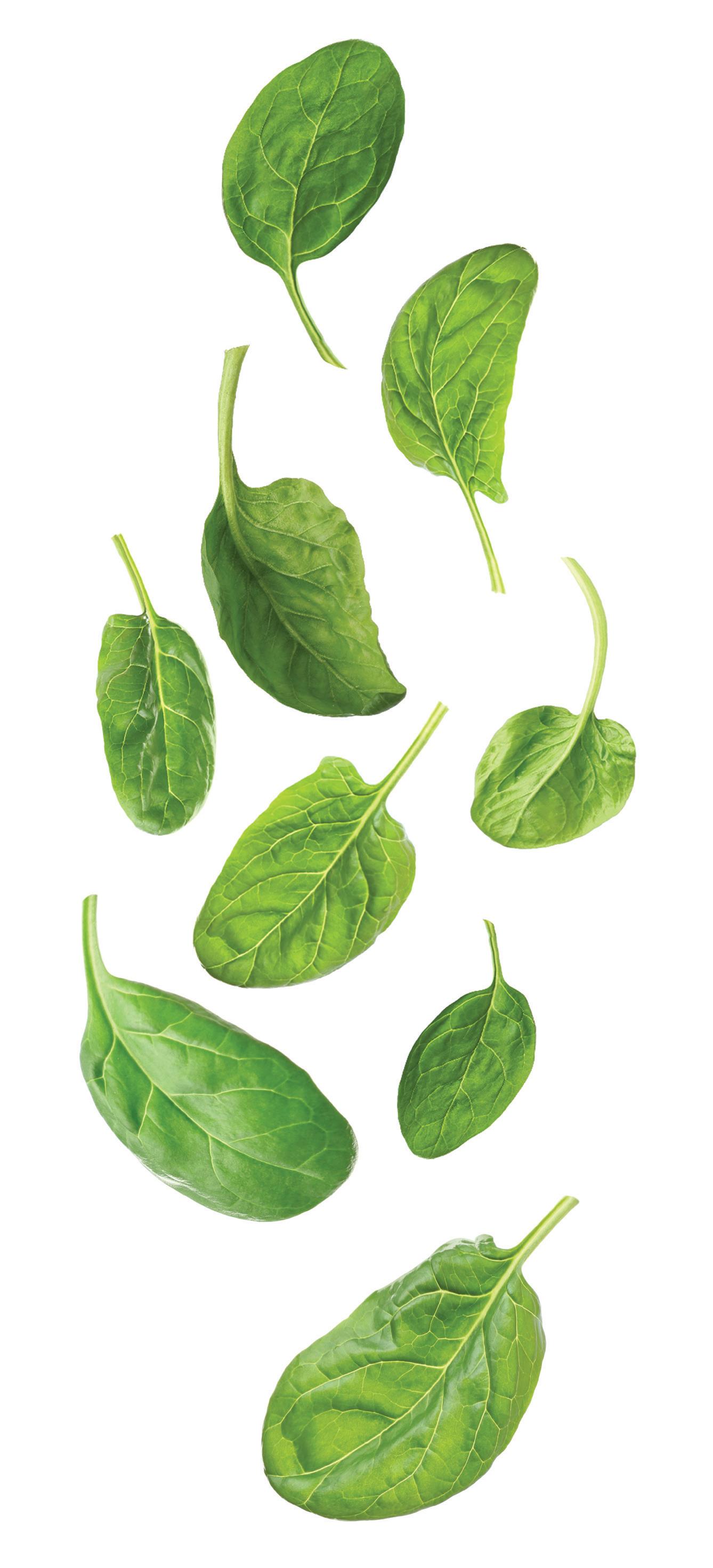
Leafy
greens can pack a nutritious punch into any dish
by macy harder
Dark leafy greens should be a staple in every kitchen, especially during the warmer months. These versatile, vitamin-rich veggies are perfect for packing extra nutrients into light, refreshing meals and snacks. Toss a handful into your smoothie or green juice, add some crunch to your sandwich, or use them as a base for summertime salads.
By their simplest definition, leafy greens are edible plant leaves. You’re probably familiar with using kale, spinach, and lettuce across a bevy of recipes, but don’t forget about bok choy, cabbage, collard greens, chard, and many other varieties. While leafy greens make for an easy, nutritious supplement to any meal, they can also be the stars of the show. Their range of flavors, textures, and aromas can completely transform a dish, especially when cooked and paired with a variety of other ingredients. For example, raw arugula can bring a robust, peppery spice to salads, pizza, or sandwiches, while cooked endive provides a mellow, buttery base for small plates and appetizers.
If you’re familiar with Popeye, then you have probably heard the phrase, “I’m strong to the finish ’cause I eats me spinach.” Unless you’re also a cartoon character, it’s unlikely that you will gain bulging muscles and superhuman strength just from eating spinach. But the fictional sailor was on to something in terms of the vegetable’s dietary value. Leafy greens are nutritional powerhouses—these superfoods are low in calories and carbs and high in fiber, vitamins, minerals, and phytonutrients. The average bowl of salad greens, kale, and spinach is packed with vitamins A, C, E, and K, while mustard greens and bok choy are also rich in B vitamins. While these nutrients are great for your everyday health, dark leafy greens can also help lower the risk of cancer and other diseases in the long run. In fact, due to their high content of folate and antioxidants, dark leafy greens might be some of the best cancer-preventing foods, according to the U.S. Department of Agriculture (USDA). “Studies have shown that eating two to three servings of green leafy vegetables per week may lower the risk of stomach, breast, and skin cancer,” the USDA notes on its website. Additionally, eating leafy greens can support bone and brain health, reduce bloating, promote antiaging, support vision and skin health, and boost your immune system.
Incorporating leafy greens into your diet can be as easy as throwing them in a blender. Whether you’re looking for a small snack, an easy appetizer, or a full-size meal, here are just a few ways to add these vegetables to your plate.
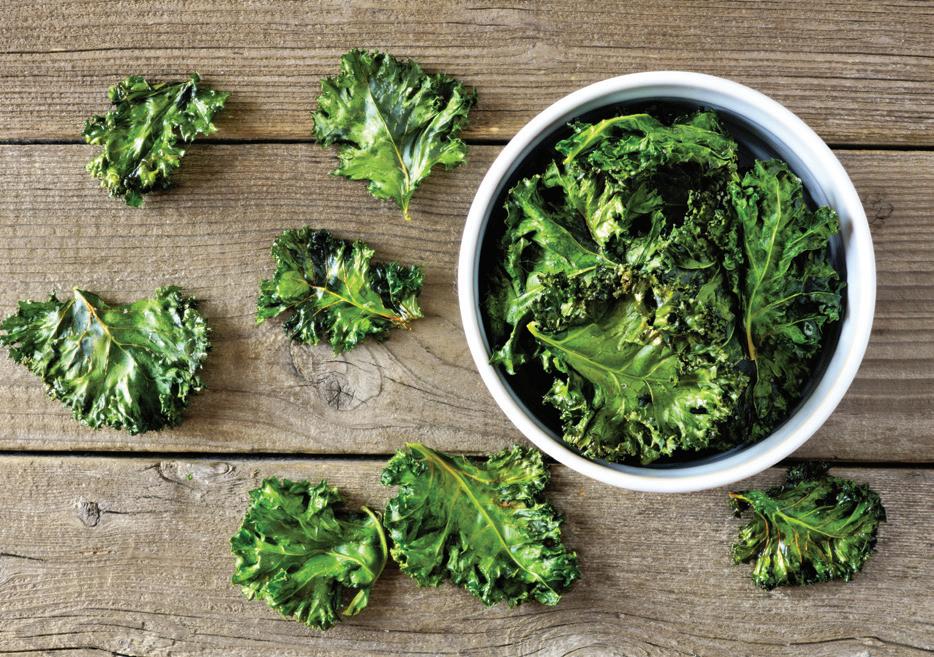
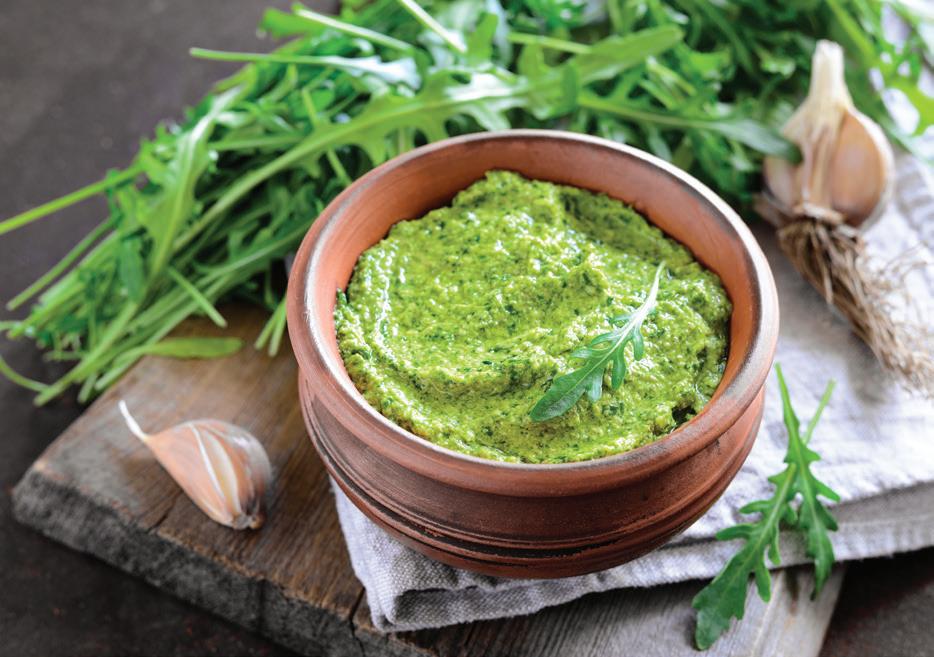
Homemade, oven-baked kale chips are a healthy alternative to potato chips and a great way to get your greens. Simply tear a large handful of fresh kale into pieces, toss in a bowl with olive oil and sea salt, and bake at 300° F for 15 to 20 minutes, until crispy—watch carefully so they don’t burn.
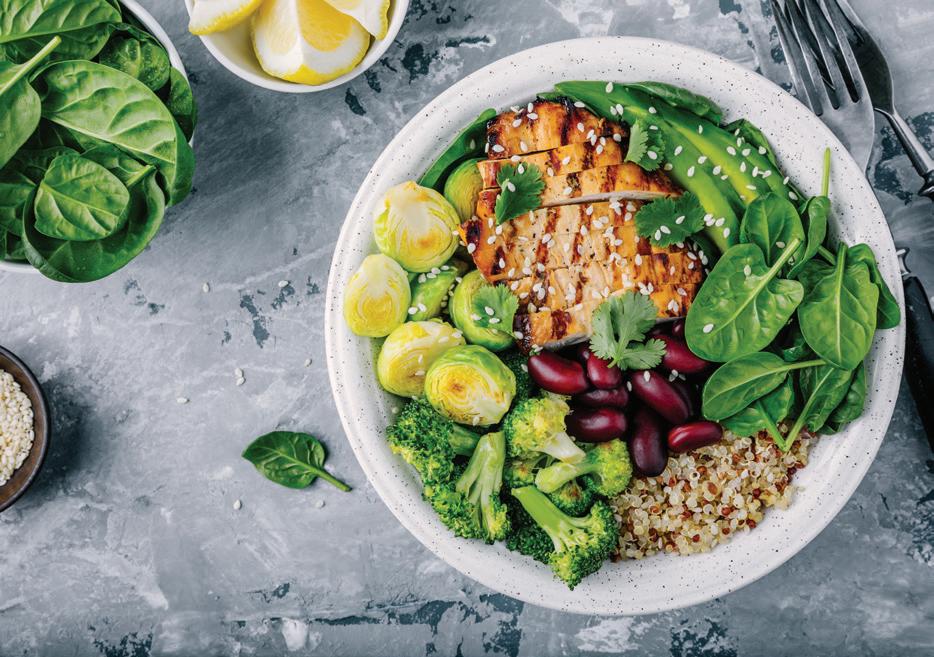
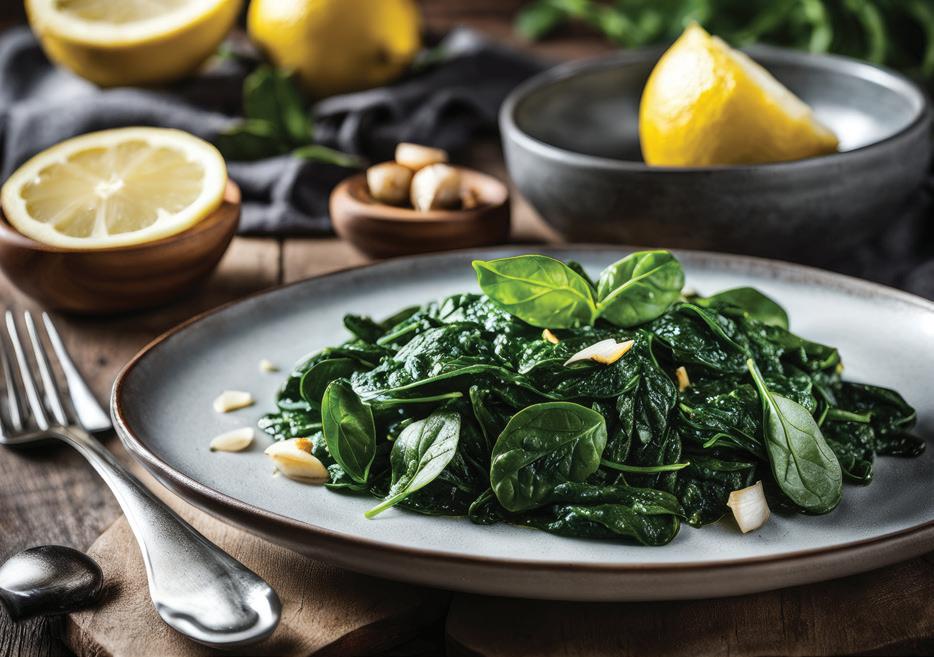
If you want to pack leafy greens into a filling, nutritious meal, bowls are your best friend. Whether you know them as grain bowls, Buddha bowls, power bowls, or something else, these one-dish meals usually consist of grains, veggies, protein, and sauce. They can take on a variety of flavor profiles and can easily be made vegan or gluten free.
When you saute your favorite leafy greens, they can be served alongside any kind of protein, incorporated into a pasta dish, thrown on a breakfast sandwich, or folded into an omelet. Add some olive oil, lemon juice, garlic, and other seasonings to spice up the flavor.

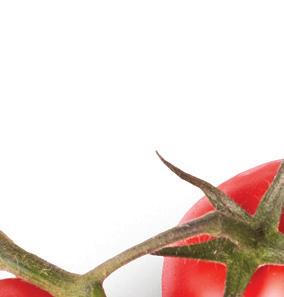




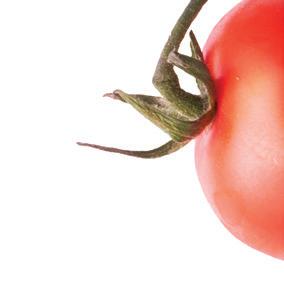
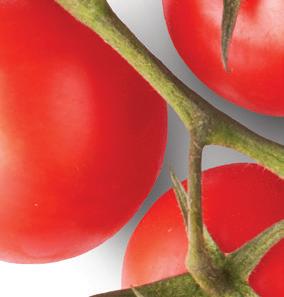
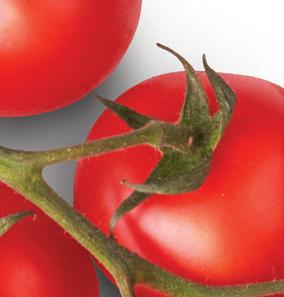


by mary subialka







very year, around 30,000 folks gather in the streets of Bunol, in the Valencia region of Spain, to pelt one another with juicy red orbs during La Tomatina festival, a giant tomato fight held annually in August. (This nearly 80-year tradition is scheduled for Aug. 28, 2024, if Spain is in your summer travel plans.) But, we encourage celebrating prime tomato season with a bit more restrained respect for this delicious and healthy fruit. Yes, botanically speaking, the tomato is a fruit, which is the edible part of a plant that contains the seeds. But it was classi ed—a er some debate—as a vegetable by the U.S. government in 1893. Whether you want to call it a fruit or veggie, there’s no doubt it’s packed full of nutrients. Tomatoes are a good source of ber, are rich in vitamin C, and contain vitamins A and B, and potassium. They are also a very good source of lycopene, an antioxidant that may help reduce the risk of heart disease and some forms of cancer.

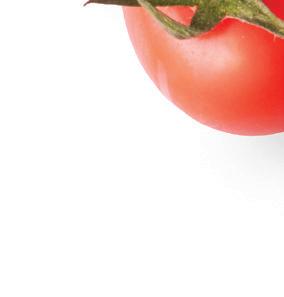

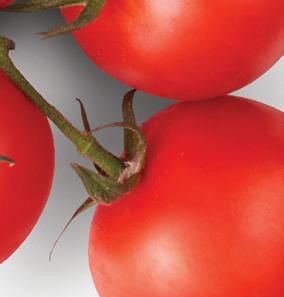




Peak season for domestic fresh tomatoes is June through September and the perfect time to get your hands on some of these delicious fruits—just don’t throw them at anyone. They are much be er either enjoyed on their own as a healthy snack (1 cup of cherry tomatoes, about 9 or 10, depending on size, packs a nutritional punch but has only about 27 calories). They are the base of many delicious pasta sauces when pureed, of course, or cut cherry tomatoes in half and add color and avor to stir-fry and pasta dishes. Grill them on skewers or quickly saute them with herbs or roast them for a delicious side dish. They are delicious added to salads, such as the recipe on the next page, and as appetizers such as brusche a and cheesy tarts.
There are numerous tomato varieties, but they fall into these general categories, and can be enjoyed raw or cooked:
■ beefsteak is the largest tomato, which can easily weigh 2 pounds or more. Round and slightly pumpkin-shaped, its flavor balances sweetness and acidity.
■ g lobe is medium size, firm, and juicy. Many of the large-scale commercial tomatoes are in this category.
■ p lum , also called Roma or Italian plum, is egg shaped and either yellow or red. They’re not as sweet and acidic as beefsteak or globe. With lower water content and fewer seeds, plum tomatoes are a good choice for cooking and canning. The tiny grape tomato is a hybrid Roma tomato.
■ c herry, which are about 1 inch in diameter, may be red, orange, green, or yellow, and are generally a bit sweeter than beefsteak or globe tomatoes. They are good fresh out of hand, in salads, or quickly sauteed. The yellow pear tomatoes are slightly smaller than cherry and shaped like a pear or teardrop. They are best eaten raw but can be cooked briefly.
temperature tip
Don’t refrigerate tomatoes (unless they’ve been cut). Store them at room temperature away from sunlight and use within a few days. Cold temperatures stop the ripening process, dull the flavor, and can make the flesh pulpy. Once fully ripe, tomatoes can be refrigerated for a few days, but any longer will cause their flavor to deteriorate.
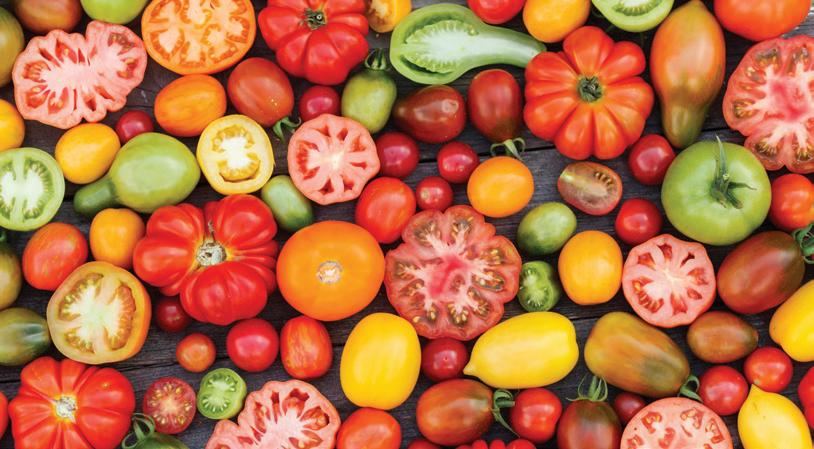
what are heirloom tomatoes?
These tomato varieties from perhaps as far back as the debated fruit/veggie classification have created a buzz. Known as heirloom, the seeds for these plants have been handed down for generations or were grown commercially before modern hybrids. Some schools of thought say seeds for these plants must be more than 100 years old, others say 50 years, and yet others say they must be from before 1945, which is around the time widespread hybrid use by growers and seed companies began.
Heirloom tomato varieties vary widely in color, shape, and size. They sport a colorful rainbow of skins—from bright yellow, dusky pink, or striped orange and green to a deep, almost bruised color—over equally colorful flesh that ranges from light red to deep red or brownish purple.


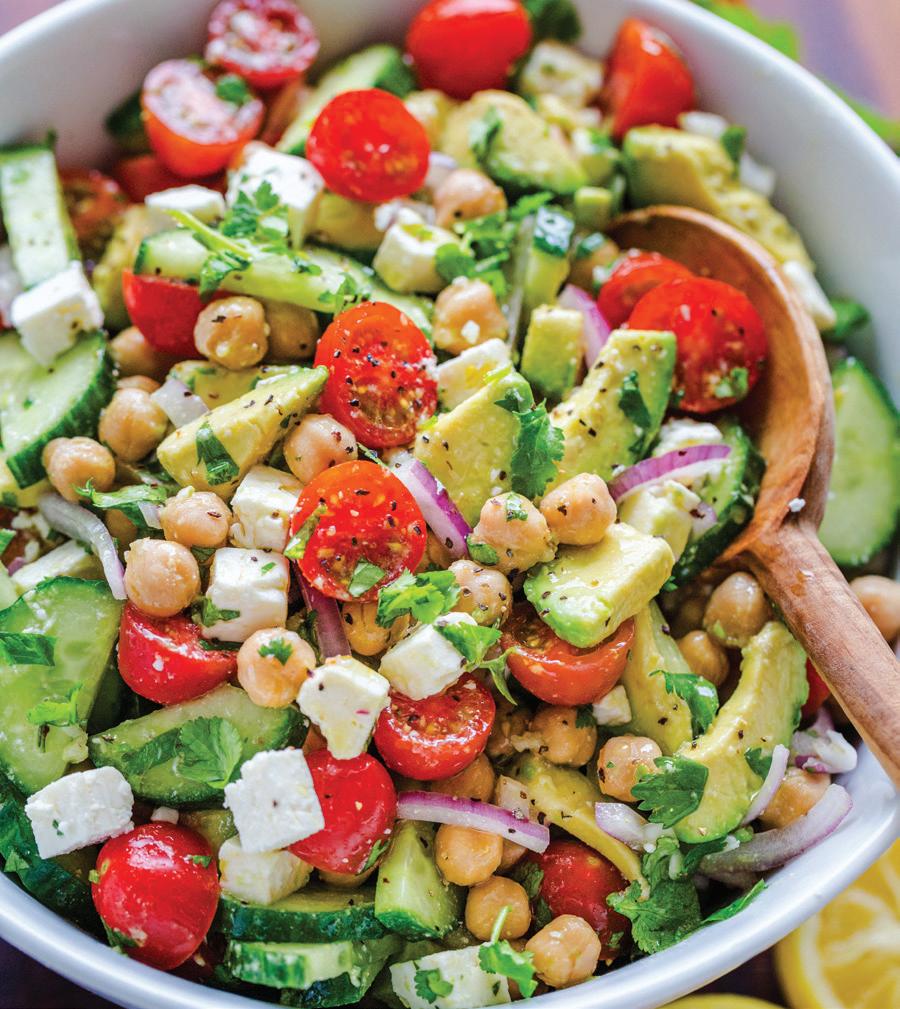
Juicy tomatoes are mixed in this fresh salad that is loaded with crisp cucumbers, creamy avocado, feta cheese, and chickpeas. It’s fresh, healthy, and protein packed.
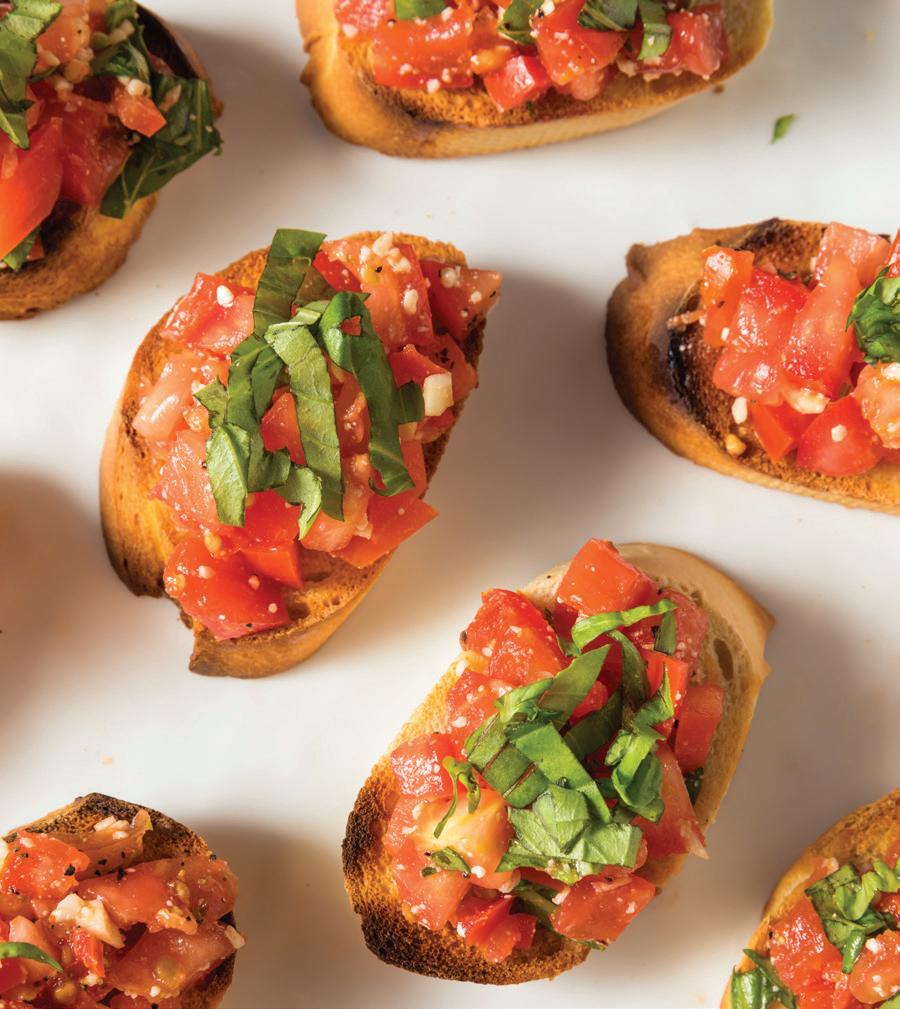
It’s easy to make this delicious, classic Italian appetizer at home. Toasted bread is topped with tomatoes, garlic, and fresh basil, and variations include Parmesan cheese and balsamic vinegar.
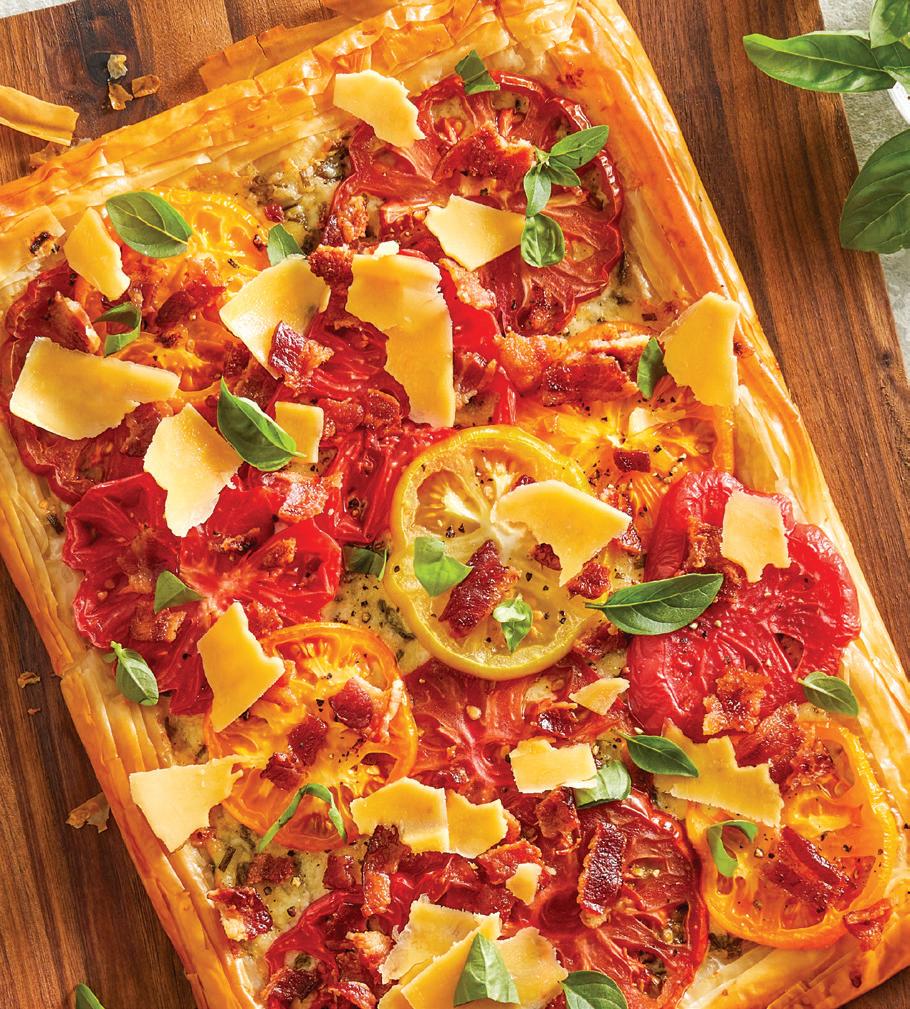
This savory tart showcases your choice of sliced heirloom tomatoes with melty cheddar cheese and is topped with smoky bacon.
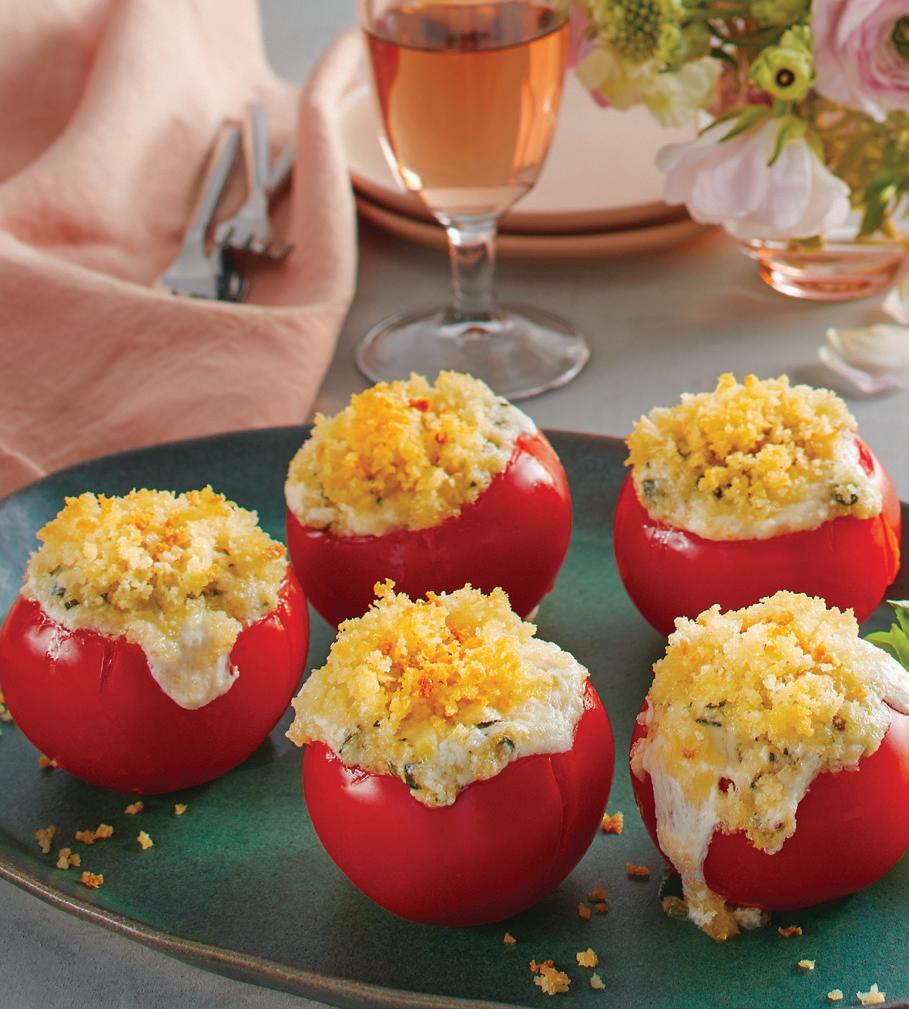
Melty mozzarella and creamy mascarpone cheeses combine to make these delectable bites.
12 ounces firm heirloom tomatoes, cut into 1/4-inch slices
Salt and pepper, to taste
2/3 cup mayonnaise
1/4 cup minced fresh basil, plus more for garnish
1 large shallot, chopped 11/2 tablespoons snipped fresh chives
3 ounces WI aged cheddar cheese, shredded (3/4 cup), plus more to top
10 (14 x 9-inch) sheets phyllo dough, thawed
4 tablespoons butter, cubed and melted
4 thick-cut bacon strips, cooked and chopped
1. Line a baking pan with 3 paper towels, arrange tomato slices in a single layer on top, and sprinkle with salt. Let stand for 30 minutes, flipping slices halfway. Pat dry. Then heat oven to 425°F.
2. Combine the mayonnaise, basil, shallot, and chives in a bowl. Stir in cheddar. Lightly season with salt and pepper.
3. Line a 17x12-inch baking pan with parchment paper. Unroll phyllo sheets; keep covered with plastic wrap and a damp towel. Place 1 phyllo sheet on prepared pan. Lightly brush with butter. Layer 9 more phyllo sheets; lightly brush each sheet with butter. Fold in sides, 3/4-inch toward center, forming a rim. Spread cheddar mixture in the center within the edges. Bake 7 to 8 minutes or until pastry is slightly puffed. Top with tomatoes. Lightly season with salt and pepper. Bake 8 to 10 minutes more or until pastry is light golden brown. Let stand for 5 minutes. Sprinkle with bacon, more cheddar, and garnish with basil.
✁
MAKES 8 SERVINGS | RECIPE COURTESY WISCONSIN CHEESE
8 medium tomatoes
1 container (8 ounces)
Crave Brothers
Farmstead Classics
Mascarpone cheese
1 cup panko breadcrumbs, divided
1/2 cup chopped fresh basil
2 garlic cloves, minced
2 teaspoons fresh lemon zest
Salt and pepper, to taste
6 ounces Crave Brothers Farmstead Classics Fresh Mozzarella cheese, torn
2 tablespoons butter, cubed and melted
1. Grease grill grate. Heat grill to medium. Cut a thin slice off the top of each tomato. Scoop out and discard pulp, leaving a 1/2-inch shell. Invert tomatoes on paper towels to drain.
2. Combine the mascarpone, 1/2 cup breadcrumbs, basil, garlic, and lemon zest in a large bowl. Season with salt and pepper to taste. Gently fold in mozzarella.
3. Season tomatoes with salt and pepper to taste. Spoon mascarpone mixture into tomatoes. Combine butter and remaining breadcrumbs in a small bowl; sprinkle over tops. Transfer tomatoes to a lightly greased grill grid.
4. Grill tomato es, covered, over medium heat for 14 to 16 minutes or until heated through. Cool slightly before serving.
for the dressing
3 tablespoons extra virgin olive oil
3 tablespoons lemon juice, from 1 large lemon
1 garlic clove, pressed or minced
1/2 teaspoon sea salt, or to taste
1/8 teaspoon black pepper
11/2 cups cherry tomatoes, halved
1 English cucumber, halved and sliced
1 (15-ounce) can chickpeas/ garbanzo beans, drained and rinsed
1/2 medium red onion, thinly sliced
1 avocado, sliced
1/4 cup cilantro, chopped
4 ounces feta cheese, diced
1. For the dressing, in a small bowl or Mason jar, combine the olive oil, lemon juice, garlic, salt, and pepper and whisk to combine (or shake them together if using a jar).
2. In a medium bowl, combine the cherry tomatoes, cucumber, chickpeas, onion, avocado, cilantro, and feta cheese. Add the dressing to taste and toss gently to coat.
MAKES ABOUT 8 SERVINGS
1 loaf baguette, ciabatta, or sourdough bread, cut into 1/4-inch slices
1 tablespoon extra virgin olive oil, plus 2 teaspoons
8 Roma tomatoes, diced ⅓ cup chopped fresh basil
1. Heat oven to 400°F.
1 ounce Parmesan cheese, freshly grated
2 cloves garlic, minced
1 tablespoon balsamic vinegar (optional)
¼ teaspoon kosher salt
¼ teaspoon freshly ground black pepper
2. Brush each side of bread slices lightly with the 1 tablespoon oil and place on large baking sheet. Toast bread about 5 to 10 minutes, turning halfway, until lightly brown and crisp. Optionally, when toast slices are warm, rub with cut surface of a garlic clove for extra flavor.
3. Meanwhile, toss together tomatoes, basil, Parmesan cheese, and garlic in a bowl. Mix in balsamic vinegar (if using), 2 teaspoons olive oil, salt, and pepper.
4. Spoon tomato mixture onto toast slices and serve immediately, or set out the bowl and let guests serve themselves.
Cook’s Note: The tomato mixture can be made ahead a few hours before serving. To avoid the tomatoes giving off too much juice as they marinate, hold off on adding the salt until right before serving. You can use a slotted spoon for serving and save the liquid for people who like to dip into it with extra bread.
LOCATIONS
BLUE BELL, PA
wine & beer available! 1301 Skippack Pike 215-437-3200
DOYLESTOWN, PA
Simply Fresh By McCa rey’s 200 West State St. 215-348-1000
GLADWYNE, PA 1025 Youngs Ford Road 484-229-2777
NEW HOPE, PA
wine & beer available! 300 West Bridge St. 267-741-8001
NEWTOWN, PA
wine & beer available! 2890 South Eagle Road 215-579-1310
YARDLEY, PA 635 Heacock Road 215-493-9616
PRINCETON, NJ
wine, beer & spirits available! 301 North Harrison St. 609-683-1600
WEST WINDSOR, NJ
wine, beer & spirits available! Princeton-Hightstown Road and Southfield Road 609-799-3555
FARM-FRESH FOODS
McCa rey’s brings you the freshest variety of foods—frequently from our own backyard! Look for our locally grown seasonal produce. You’ll love its superior freshness.
CHEF’S KITCHEN
Shopping for dinner at McCa rey’s is like having a personal chef. Find just the right meal for you and your family in our Prepared Foods Department, including our Gourmet To Go family meals.
GOURMET CATERING
McCa rey’s is your best choice for elegant, in-home dining and entertaining. Using only the highest quality, freshest ingredients, our professional catering sta guarantees delicious and elegant food you can serve with absolute confidence.
If you would like to discuss your catering needs or meet with us personally, we are available Monday to Friday 9 a.m. to 5 p.m., Saturday 9 a.m. to noon and by appointment. Please call our Catering Planners at 1-800-717-7174. mccaffreys.com

Imagine a beautiful summer day with a cool breeze, enjoying delicious food with the people you love. While this sounds lovely, it does take a bit of planning. The secret to a perfect barbecue is to keep it simple. Sometimes less is more. If you want to host your entire neighborhood, call our catering coordinators: 800-717-7174. And, if you want to win this year’s barbecue competition, don’t drown your barbecue in salty sauces, sugary condiments, or heavy dressings! Get inspired for a great grilling season with these simple tips, recipes, and fresh ingredients from McCaffrey’s:
■ Enjoy Seasonal Produce: Try grilling sliced apples, pears, pineapple, halved bananas, figs, nectarines, peaches, or plums. Incorporate peak season produce, like berries, mangos, and kiwi, into everything—from appetizers through desserts.
■ Include Sides and Salads: Accompany healthy and delicious barbecue foods with crowd-pleasing salads and plant-based creations. For salad recipes, try our Creamy Red Potato Salad with Capers and Dill (page 23) and our Summer Succotash Salad (page 27). For vegan recipes, try Smoked Sweet Potato Burnt Ends (page 49) and Smoked Mac ‘n’ Cheeze (page 50).
■ Elevate your Main Course: Whether it’s flank steak, pork ribs, vegan brats, or fish, we have the recipe for you, like Spice-Rubbed Flank Steak with Smoky Butter Sauce (page 27) or Coconut Poached Shrimp and Fish with Asian Greens, Grapefruit Dressing, and Sticky Chili Cashews (page 41).
BTW—our fish mongers can skin and portion your fish selections while you shop! Just ask!
■ Savor Sweet Endings: Dessert is a must at any barbecue. A colorful fruit platter or fruit salad is sure to satisfy. Check out some fun and healthy dessert ideas using seasonal fruit, like this recipe for Lemon Mousse with Fresh Berries (page 29).
Thanks for picking up this summer’s edition of Real Food magazine. Please enjoy your grill, friends & family, and McCaffrey’s all summer long.
James J. McCa rey III president
James J. McCa rey IV executive vice president


Cheese is delicious anytime of year, of course, and during the summer months, it’s a great addition to meals including crisp green salads, pasta salads, and on charcuterie boards alongside fresh seasonal fruit. You’ll find a wide selection of cheeses in our deli department from local to global delights. Stop in to peruse our selection, and our staff is happy to answer any cheesy questions you might have. Here are highlights of just some of the many cheeses we carry, along with serving suggestions.
Fresh mozzarella, burrata, and feta cheeses add creamy touches to summer meals
Fresh mozzarella was first made near Naples, Italy, from the rich milk of water buffalos, which accounts for the name of one variation, bufala di Mozzarella or “buffalo mozzarella.” Most fresh mozzarella is now made from cow’s milk, both in Italy and here in North America. It has a delicate, milky flavor and is softer than its pizza-topping sibling. It’s made into balls, logs, and small nuggets (about 1 inch in diameter), which are known as bocconcini (pronounced bohk-kohn-CHEE-nee). There are even smaller spheres called “pearls.” Due to its high moisture content, fresh mozzarella is often kept in brine or water to retain moisture and shape and it is also sold in vacuum-sealed packages. Keep it in its liquid bath until ready to eat.
Burrata is a fresh cheese made with cow’s milk that originated in the Apulia region of Italy. At first glance it might look similar to a ball of fresh mozzarella, but what is on the inside sets it apart. Burrata, meaning “buttery” in Italian, has an outside thin shell made of mozzarella and contains a soft mixture of fresh cream and shreds of mozzarella inside. When you cut open burrata, it oozes with buttery and creamy rich flavor. Keep refrigerated, but if you want to serve it at room temperature, remove it at least half an hour before serving. Once opened, it is best to use within one to two days. Do not freeze.
Both fresh mozzarella and burrata cheese are delicious with ripe tomatoes, basil, and crusty bread with a light drizzle of olive oil. They make delicious additions to salads. Try in mixed greens with strawberries, cucumbers, walnuts, and dried cranberries topped with grilled chicken and dressed with raspberry vinaigrette. Add pieces of burrata, bocconcini, or
sliced fresh mozzarella to a cucumber and radish salad or serve with grilled peaches. Also enjoy each with roasted peppers, cured meats, melon, grapes, and light wines. Jazz up avocado toast by spreading burrata or slices of mozzarella on toast and topping with avocado slices and fruit such as strawberries and a little basil and drizzle with balsamic vinegar and sprinkle with sea salt. Layer melon and grilled asparagus atop a large slice of fresh mozzarella or alongside burrata and sprinkle with coarse salt and pepper.
Bocconcini is a quick and easy appetizer on its own marinated in plain or herbed olive oil. The little nuggets are also perfect for many combinations on skewers: alternate with cherry or grape tomatoes and basil for a caprese salad on a stick; try melon, mozzarella, and prosciutto or other ham; or alternate with cubes of salami and cherry tomatoes sprinkled with seasoning of choice.
Feta is tangy and can range from moderately creamy to crumbly. It doesn’t have a rind or outer hard layer and can dry out and sour quickly so should be stored refrigerated, in its brine until used. Feta should be white—if it’s a bit yellow, that means it has been exposed to air outside of the brine. You might want to rinse it before serving to remove some of the saltiness. Use within a few days after purchasing. For best flavor, serve at room temperature.
Feta makes a zesty addition with fresh summer fruit such as cantaloupe and watermelon, and is great crumbled over salads or with sliced tomatoes sprinkled
with olive oil and fresh herbs. Enjoy feta in tomato-based pastas, omelets, in sandwiches, and more. (It’s not a “melting” cheese; it softens, retaining much of its original shape.) Serve as an appetizer with vegetables, ham, salami, and pickled or dried fish. Try a thin slice atop a beef burger; serve with a squeeze of lemon juice and a sprinkle of oregano for a Greek twist to a summer classic.
Cheddar is a favorite cow’s milk cheese whether you like mild or sharp flavor. The age or degree of curing is very important in making cheddar: Some is aged only a few months, while others are aged up to six years or more. As cheddar matures, it loses moisture, and its texture becomes drier and crumbly. The flavor also takes on a “bite” or sharpness, which is the result of increased levels of salt and acids that naturally intensify during the aging process. If the cheese is aged 12 months (called “old” or “sharp”) the sharpness becomes very noticeable, and at 18 months (“extra old” or “extra sharp”) it overtakes the typical cheddar flavor. Premium aged cheddars begin at two years of aging and are increasingly sharper, saltier, and crumblier. Cheddar made in the United States may be labeled “mild,” “medium,” or “mellow,” and “aged” or “sharp.” English cheddar often is “mature,” “extra mature,” and “vintage.” And Irish cheddar may be labeled simply “aged” or “vintage,” which is a term used for cheddars aged 12 months or more.
When selecting cheddar, consider how you plan to use it. The younger or moderately aged cheddars may be a good choice for everyday use, such as in sandwiches, sauces, on vegetables, and atop cheeseburgers. A 5- or 6-year-old cheddar may be a good choice for a cheese course when entertaining—or just to savor on its own. Cheddar is best served at room temperature to help bring out the flavor— about 20 minutes to an hour out of the fridge should do the trick.
Parmesan and Asiago are often used to top pasta, but the bold bite of these cheeses can be delicious alongside fruit and other items on a charcuterie board. Medium to aged varieties make a great snack paired with fruit and nuts. Cube it to use in salads or enjoy by itself.
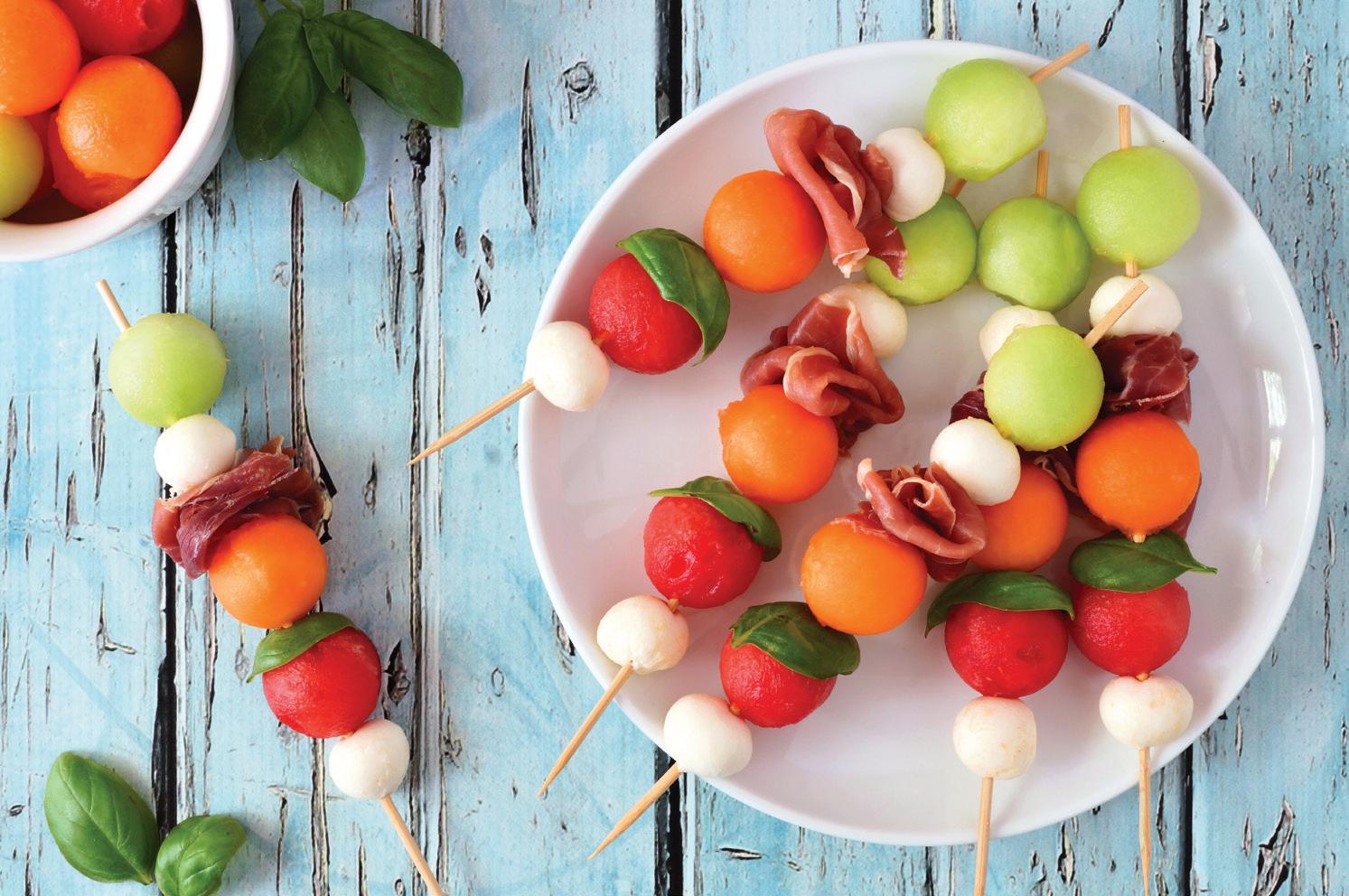
The produce aisles are brimming with a great selection of fruit during the summer. So now is the perfect time to pick up a delicious variety of juicy berries, stone fruits, melons, tropical treats, and more to serve alongside savory cheese and other dishes. Fruit is naturally fat-free, a good source of dietary fiber, vitamin C, folic acid, and antioxidants that may help reduce the chances of heart disease and some cancers.
Blueberries are one of the few fruits native to North America. They were an important part of the diet and culture of Native Americans long before the Pilgrims landed on Plymouth Rock. Today, North America is the world’s leading blueberry producer.
Fun Fact: The characteristic dusky white/silvery coating, known as bloom, is a natural coating that helps protect the berries from the sun and is a sign of freshness, not decay. In fact, if they don’t have much of this bloom, it could mean they were overhandled and may be a bit mushy.
Cherries: The season for fresh cherries runs May through August, so get them while you can. Distant cousins of plums, there are two main groups of cherries—sweet and sour. Sweet cherries, the larger of the two, are firm and somewhat heartshaped. The most familiar and popular type of sweet cherry is Bing, which is dark red to purplish-black in color when ripe. Another popular sweet cherry, Rainier, is a golden yellow color with a red blush. Tart cherries are not usually eaten out of hand but used in desserts, jams, juice, and dried.
Fun Fact: On average, there are 65 cherries in 1 pound. Ripened on the tree, cherries are generally harvested, packed, and on the store shelf within two days.
Melons belong to the gourd family, which includes squash and pumpkin, and are divided into two broad categories—muskmelon (including Cantaloupe, Casaba, Crenshaw, and Honeydew) and watermelon. Many melons are available year-round, but the peak season is late summer to early fall.
Fun Fact: Watermelon is made up of 92% water.
Tip: Wash melons with cool water before cutting to remove any impurities that might be on the rind and could be transferred from the knife to the flesh when cut.
Strawberries, second only to blueberries in antioxidant levels, also have more vitamin C than other berries. A 1-cup serving—about eight whole berries—has only 50 calories and fulfills the recommended value of vitamin C for an entire day.
Fun Fact: Nearly 90% of America’s strawberries are grown in California and, depending on the weather, peak strawberry season in the Golden State begins in early spring and runs all the way to fall.
Tips: Refrigerate berries as soon as possible in the original clamshell or layer in a container lined with a paper towel. Keep dry and refrigerated since moisture can hasten their decay. Wash them just prior to use under cool running water.

It’s prime grilling season, and it’s hard to beat sizzling steak, pork chops, or chicken off the grill. While most cuts can taste great with just a pinch of salt and pepper, it’s always fun to explore variety and boost flavor with savory rubs and marinades. They can take your meat’s flavor to new heights.
Beef
Elevate your grilling game this season with these tips and recipes from Beef, It’s What’s For Dinner.
cuts
The different cuts of beef are as varied as the ways to prepare them. Before you fire up the grill, look for the perfect cut for this type of preparation. Some of the best cuts for grilling include strip (including filet mignon), flank, and rib-eye. Steaks with the bone in are good for grilling because they retain flavor. Also look for brisket, short loin, sirloin, chuck eye, and flat iron.
marinade tips
Marinades are beneficial in two ways: They add flavor or tenderize. A key is the length of marinating time. If you’re just looking to add flavor, you only need to marinate for 15 minutes to 2 hours. If you’re looking to tenderize cuts, you’ll want to marinate for 6 to 24 hours. Time also varies by cut: For tender beef cuts like rib or sirloin, marinate
for 15 minutes up to 2 hours. For less tender beef cuts like round, marinate for 6 to 24 hours. In addition, marinades with little or no sugar may help protect meat from charring and have also been shown to reduce HCA formation.
keep in mind these tips:
n Always marinate in the refrigerator, not at room temperature.
n Allow ¼ to ½ cup of marinade for every pound of beef.
n Marinate in a food-safe plastic bag or in a non-reactive container such as glass or plastic. Turn or stir the beef occasionally to allow even exposure to the marinade.
n Sugary sauces and glazes can burn easily. If using these types of products, baste during the last few minutes of grilling to avoid charring.
n If a marinade is to be used for basting or as a sauce, reserve a portion of it before adding to the beef. Marinade that has been in contact with uncooked meat must be brought to a full rolling boil for at least 1 minute before it can be used for basting or as a sauce.
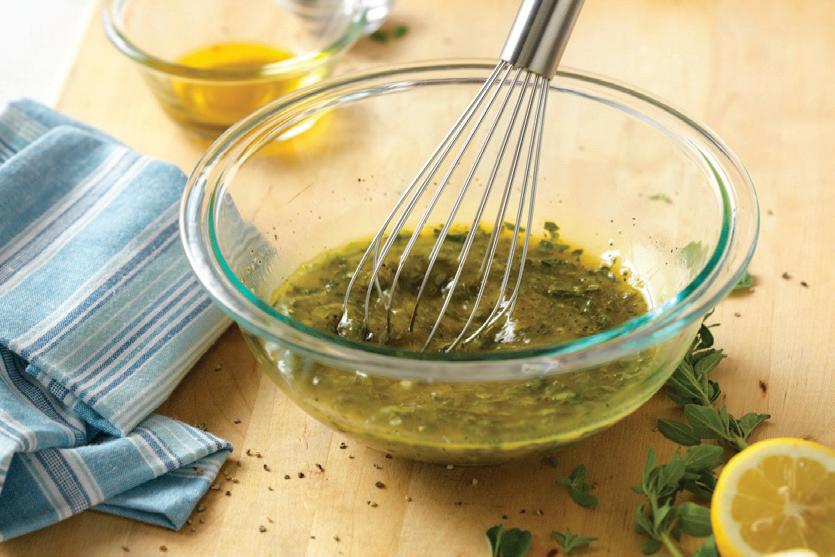
MAKES ABOUT 2 SERVINGS
RECIPE COURTESY BEEF, IT’S WHAT’S FOR DINNER
Whip up this simple and flavor-packed marinade in minutes.
1/3 cup olive oil
1/4 cup chopped fresh oregano or 1 tablespoon dried oregano leaves
1/4 cup fresh lemon juice
1 tablespoon freshly grated lemon peel
4 teaspoons minced garlic
1 teaspoon pepper
1. Combine all ingredients in medium bowl. Place beef steak(s) and marinade in food-safe plastic bag; turn steak(s) to coat. Close bag securely and marinate in refrigerator 15 minutes to 2 hours for tender steaks; 6 hours or as long as overnight for less tender steaks, turning occasionally.
2. Remove steak(s) from bag; discard marinade. Place steak(s) on grid over medium, ash-covered coals or over medium heat on preheated gas grill. Grill 9 to 14 minutes to desired doneness; 145°F for medium rare to 160°F for medium doneness, turning occasionally.
3. Before serving, carve steaks into slices and season with salt and pepper, as desired. Cover and refrigerate any remaining meat for later use.
Rubs are seasoning blends applied to the surface of roasts, steaks, and burgers. These quick mixtures add flavor to beef, but do not tenderize. Dry rubs consist of herbs, spices, and other dry seasonings. Pastetype rubs, which are perfect for roasts, contain small amounts of wet ingredients, such as oil, crushed garlic, or mustard. Rubs can be applied just before cooking or up to 2 hours in advance and refrigerated until cooking time. Simply combine the ingredients and apply evenly to all surfaces and then cook beef to desired doneness. For a 1-inch-thick rib-eye steak, for example, you’ll grill from 9 to 14 minutes for medium-rare (145°F) to medium (160°F) doneness.
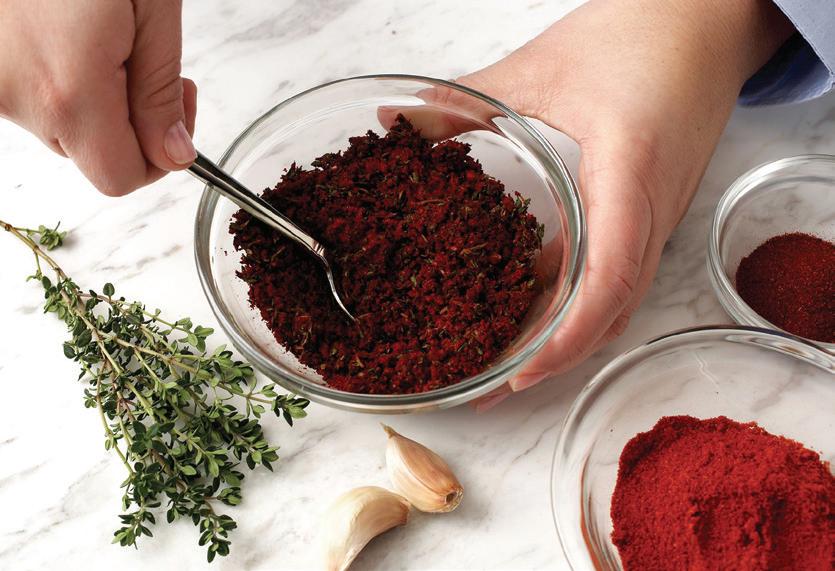
MAKES ABOUT 4 SERVINGS RECIPE COURTESY BEEF, IT’S WHAT’S FOR DINNER
Try this spicy rub and seasoning mix that’s perfect for roasts, steaks, and burgers.
Combine 3 tablespoons chili powder, 2 teaspoons ground cumin, 11/2 teaspoons garlic powder, 3/4 teaspoon dried oregano, and 1/2 teaspoon ground red pepper and store in an airtight container. Shake before using.
grilling tips
n Remove the steak from the refrigerator about 20 minutes prior to grilling, allowing it to warm up a bit. Use this time to let the grill heat up. It is best to trim visible fat before grilling to prevent flare-ups. If in a marinade, pat the meat dry with a paper towel to promote even browning and prevent steaming.
n Use medium heat while cooking to ensure delicious, flavorful meat. High heat can overcook or char the outside of meat while the interior remains underdone. Once you begin grilling, let the steak develop a seared crust before flipping it.
n Since beef is cooked to preferred levels of doneness, it’s best to measure the internal temperature to achieve desired results. Reach 145°F for medium-rare, 160°F for medium, and 175°F for well done. For medium-rare (145°F), 1-inch cuts of each take 11 to 15 minutes, 16 to 21 minutes, and 9 to 14 minutes, respectively.
n For a cooking style that requires less attention, try indirect grilling, which positions the meat on the grill rack to the side of the heat rather than directly over it. Keeping the lid closed lets the grill cook like an oven from all sides. Good cuts for this method include rib-eye petite roast, strip petite roast, and top sirloin petite roast. Season beef with preferred herbs and spices. Prepare the grill (gas or charcoal) for indirect cooking according to manufacturer’s directions for medium heat. For charcoal grilling, position an aluminum drip pan in center under cooking grid to catch meat juices and divert heat. Place meat on grill and cover with the lid. Let cook 40 to 80 minutes, (depending on cut and size), turning once. When desired internal temperature is reached, tent meat with aluminum foil on a cutting board for 10 to 15 minutes to preserve juices before serving. Season with salt after carving, as desired.

MAKES 4 SERVINGS
RECIPE COURTESY BEEF, IT’S WHAT’S FOR DINNER
Just when you thought grilled sirloin kebabs couldn't get better, this recipe goes to new heights with a garlic rosemary butter sauce.
for the basting sauce
4 tablespoons butter 11/2 teaspoons minced garlic
2 teaspoons fresh parsley
1 teaspoon fresh rosemary
1 pound (1-inch-thick) boneless beef top sirloin steak
1 tablespoon steak seasoning blend
1 tablespoon olive oil
8 ounces red-skinned potatoes
4 ounces cherry tomatoes
4 ounces portobello mushrooms
1 teaspoon fresh parsley, for garnish
1 teaspoon fresh rosemary, for garnish
1. Make the basting sauce: In a small saucepan combine butter, parsley, garlic, and rosemary. Melt butter mixture over low heat either on the stovetop or on your grill until melted, stirring occasionally. Set aside.
2. Cut potatoes into 11/2-inch pieces. Place in microwave-safe dish and cover with vented plastic wrap. Microwave on high 6 to 8 minutes or until just tender, stirring once. Cool slightly.
3. Cut beef into 11/4-inch pieces. Combine beef, mushrooms, tomatoes, potatoes, olive oil, and steak seasoning in a large bowl and toss. Alternately thread beef and vegetables onto metal skewers.
4. Place kebabs on grid over medium, ash-covered coals. Grill, 9 to 12 minutes (over medium heat on preheated gas grill, 8 to 10 minutes) for medium-rare (145°F) to medium (160°F) doneness, turning once and brushing with sauce during last 5 minutes. Remove from grill and brush with remaining sauce. Garnish with remaining rosemary and parsley mixture.
Cook’s Note: Thread steak pieces onto skewers leaving small spaces between them. Loose or tight spacing can cause beef to cook unevenly.

Like beef, many different cuts of pork are available for grilling—pork chops, ribs, loin, sausage, and tenderloin are good choices. In general, pork chops take 8 to 9 minutes to grill, and pork should reach an internal temperature of 145°F to be done, followed by a 3-minute resting period before serving. Do not pierce pork with sharp utensils before or while cooking, as it can cause the meat to lose juice and therefore flavor. Bone-in selections often yield a juicier and more flavorful product.
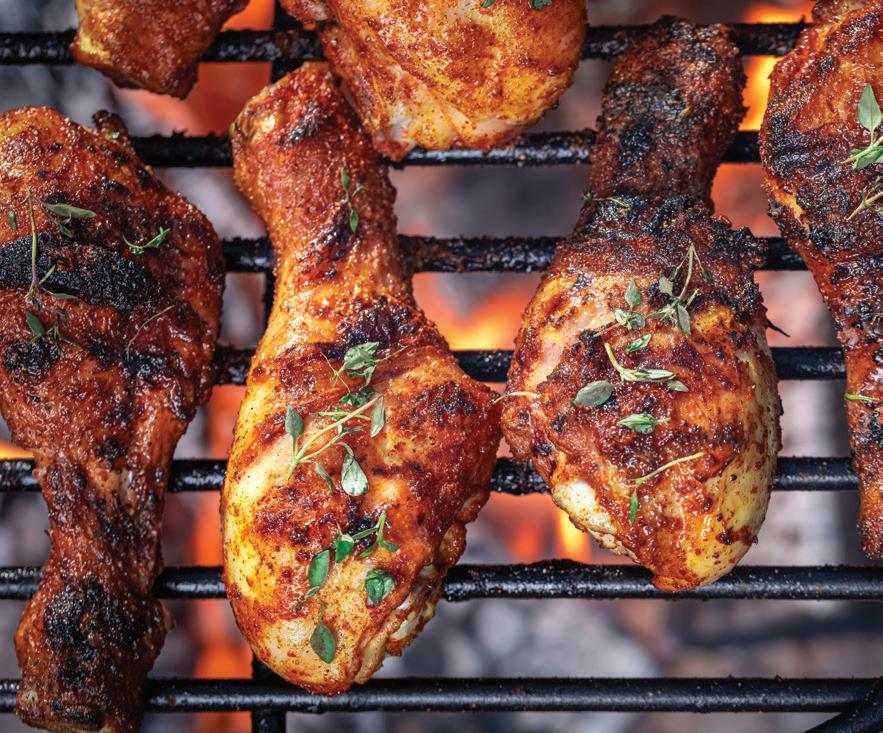
Chicken is especially popular for grilling since it absorbs other flavors easily. Marinate for 20 minutes up to 2 hours. You can pierce the meat for even more flavor absorption. Leaving the skin on the meat (even if removed before eating) makes it juicier, since it holds in the flavor. Chicken is typically done when it reaches an internal temperature of 170°F. Thighs and drumsticks take twice as long as wings and breasts, approximately 30 minutes versus 10 to 15.

Get grilling with healthy seafood
Summer is the perfect time to get more creative with your healthy meals, so make sure to include fish in your protein choices. It’s low in fat but also rich with omega-3 fatty acids and vitamins B and D. But not only is it good for you, grilled fish can make a tasty meal—and it’s easier to do than you think. Here are some tips and tricks to help your seafood grilling go swimmingly this season.
Rubs and Marinades
Rubs and marinades are great ways to add flavor and spice to any fish dish. For a rub, blend your favorite spices together—basil, lemon, parsley, dill, smoked paprika are some ideas—then coat fish generously before grilling to add life to fish tacos, Indian-inspired fish dishes, or a Mediterranean salad.
Marinate in any container except one made of uncoated cast iron or aluminum, which can react with acids and develop off flavors. Limit the marinating time for seafood portions to a maximum of 45 minutes, otherwise the proteins could start to break down if left in many marinades longer.
One of the simplest but most delicious ways to complete grilled seafood is to use a flavored butter. They can be made ahead of time and stored in the refrigerator for 3 days or kept in the freezer for up to 3 months.
To make flavored butters, soften the butter by beating it for 1 to 2 minutes with an electric mixer or by hand with a wooden spoon. Stir in your favorite flavoring ingredients, such as chives, lemon, or ginger (be sure herbs are cool if any have been cooked). Cover and refrigerate or roll into logs, wrap tightly in aluminum foil, and freeze for later use.
If using frozen butters directly from the freezer, soften them just a bit before placing them on top of your grilled foods so that they can begin to melt as you bring them to the table.
grilling tips
n Oil grill then cook fish skin side down first, which protects it from burning and drying out—and can add natural oils to the grill to help it from sticking when flipped.
n Fish cooks best over medium to medium-low heat.
n Cut large fish steaks or fillets into meal-sized portions before grilling so they will be easy to turn over on the grill.
n If fish is frozen, rinse the frozen side to remove any ice flakes and pat dry with a paper towel.
n Firm fish (tuna, salmon) can cook directly on grill. Fish steaks grill better than fillets, which can fall apart when turning or removing from the grill.
n To grill fillets, try cooking on aluminum foil, which makes it easier to move and will also catch marinade drippings.
n Use a grill basket or perforated grill rack to keep flaky fish from falling through the grill bars.
n Turn fish only once to help prevent it from falling apart. For easy turning, use a two-prong kitchen fork inserted between the grill bars to slightly lift fish fillets or steaks, then slide a metal spatula under the fish and turn.
n Whole fish generally cooks in about 7 minutes each side; salmon fillets about 6 to 8 minutes; and trout fillets about 4 minutes per side.
n To check for doneness, slide a sharp knife tip into the center of the thickest part of a cooking seafood portion, checking for color. Remove from the heat as soon as it turns from translucent to opaque throughout; it continues to cook after it’s removed from the heat.
Sip delicious wines for great partners alongside these featured recipes

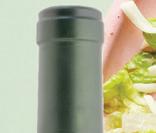
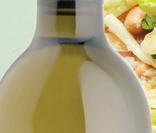



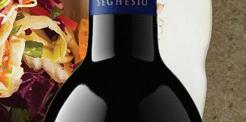



Trione Sauvignon Blanc
LEON SALAD | PAGE 39
This wine showcases beautiful aromas of lemon blossom and lime zest, intertwined with fresh, juicy white peach. On the palate, the bright acidity accentuates tropical flavors of guava and honeydew melon. It’s a well-rounded wine perfect for any occasion.
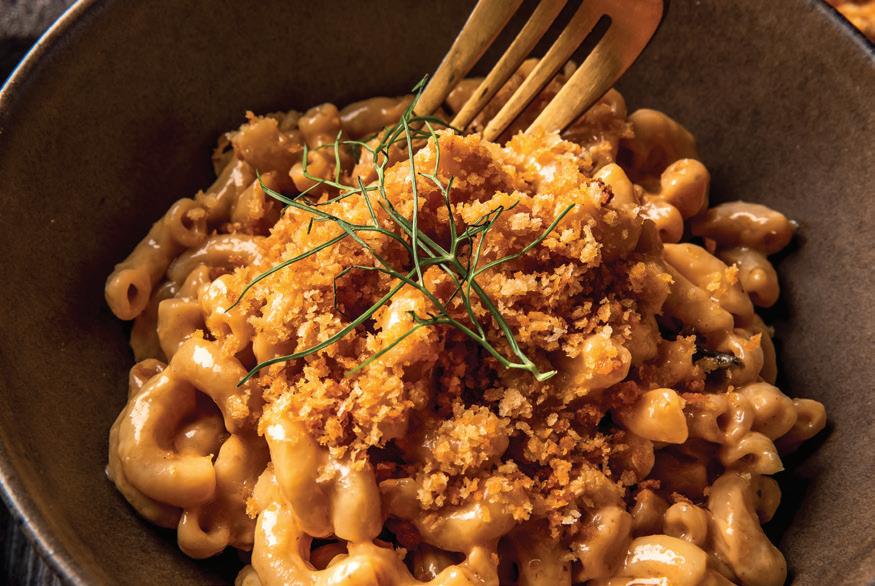
A to Z Pinot Noir
SMOKED MAC & CHEESE | PAGE 50

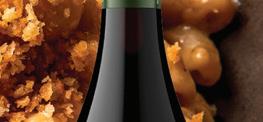



This Oregon Pinot Noir opens with compelling aromatics suggesting red fruit, spice, herbs, wood, and savory notes. The palate is succulent and round, with structured tannins that pair with fresh, balanced acidity to give the wine focus and precision as well as length.
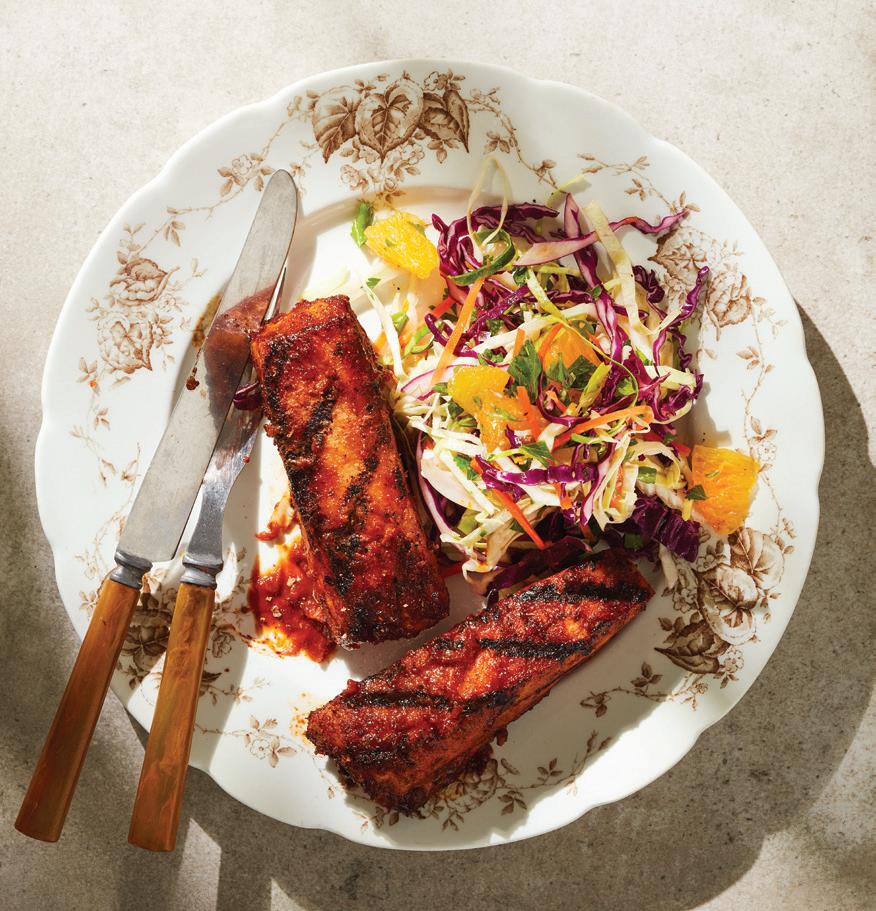
Seghesio Sonoma Zinfandel
COUNTRY STYLE PORK RIBS | PAGE 24


This Zinfandel captivates with a complex fusion of blackberry, black currant, plum, cherry, and baking spice aromas. Its lively palate showcases succulent fruit interwoven with supple tannins, persisting from mid-palate to a gratifying finish.



Truchard Chardonnay
SUMMER SUCCOTASH | PAGE 27
Layered with tropical fruit notes of pineapple and mango counterpointed by a core of bright citrus fruits of Meyer lemon, quince, and kumquat, this is then rounded out by Granny Smith apples, spice, and floral-like perfume. The high-quality French oak is well integrated and the wine has amazing acidity for its richness and complexity.
by alesha taylor
As the temperature rises and the days grow longer, it’s time to embark on a culinary adventure in your own backyard. Grilling is not just a cooking method—it’s an art form that allows you to infuse your food with smoky flavors and create mouthwatering dishes that will delight your taste buds. From choosing the right equipment to mastering flavor, follow these tips for next-level summer grilling.


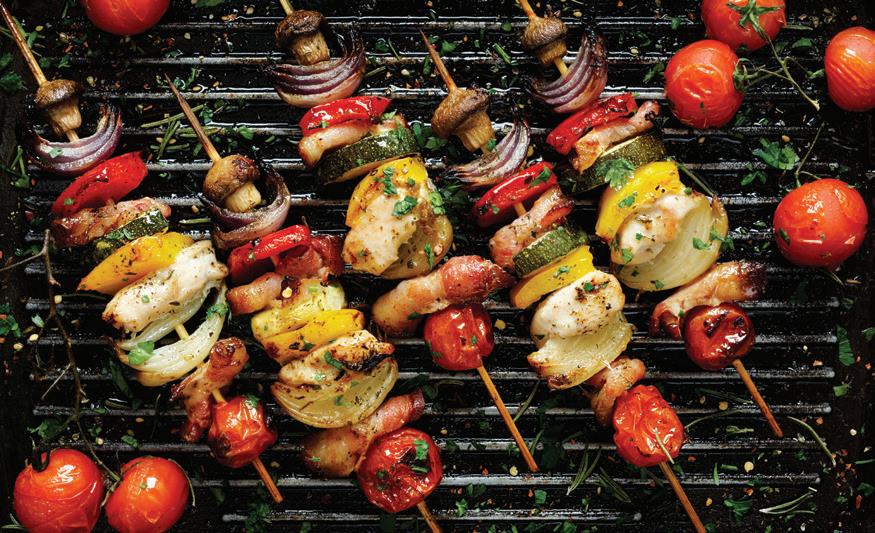
Skewers are a versatile and fun way to grill meats, vegetables, and fruits. Soak bamboo skewers in water for at least 30 minutes before grilling to prevent them from burning. Thread marinated chicken, bell peppers, onions, and pineapple onto skewers for a colorful and flavorful kebab. For a Mediterranean twist, skewer lamb chunks with cherry tomatoes, zucchini, and red onion.











Proper maintenance of your grill is crucial for optimal performance and food safety. Clean the grates before and after each use with a grill brush to remove residue and prevent sticking. After cleaning, oil the grates lightly paper towel soaked in vegetable oil and a pair of tongs

















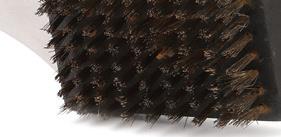



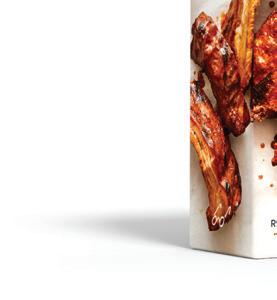
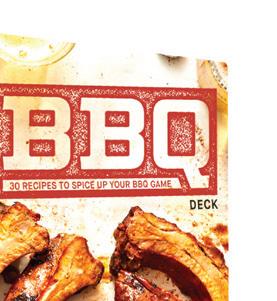
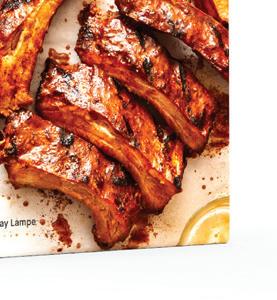



Prioritize safety when grilling outdoors. Keep a fire extinguisher nearby in case of emergencies. Use long-handled utensils to avoid burns and flare-ups. Never leave the grill unattended while in use and ensure proper ventilation to prevent carbon monoxide buildup.

Having the right tools on hand can elevate your grilling experience. Did you know you can use a cheese grater to finely chop herbs like rosemary and thyme? These aromatics enhance the flavor of grilled meats and veggies. A seafood basket is perfect for cooking delicate fish fillets and shrimp without losing them to the grates.

















Don’t be afraid to experiment with di erent marinades, rubs, and sauces to enhance the flavors of your grilled dishes. Marinades with citrus juices, herbs, and spices can tenderize meats and add a depth of flavor. Rubs made with smoked paprika, garlic powder, and brown sugar create a caramelized crust on grilled meats. Or up the ante with “BBQ Deck: 30 Recipes to Spice Up Your BBQ Game” for curated ’cue dishes by certified Barbecue Hall of Famer Ray “Dr. BBQ” Lampe. This portable deck features classics like Memphis Dry-Rubbed Back Ribs and creative delights like Pig Wings. Each card includes fire-roasted magic, essential grilling tools, pairing suggestions, and rub recipes, making it a must-have for barbecue enthusiasts of all levels.




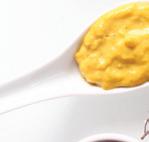
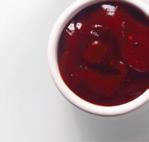

Consider your cooking style and preferences when selecting a grill. Gas grills o er convenience and precise temperature control, while charcoal grills impart a smoky flavor to your food. Flat-top grills are versatile and excellent for cooking delicate foods like fish and vegetables.











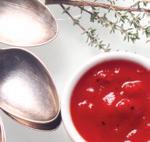


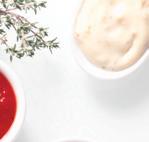

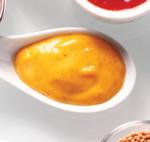
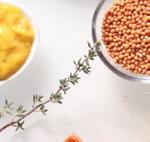



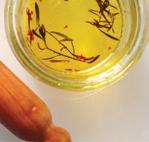




by macy harder







Apply sunscreen every day, even when it’s cloudy. Using sunscreen with an SPF of at least 30 is essential in preventing sunburn and skin cancer.
Berries —Summer offers prime pickings for raspberries, blackberries, blueberries, and strawberries. Berries are high in fiber, vitamin C, and antioxidants, and are known to help lower blood pressure, prevent cancer, and aid in digestion.
Corn —Toss a few cobs on the grill during your backyard barbecues. Corn is good for digestion, heart health, and even eye health.
Diversify your protein sources. If chicken is your go-to, try swapping it for grilled salmon, trout, or shrimp every once in a while.
Eat outdoors! Enjoy prime picnic season and soak up some extra vitamin D. Fresh air is beneficial for your immune system, lungs, heart, and mental health.





Freeze grapes, mango chunks, or bananas to keep a cold, refreshing snack on hand.
Go for a walk. A simple daily walk comes with a multitude of health benefits, including cancer and disease prevention, weight loss, increased energy levels, improved mood and memory, and stronger bones and muscles.
Hydrate, hydrate, hydrate. Warm weather activities can lead to increased water loss through sweat, so be sure to up your water intake this summer. Fruit can be full of H2O, too—watermelon, strawberries, and grapefruit are great thirst-quenchers.
Incorporate healthy fats from sources like avocados, nuts, and olive oil into your meals.





Jump rope —This full-body workout can boost your heart health, build stronger bones, improve coordination, and even ease anxiety.




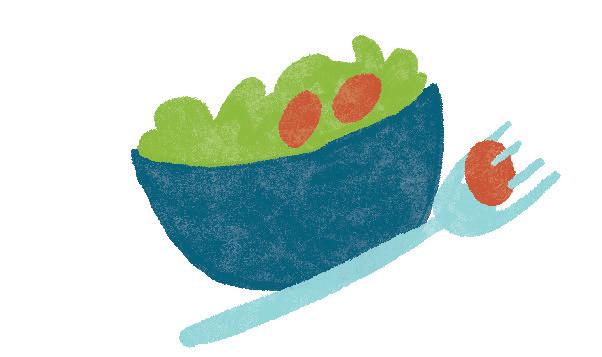
Keep portions small. Try lighter meals and snacks throughout the day to prevent feeling sluggish in the heat.







Lean protein —White poultry meat, fish, and lean red meats are light, easily digested, and great for summertime meals.





Make your own frozen treats. Healthier dessert alternatives like smoothie bowls, yogurt pops, and fruit sorbets are delicious and easy to whip up at home.

Take advantage of fresh produce. Many fruits and veggies are in season (like tomatoes, corn, zucchini, peppers, and berries, to name a few), so now is the perfect time to fill your plate with fresh ingredients.
Use fresh herbs to spice up your meals without adding sugar or sodium.
Vitamin C —Did you know that increasing your vitamin C intake can help protect your skin from sun damage? Stock up on cantaloupe, citrus fruits, broccoli, and bell peppers.


Nuts, seeds, and legumes are full of vitamins and minerals and make for energizing midday snacks.






Okra —This green vegetable is in its prime season throughout June and July. Try okra roasted, fried, grilled, or sauteed.
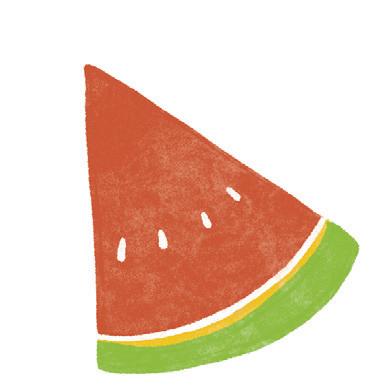
Watermelon —Containing 92% water, watermelon is not only delicious, but a great source of hydration. Its versatile flavor works well in both sweet and savory dishes, from salad and salsa to sorbet and fresh-pressed juice. Always wash the outside of a melon before cutting.



Pineapple —This tropical fruit is a great source of antioxidants and digestive enzymes that contribute to gut health.






(E)xperiment with outdoor cooking techniques.











Quench your thirst with infused water. Add some fruits and herbs of your choice into water and refrigerate the mixture for at least 4 hours or overnight. This refreshing, low-sugar beverage will both taste good and provide essential nutrients.

Yogurt —Enjoy yogurt on its own, topped with berries and granola, or mixed into a smoothie. It’s perfect for a light snack and is a great way to get some extra protein and probiotics in your diet.

Replace creamy salad dressings with lighter vinaigrettes.
Sleep for at least 7 to 10 hours each night.

Zinc —This important mineral helps the immune system fight off viruses and bacteria. Poultry, seafood, and other meats are rich in zinc, but it can also be found in legumes, nuts, seeds, and whole grains.





























VFire up your grill and elevate this season’s cookouts with regional barbecue styles and updated



by molly stevens











olumes have been wri en about the long history of barbecue in America, and culinary scholars and pitmasters alike still can’t agree on the intricacies of regional styles and formulas. But there is one thing that we can all agree on: A backyard barbecue party signals a good time! So, let’s put aside debating about which type of barbecue reigns supreme and celebrate our collective enjoyment of grilled food, summer salads, and the opportunity to gather with friends and family.



Inspired by some of the most iconic barbecue styles around the country, choose from mustardy grilled chicken, a smoky flank steak, or sweet-tangy sauced pork ribs. Accompany these with one or more updated classic side salads, such as creamy potato salad, crunchy slaw, or a fresh take on succotash. If you’ve got a real crowd, double up the recipes, offer more than one, or toss a few burgers and hot dogs on the grill to make sure there’s plenty for everyone. If you’re ambitious, you can add a few traditional side dishes (see sidebar on next page). No matter how you build your menu, top the whole thing off with an ethereal lemon mousse festooned with summer berries. That’s something no one will debate!


COUNTRY-STYLE
PORK RIBS WITH TANGY-SWEET
BARBECUE SAUCE AND CABBAGE, FENNEL, AND CARROT
COLESLAW WITH GINGER-ORANGE
DRESSING (RECIPES ON PAGE 24)
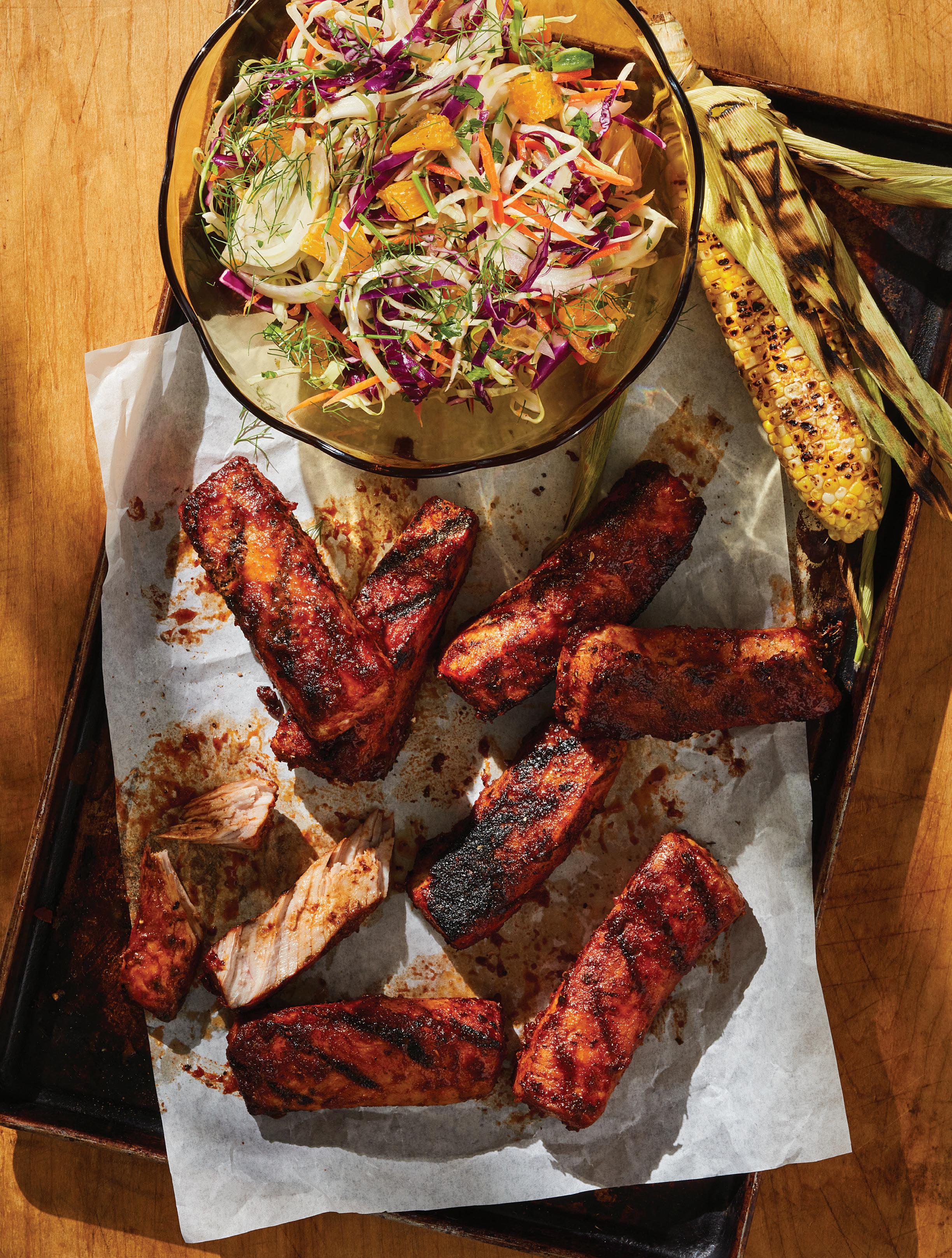


MAKES 4 TO 6 SERVINGS
Inspired by the piquant mustard-based sauces used to slather whole-hog barbecue in South Carolina, this creamy no-cook sauce adds heaps of flavor to boneless chicken thighs and breasts. The grilled scallions are optional here, but their sweet oniony bite plays perfectly with the sharp sauce so it’s a shame to skip them.

for the tangy mustard sauce
3 tablespoons brown sugar
1⁄2 teaspoon ground ginger
2 tablespoons warm water
1⁄3 cup yellow mustard
1⁄4 cup Dijon mustard, plus 1 teaspoon
2 tablespoons cider vinegar
2 teaspoons Worcestershire sauce
1 teaspoon hot sauce, such as Frank’s, or to taste

Pinch salt (optional)
2-21⁄4 pounds boneless, skinless chicken thighs and breasts Salt and pepper, to taste
2 tablespoons mayonnaise
1 bunch scallions, trimmed (optional)
2 teaspoons vegetable oil (optional)

MAKES 4 TO 6 SERVINGS
If there is any one dish that every barbecue needs, it’s potato salad. And this uptown version might just steal the show. A measure of yogurt (or sour cream) balances the richness of the creamy dressing, and the addition of pickles and capers adds a jolt of acid to bring the whole thing into focus.

1. In a small bowl, stir together the brown sugar, ginger, and warm water. Once combined, whisk in the yellow mustard, 1⁄4 cup Dijon, vinegar, Worcestershire, and hot sauce. Taste and, if needed, add more hot sauce and/or a small pinch of salt. Cover and set aside for 1 hour at room temperature. The sauce can be made ahead and refrigerated for up to 2 days.
2. Prepare a grill to medium-hot. As the grill heats, prepare the chicken and scallions, if using, for the grill.
3. Place the chicken in a mixing bowl. Season all over with salt and pepper. Add the mayonnaise and the remaining 1 teaspoon Dijon and stir or toss with your hands to coat the pieces evenly.
4. If using scallions, cut o the top 2 inches of each, and finely chop these. Set aside for garnish. Coat the whole scallions with vegetable oil. Grill the scallions, turning frequently, until tender and gently charred, about 4 minutes, and move to the perimeter of the grill to keep warm.


21⁄2 pounds small red potatoes, scrubbed
1⁄2 cup mayonnaise
1⁄4 cup plain yogurt or sour cream, whole or low-fat
2 tablespoons pickle juice
1 tablespoon Dijon mustard
1 cup chopped celery
3 scallions, white and green parts, finely chopped

5. Arrange the chicken on the grill and cook, turning several times so the chicken sears without charring, for 12 to 16 minutes, or until browned and cooked through. To check doneness, cut into the thickest piece to see that it’s done, or check with an instant-read thermometer. Breast pieces should be 160°F and thigh pieces 175°F to 180°F.
6. Immediately spoon some mustard sauce over the chicken, and top with the chopped scallion greens, if using. Serve the chicken and grilled scallions, o ering the remaining sauce at the table.
Nutrition (per serving): Calories: 190, Fat: 6g (Sat: 0.5g), Cholesterol: 65mg, Sodium: 810mg, Carb: 7g, Fiber: <1g, Sugar: 5g, Protein: 24g








1⁄3 cup pickles, chopped (see Cook’s Notes)
2 tablespoons capers, drained and coarsely chopped
2 tablespoons chopped fresh dill

2 hard-boiled eggs, chopped (see Cook’s Notes)
Salt and freshly ground black pepper, to taste
1. Put the potatoes in a large saucepan, add water to cover them by 2 inches, and add a good pinch of salt. Bring to a boil. Adjust heat and simmer until the potatoes are tender, 15 to 18 minutes. Drain and set aside until cool enough to handle.
2. In a small bowl, whisk together the mayonnaise, yogurt (or sour cream), pickle juice, and mustard. Season with salt and pepper.
3. When the potatoes are cool enough to handle, cut them into bite-size chunks and drop them into a large bowl. Add the celery, scallions, pickles, capers, and dill. Stir gently with a flexible spatula to combine. Pour over the dressing and stir to coat. Stir in the chopped eggs, and season to taste with salt and pepper. Serve or refrigerate for up to 1 day.
Cook’s Notes


■ Boiling potatoes whole with the skin on leaves them less waterlogged, so they are thirstier and better able to absorb the flavors of the dressing.

■ To hard-boil the eggs, put them in a small saucepan and cover with water by at least 1 inch. Bring to a boil slowly over medium-low heat. Once the water boils, cover the pot, turn o the heat, and set a timer for 15 minutes. Then, drain and rinse with cold water before peeling
■ Use whichever pickles you prefer here—dill, sweet, hot, or even a mixture.
■ The potato skins add color and texture to the salad, but if they are bitter or tough, scrape them o as you’re cutting up the boiled potatoes.
■ The salad can be made ahead, but chilling can mute the flavors, so if it has been chilled, check for salt and pepper before serving.

Nutrition (per serving): Calories: 300, Fat: 17g (Sat: 3g), Cholesterol: 75mg, Sodium: 390mg, Carb: 33g, Fiber: 4g, Sugar: 3g, Protein: 7g
For barbecue enthusiasts, the side dishes can be paramount to the main course. Here are some classics that enhance any cookout—plus, find these and more salads ready to pick up in the deli:

















MAKES 4 TO 6 SERVINGS
The thick tomatoey barbecue sauce served on pork ribs in and around Kansas City is perhaps the most ubiquitous in the country, but many recipes end up cloyingly sweet because of a reliance on ketchup. Here, we use tomato puree instead to create a sauce that balances all the elements of sweet, tangy, and spicy into an irresistible partner for boneless country-style ribs.

2 -21⁄2 pounds boneless countrystyle pork ribs, 1-11⁄2 inches thick
2 teaspoons ground coriander
2 teaspoons brown sugar, light or dark
2 teaspoons dried oregano
1 teaspoon ground mustard
1 teaspoon paprika, sweet, hot, or smoked
2 teaspoons kosher salt (or 11⁄2 teaspoons fine)
1⁄2 teaspoon freshly ground black pepper
for the barbecue sauce
2 tablespoons vegetable oil
1 small onion, minced



2-3 garlic cloves, minced
1 teaspoon chili powder
1 teaspoon ground cumin
1 teaspoon paprika, sweet, hot, or smoked
1⁄2 teaspoon ground mustard
1⁄2 teaspoon celery seed
1⁄4 teaspoon cayenne, or to taste
1 cup tomato puree
1⁄3 cup brown sugar, light or dark
3 tablespoons lemon juice
2 tablespoons molasses
1 teaspoon kosher salt (or 3⁄4 teaspoons fine sea salt), or to taste
1. Arrange the pork ribs on a plate or baking dish. In a small bowl, combine the coriander, brown sugar, oregano, mustard, paprika, salt, and pepper. Sprinkle the seasoning mix over the ribs, rubbing so it adheres. Cover loosely with plastic wrap and refrigerate for at least 2 hours and up to 12 hours.

2. For the sauce, heat the oil in a medium saucepan over medium-low heat. Add the onion and garlic and saute until tender and translucent, about 6 minutes. Add the chili powder, cumin, paprika, mustard, celery seed, and cayenne. Stir and cook until just fragrant, 1 to 2 minutes. Add the tomato puree, sugar, lemon juice, molasses, and salt. Stir to combine and bring to a simmer. Reduce heat to maintain a gentle simmer, and cook until thick and shiny, 20 to 25 minutes. Puree the sauce using an immersion blender or by transferring to a blender. Set aside. The sauce may be made ahead and refrigerated for several days.

A zingy ginger-orange dressing brings harmony to the colorful mix of red and green cabbage, fresh fennel, and carrots in this bright and fresh-tasting slaw. The vegetables need to sit for 30 to 60 minutes before serving to absorb the dressing, and the salad will retain its crunch and flavor for up to 2 days.
4 cups shredded green cabbage (about 3⁄4 pound)
4 cups shredded red cabbage (about 3⁄4 pound)
1 medium fennel bulb, quartered, cored, and thinly sliced
3 teaspoons sugar, divided
1 teaspoon kosher salt (or 3⁄4 teaspoon fine sea salt), plus more to taste

3. Preheat a grill to medium heat. Let the ribs sit at room temperature as the grill heats. If the sauce has been refrigerated, return it to a saucepan and heat over gentle heat until warm.

4. Grill the ribs, turning as needed so they brown without charring, until tender and cooked through, 15 to 20 minutes. During the last few minutes of grilling, brush the ribs with barbecue sauce, turning so the sauce browns. Check for doneness by pressing on the ribs to feel that they are tender or insert an instant-read thermometer into the thickest part to check that the internal temperature is 175°F to 180°F. Serve, passing extra barbecue sauce on the side.
Cook’s Notes
■ Country-style pork ribs are not technically ribs. Instead, they are thick-cut strips from the blade end of the loin, near the shoulder. For grilling, look for uniform country-style ribs (1 to 11⁄2 inches thick) without too much fat or connective tissue.
■ Beyond pork ribs, try this sauce on chicken or burgers. It’s so good, you may want to double the recipe.

1 teaspoon finely grated ginger
1⁄2 teaspoon finely grated garlic
1 navel orange, scrubbed
3 tablespoons apple cider vinegar
2 cups shredded carrots (2 medium-large)
1⁄3 cup parsley leaves, coarsely chopped
1⁄4 cup extra virgin olive oil
Freshly ground black pepper, to taste

1. Combine the cabbages and fennel in a colander set over a large bowl or sink. Sprinkle with 1 teaspoon sugar and 1 teaspoon salt (if using fine sea salt, use only 3⁄4 teaspoon) and toss to distribute the salt and sugar evenly. Let sit for 30 to 60 minutes to soften the vegetables, so they can better absorb the dressing.
2. Meanwhile, grate 1⁄2 teaspoon orange zest; reserve the orange. Combine the zest with the ginger and garlic in a small bowl. Add a pinch of salt, the vinegar, and the remaining 2 teaspoons of sugar. Set aside for at least 20 minutes to macerate.


3. Shake the cabbage and fennel a few times to eliminate excess moisture and transfer it to a mixing bowl. Add the carrots. Use a sharp knife to remove the peel from the orange, then cut into slices and cut the slices into quarters. Add these to the bowl along with the parsley.
4. Add the olive oil to the ginger-garlic-zest mixture and whisk to combine. Season with black pepper to taste. Pour the dressing over the slaw and toss to combine. Taste for salt; it may not need any. Refrigerate 30 minutes, or up to 2 days. Toss, and taste for salt again before serving.
Cook’s Notes
■ You’ll need about 1⁄4 head of each red and green cabbage. If you prefer, you can make the slaw with all one type, although it won’t be as colorful.

Nutrition (per serving): Calories: 480, Fat: 28g (Sat: 7g), Cholesterol: 125mg, Sodium: 990mg, Carb: 21g, Fiber: 2g, Sugar: 17g, Protein: 39g

■ You can shred the cabbage by hand or with a food processor. Either way, start by cutting the cabbage in quarters and removing the solid core. Shred crosswise.
■ For the fennel, start by removing the fronds and stalks. Then cut the bulb into quarters and remove the solid core. Set each core on its side and slice crosswise (or feed the cores into a food processor fitted with the shredding blade).
■ You can also make this with preshredded cabbage, either green, red, or white, or a tricolor mix. You will need a total of 8 cups, which is 1 1⁄4 to 1 1⁄2 pounds.
Nutrition (per serving): Calories: 150, Fat: 10g (Sat: 1.5g), Cholesterol: 0mg, Sodium: 350mg, Carb: 17g, Fiber: 5g, Sugar: 10g, Protein: 2g




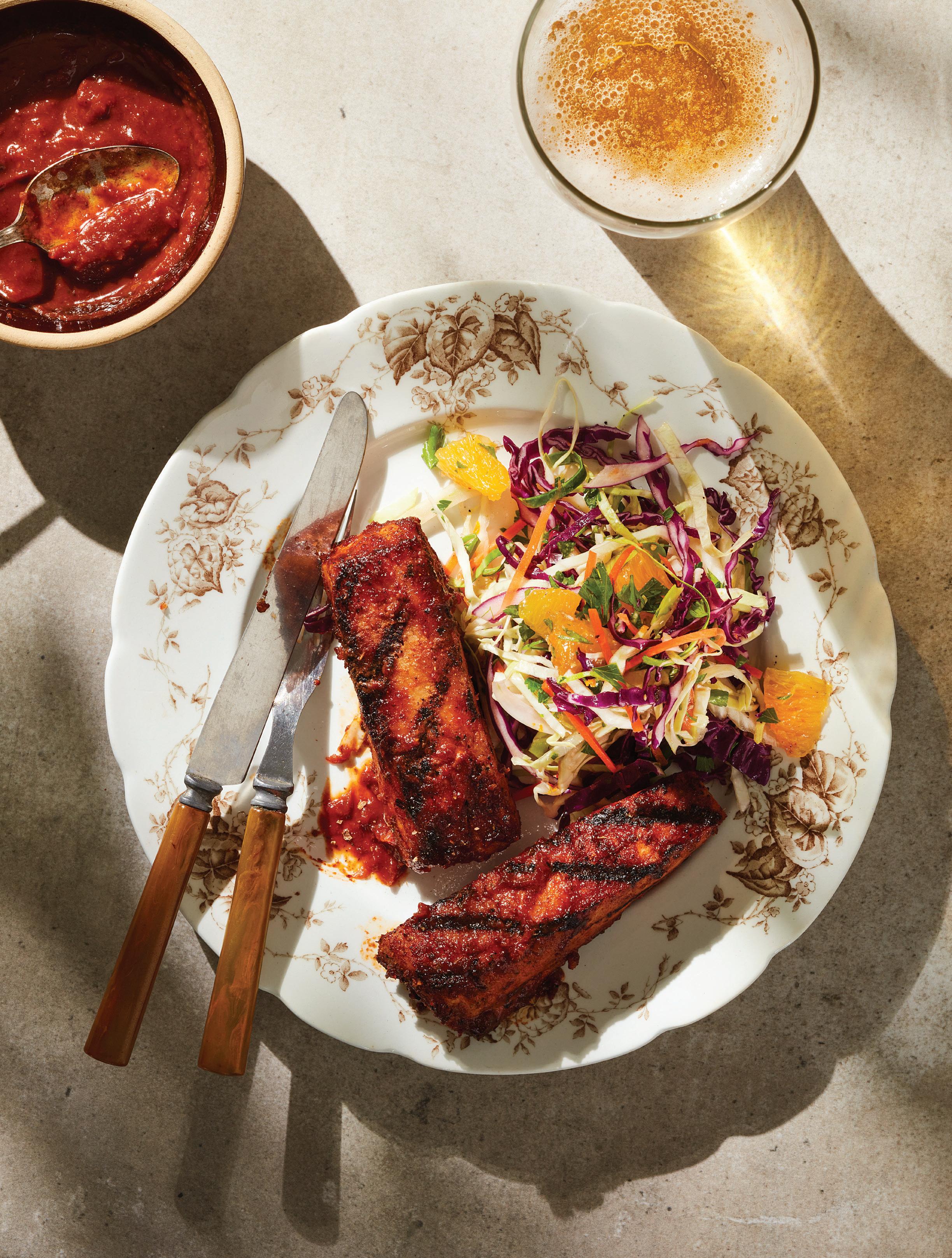
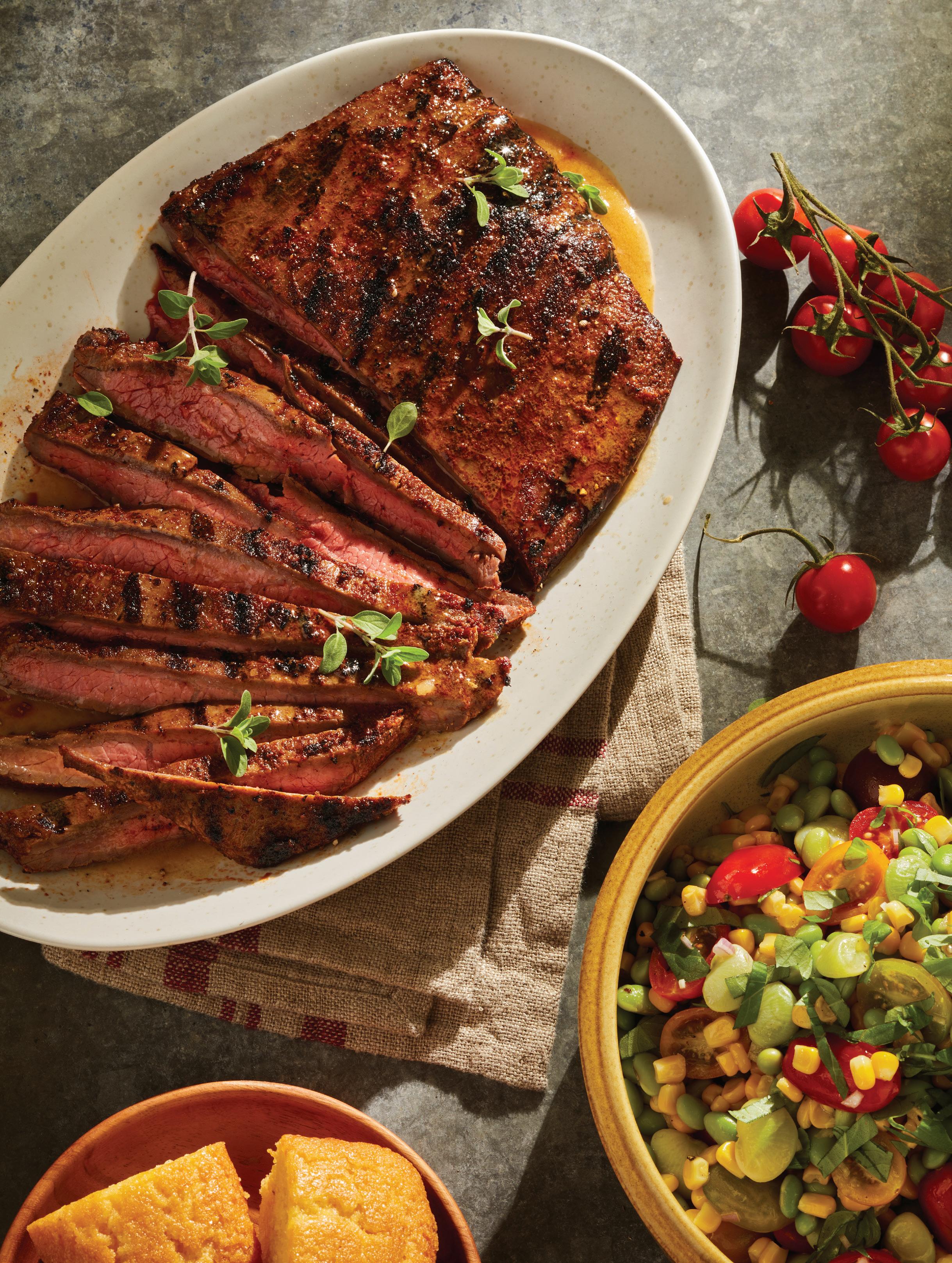

MAKES 4 TO 6 SERVINGS
On many barbecue circuits, especially in Texas where brisket reigns, the meat stands on its own in terms of flavor and juiciness, making sauce superfluous. But achieving this level of perfection takes long hours over a carefully tended wood fire. This shortcut version relies on a heady spice rub to tenderize and season a quicker-cooking flank steak and a simple warm butter sauce to add succulence.
1 (11⁄2 to 2-pound) flank steak
2 teaspoons ground cumin
2 teaspoons paprika, preferably smoked
1 teaspoon chili powder
1 teaspoon onion powder
1⁄8 -1⁄4 teaspoon cayenne
2 teaspoons kosher salt (or 11⁄2 teaspoons fine sea salt)
3 tablespoons unsalted butter



2 teaspoons Worcestershire sauce
1 teaspoon cider vinegar or white wine vinegar
1⁄8 teaspoon liquid smoke (optional; see Cook's Note)
Dash hot sauce, such as Frank’s Pinch salt
MAKES 4 TO 6 SERVINGS

1. Ahead of time 2 to 12 hours, place the steak on a platter or in a large baking dish that can accommodate it without folding. In a small bowl, combine the cumin, paprika, chili powder, onion powder, cayenne, and salt. Sprinkle the spice mixture over the entire surface of the steak, rubbing so that it adheres. Cover loosely with plastic wrap and refrigerate for at least 2 hours and up to 12 hours.
2. Preheat a grill to medium-hot. Let the steak sit at room temperature as the grill heats.
3. Melt the butter in a small saucepan over medium-low heat. Whisk in the Worcestershire, vinegar, liquid smoke (if using), hot sauce, and salt. Set aside in a warm spot.

4. Grill the steak, turning as needed so the outside sears nicely without charring, until browned and cooked to your liking, 10 to 15 minutes. Check for doneness by discretely cutting into the thickest part, or test with an instant-read thermometer. (For medium-rare, look for 120°F to 125°F; for medium, look for 125°F to 130°F.) Transfer the steak to a carving board to rest for 5 minutes. If the sauce has cooled, warm it briefly.

Colorful bean salads are a mainstay of summer menus and cookouts because they’re reliable, sturdy, and crowd-pleasing. But they can also be a little boring. So why not mix things up with a fresh take on succotash, combining corn, tomatoes, and beans with a light vinaigrette and a generous handful of fresh basil?
21⁄2 cups fresh or frozen edamame or lima beans
21⁄2 cups frozen corn kernels (see Cook’s Notes)
2 tablespoons lime juice
1 heaping tablespoon minced shallot
1⁄2 teaspoon Dijon mustard
1⁄2 teaspoon sugar
1⁄4 teaspoon salt, plus more to taste Freshly ground black pepper, to taste
1⁄4 cup extra virgin olive oil
1 pint cherry tomatoes, halved
1⁄3 cup fresh basil leaves, coarsely chopped

5. Slice the steak across the grain, pour the warm butter sauce over the top, and serve.
Cook’s Note: Liquid smoke, as the name suggests, is made by running actual wood smoke through a condenser to create a concentrated liquid with an intense, smoky flavor. It’s been around for over 100 years, and a dash gives this steak sauce the subtle kiss of smoke that otherwise requires hours over a wood fire. When shopping for liquid smoke, look for brands that contain nothing more than smoke and water. Some brands specify the type of wood used (such as hickory, applewood, or mesquite). Any flavor works here. Once you have a bottle, experiment with adding a few drops to your next pot of chili or stew to give the impression that it was cooked over an open fire.


1. Bring a large pot of water to a boil. Add a hefty pinch of salt. Add the beans. Return the water to a boil and boil for 1 minute. Add the corn, again return to a boil, and blanch until the vegetables are just tender, about 2 minutes. Drain, and immediately rinse with cold water. Drain again. Then spread onto a towel-lined baking sheet to dry and cool.
2. In a small bowl, combine the lime juice, shallot, mustard, sugar, and 1⁄4 teaspoon salt. Let sit for about 4 minutes to macerate. Whisk in the olive oil.

3. Combine the corn, beans, and tomatoes in a salad bowl. Pour over the dressing and toss to combine. Stir in the basil. Season to taste with salt and pepper. Serve. If making ahead, wait to add the basil until just before serving.


Nutrition (per serving): Calories: 250, Fat: 15g (Sat: 7g), Cholesterol: 70mg, Sodium: 690mg, Carb: 2g, Fiber: <1g, Sugar: 0g, Protein: 25g
Cook’s Notes
■ Although lima beans are traditional in succotash, the sweet-nutty taste and brighter green hue of edamame are more appealing in this fresh salad.
■ You can, of course, make this with fresh corn, and it’s a great way to use up leftover corn. You’ll need 3 to 4 ears to make 2 1⁄2 cups of kernels. Boil the corn ears, then stand them on end and slice o the kernels. Skip the blanching step (with the beans), just add the kernels to the salad.
■ The salad can be made up to 24 hours ahead. Just wait to add the basil just before serving.


Nutrition (per serving): Calories: 230, Fat: 11g (Sat: 1.5g), Cholesterol: 0mg, Sodium: 115mg, Carb: 31g, Fiber: 6g, Sugar: 9g, Protein: 7g





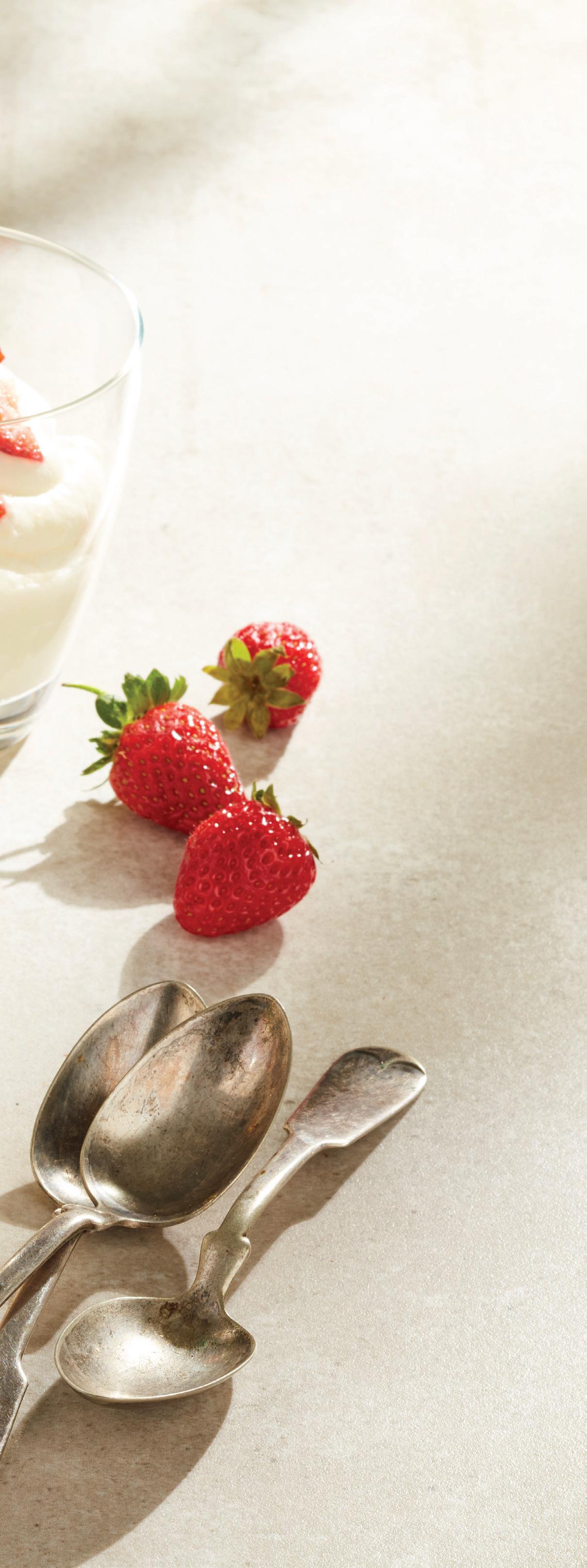



Lemon mousse makes an ideal summertime dessert, striking a magical balance between light and decadent. The only tricky part is making the lemon curd (a silky combination of gently cooked eggs, sugar, and lemon), but once you get the hang of rigging up a double boiler, it’s no work at all. If you’re pressed for time, you can substitute store-bought lemon curd (see Cook’s Notes).
2 large eggs
1⁄2 cup granulated sugar Pinch salt
2 teaspoons freshly grated lemon zest
1⁄3 cup fresh lemon juice
11⁄2 cups heavy whipping cream, very cold (see Cook’s Notes)
3 tablespoons powdered sugar, sifted
1-11⁄2 pints fresh berries, such as blueberries, raspberries, or strawberries Granola or candied nuts, for garnish (optional)


1. Rig up a double boiler with a saucepan and metal mixing bowl and put about 1 inch of water in the pan (See Cook’s Notes). Bring the water to a gentle simmer, leaving the bowl on the counter.
2. Combine the eggs, sugar, and salt in the metal bowl, and whisk until smooth and pale yellow. Whisk in the lemon zest and juice. Place the bowl over the simmering water and stir gently with a heat-resistant silicone spatula until the mixture thickens and coats the spatula, about 6 minutes. If at any point lumps appear, lift the bowl o the saucepan and stir to smooth out. If necessary, lower the heat before replacing the bowl. Once thick, transfer the curd to a smaller bowl, cover with plastic, and chill for at least 1 hour. The lemon curd can be made up to 2 days ahead and refrigerated.


3. To make the mousse: Scrape the curd into a mixing bowl. Place the heavy cream in another mixing bowl (or in a stand mixer). Beat cream with the whisk attachment until starting to thicken. Add the powdered sugar and beat until soft peaks form. Spoon about 1⁄3 of the whipped cream into the lemon curd, combining with a silicone spatula until smooth. Return the mixture to the whipped cream, and gently fold together until smooth and well combined. Refrigerate until ready to serve. The mousse may be made 8 hours ahead.

4. To serve: For a family-style dessert, present the mousse in a pretty bowl accompanied by berries and, if using, granola or candied nuts, and invite guests to serve themselves. Or, prepare individual parfaits by layering the mousse with berries in stemmed wine glasses or dessert bowls and topping with granola or candied nuts, if using.
Cook’s Notes


■ You’ll need to make a double boiler to prevent the lemon curd from curdling. Choose a saucepan or wide, straight-sided skillet that will hold a metal mixing bowl so that it sits above (not in) 1 or 2 inches of water in the bottom of the pan. Bring the water to a gentle simmer over medium or medium-low heat, before setting the egg-lemon mixture on top and starting to cook.
■ If the lemon curd mixture does get too hot during cooking, lumps will appear. This won’t a ect the flavor, but the texture will be grainy. If this happens, strain the mixture through a fine sieve before chilling.
■ Be sure to use heavy whipping cream here. Anything lighter won’t hold up.
■ To make this with store-bought lemon curd, whisk 1 teaspoon of lemon zest into 1 scant cup of jarred curd before combining with the whipped cream.



Nutrition (per serving): Calories: 320, Fat: 23g (Sat: 14g), Cholesterol: 125mg, Sodium: 85mg, Carb: 27g, Fiber: 1g, Sugar: 25g, Protein: 4g



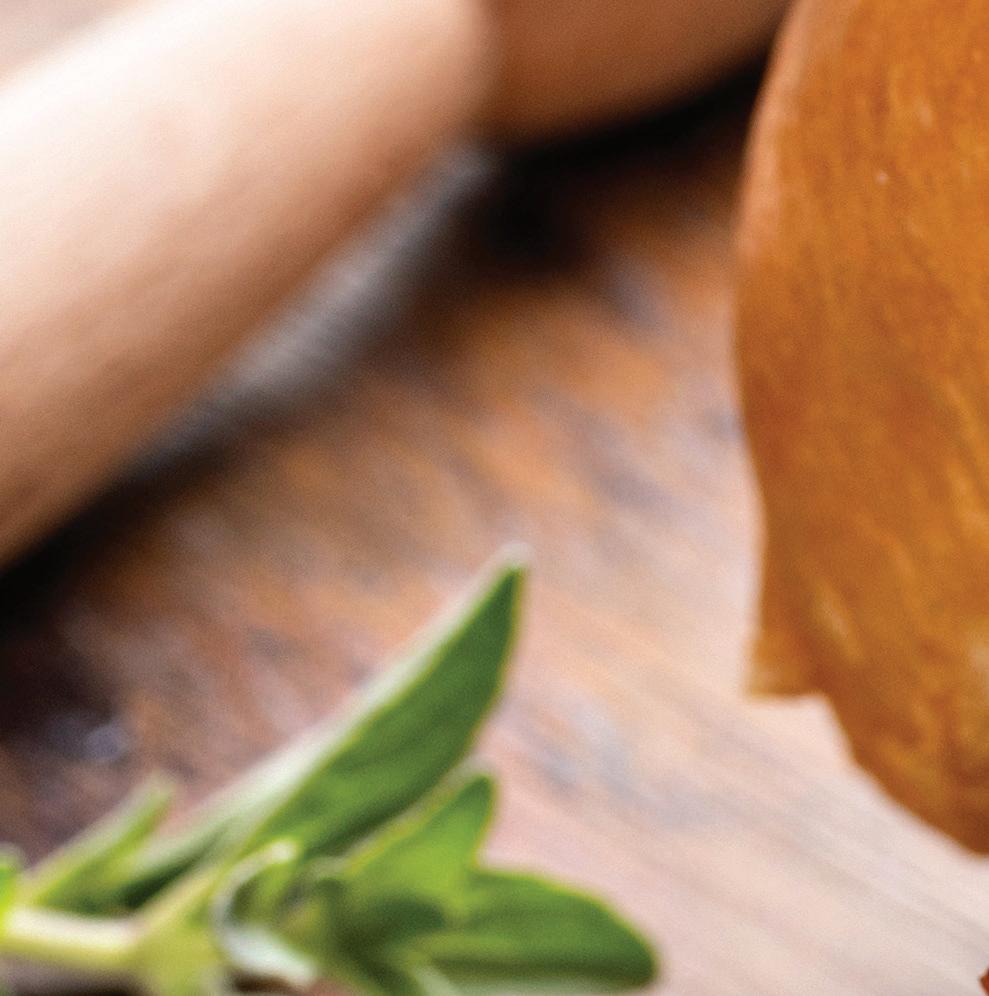



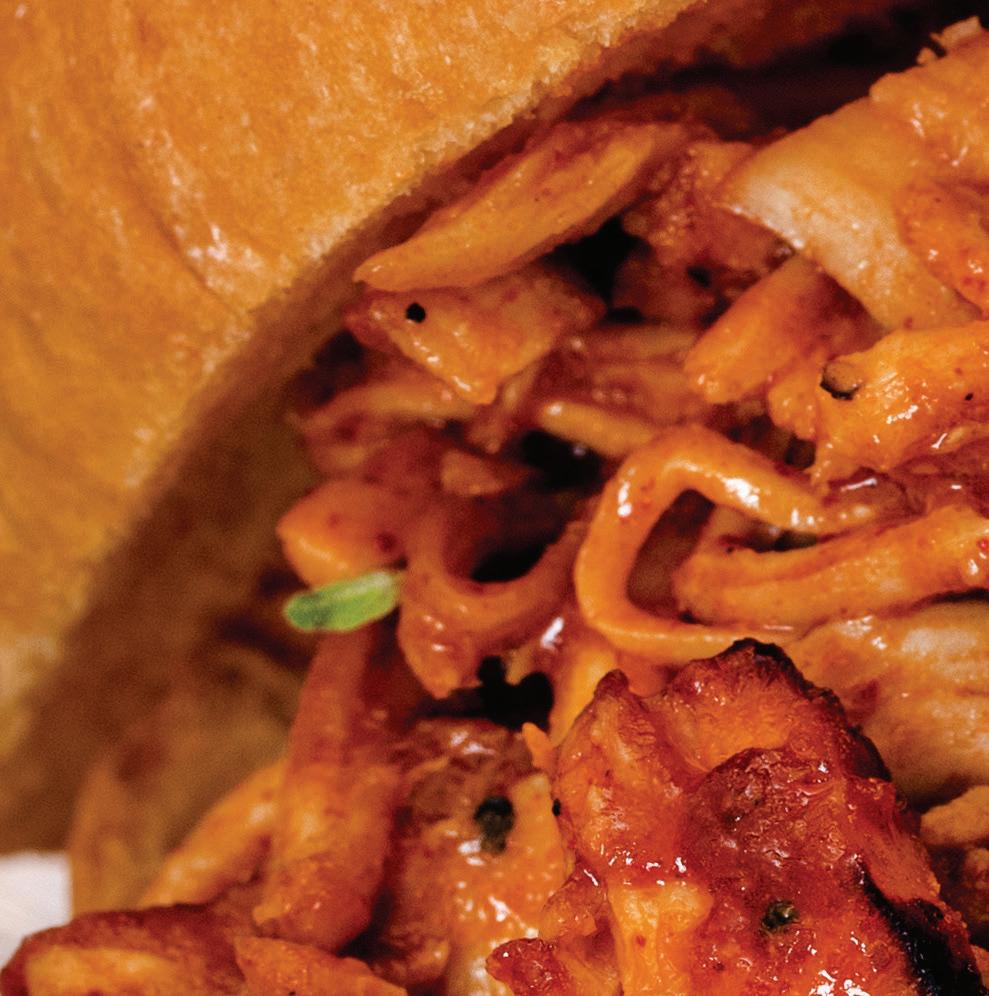
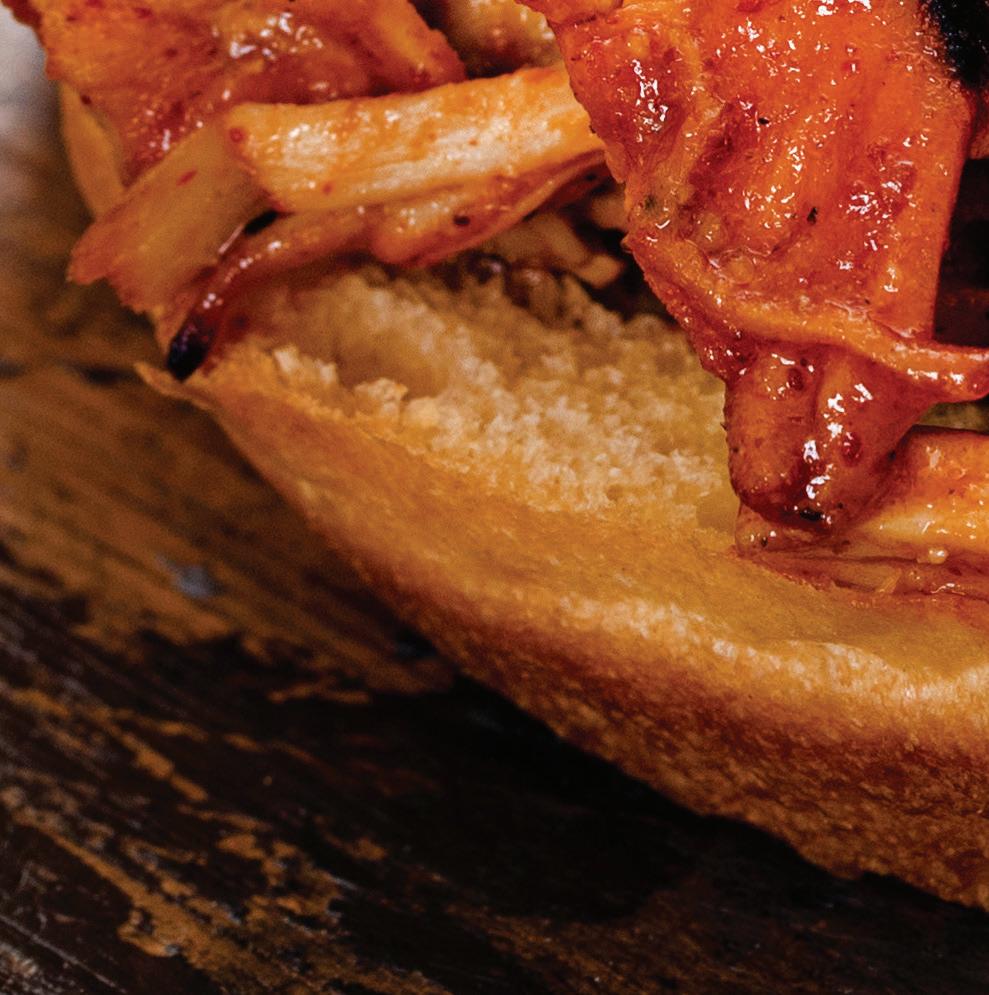
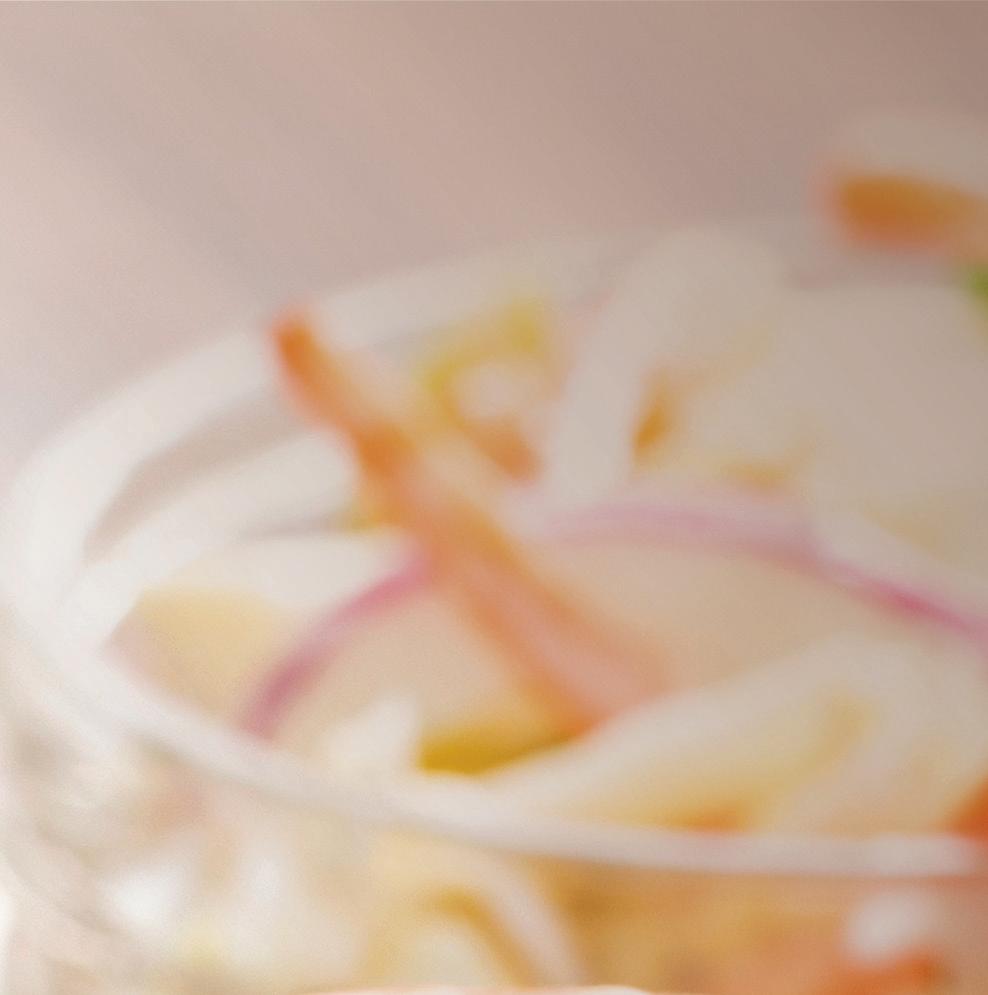

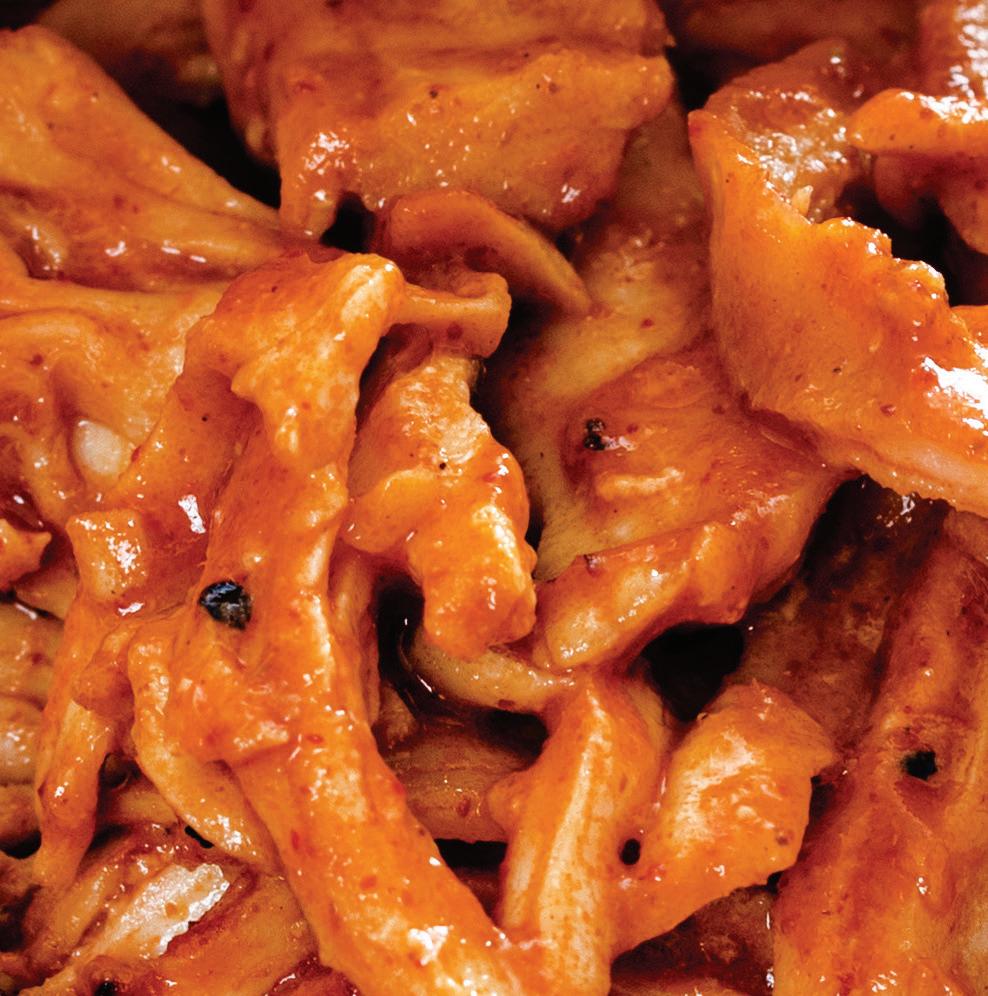






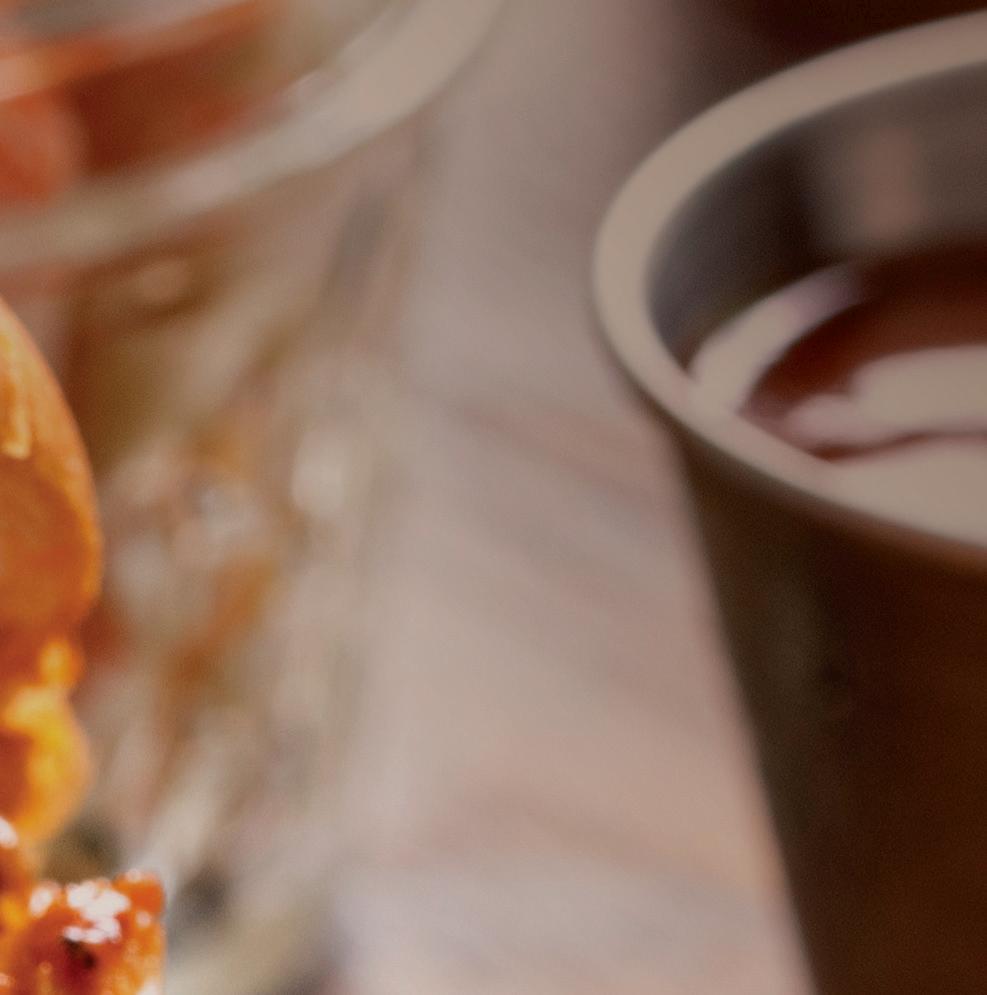


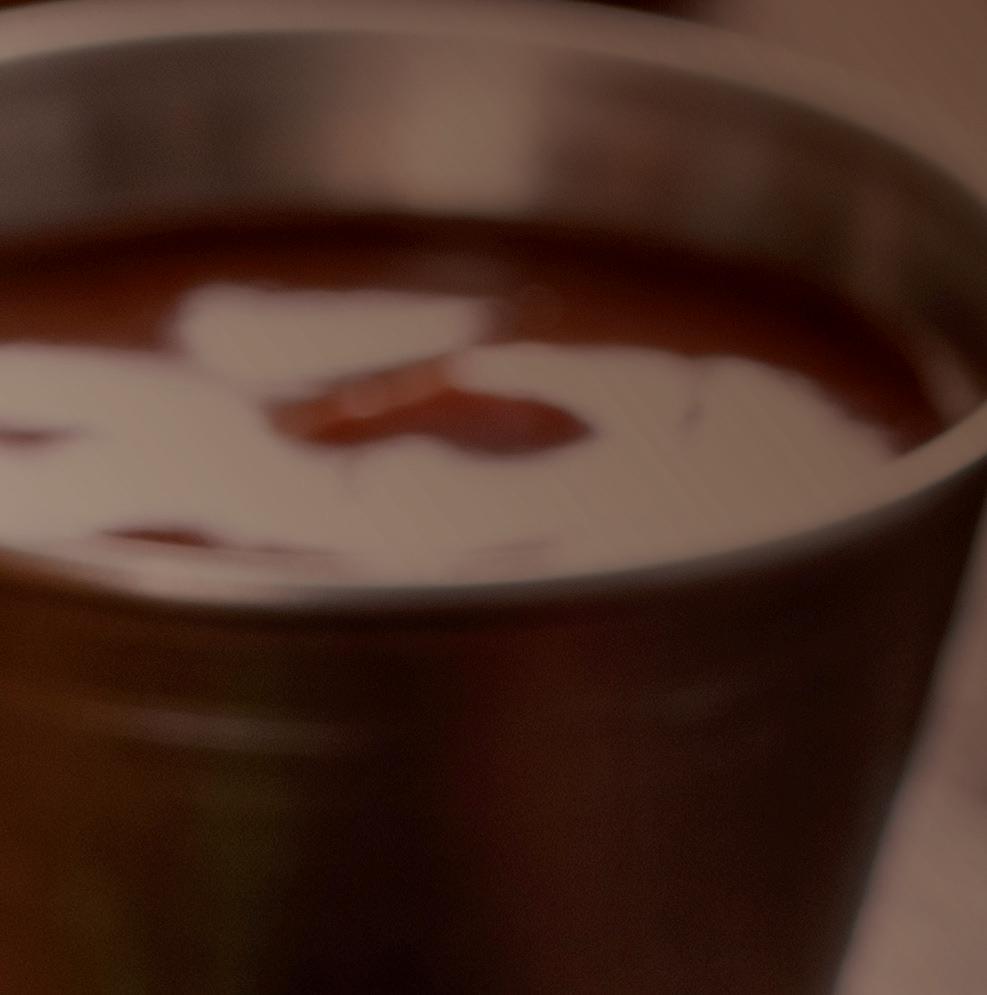
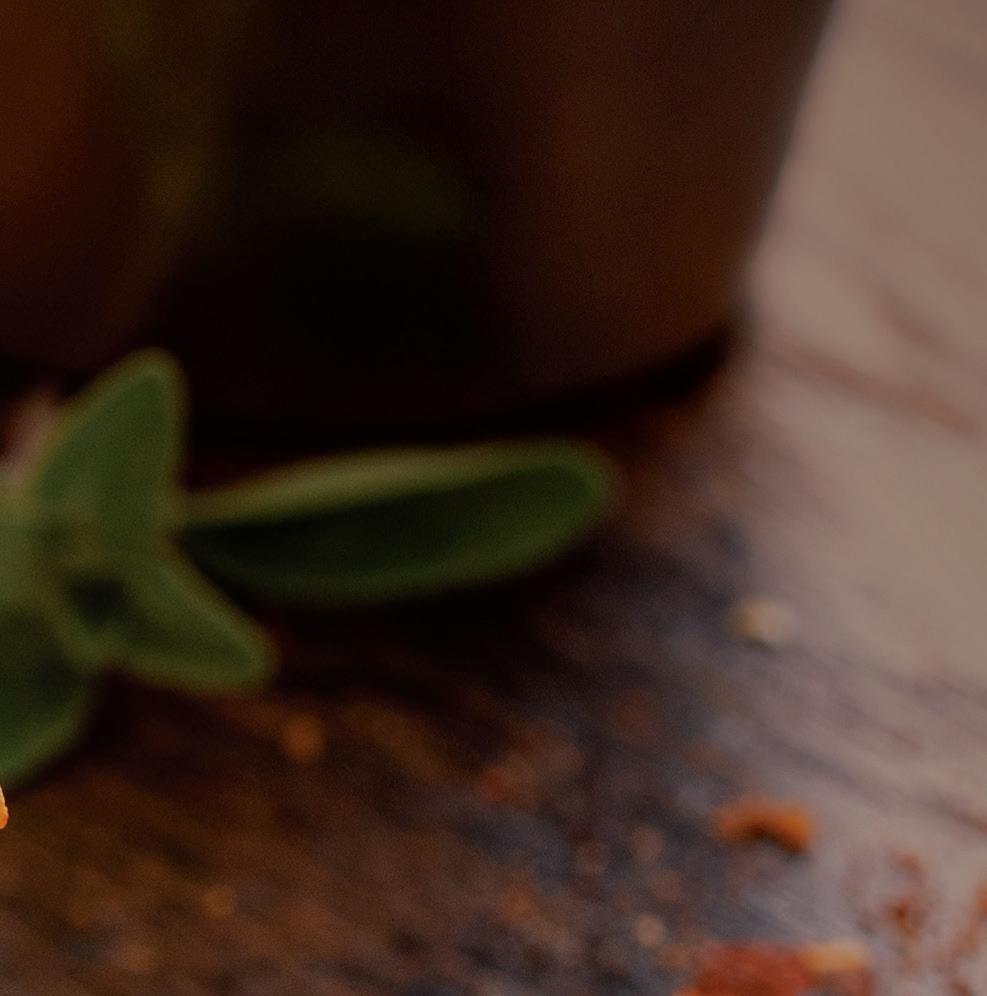

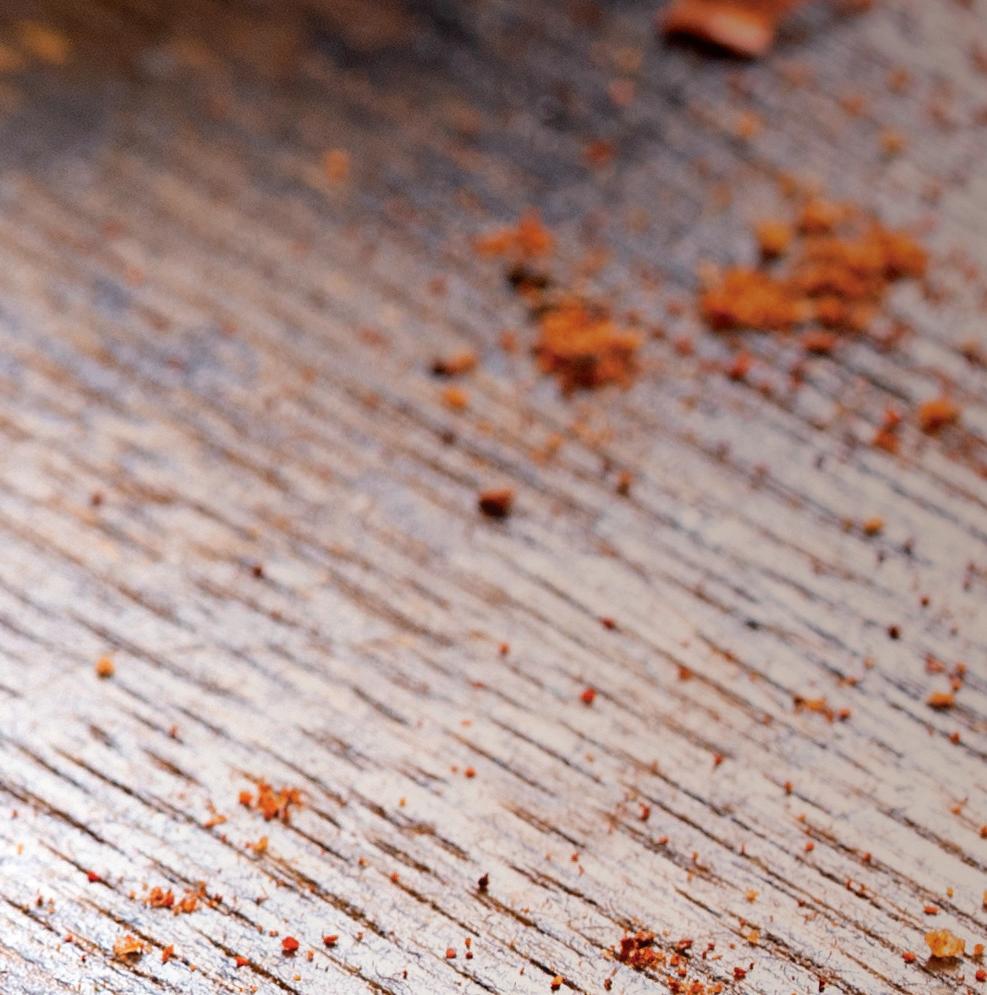


Your slow cooker is the perfect tool for easy summer meals

Beat the heat in the kitchen and enjoy more of a beautiful day while your slow cooker makes dinner. This trusty classic appliance often comes to mind for making comfort food during colder seasons, but summer is the perfect time to use it. You can avoid heating your kitchen and claim a little more time for yourself. Plus, with these easy meaty main dishes, you will often have more than you need for one meal and will be a step ahead on dinners for the week ahead, too. Either whip up easy sides or grab some ready-made in the deli and summer dinners will be a breeze. – m ary s ubialka
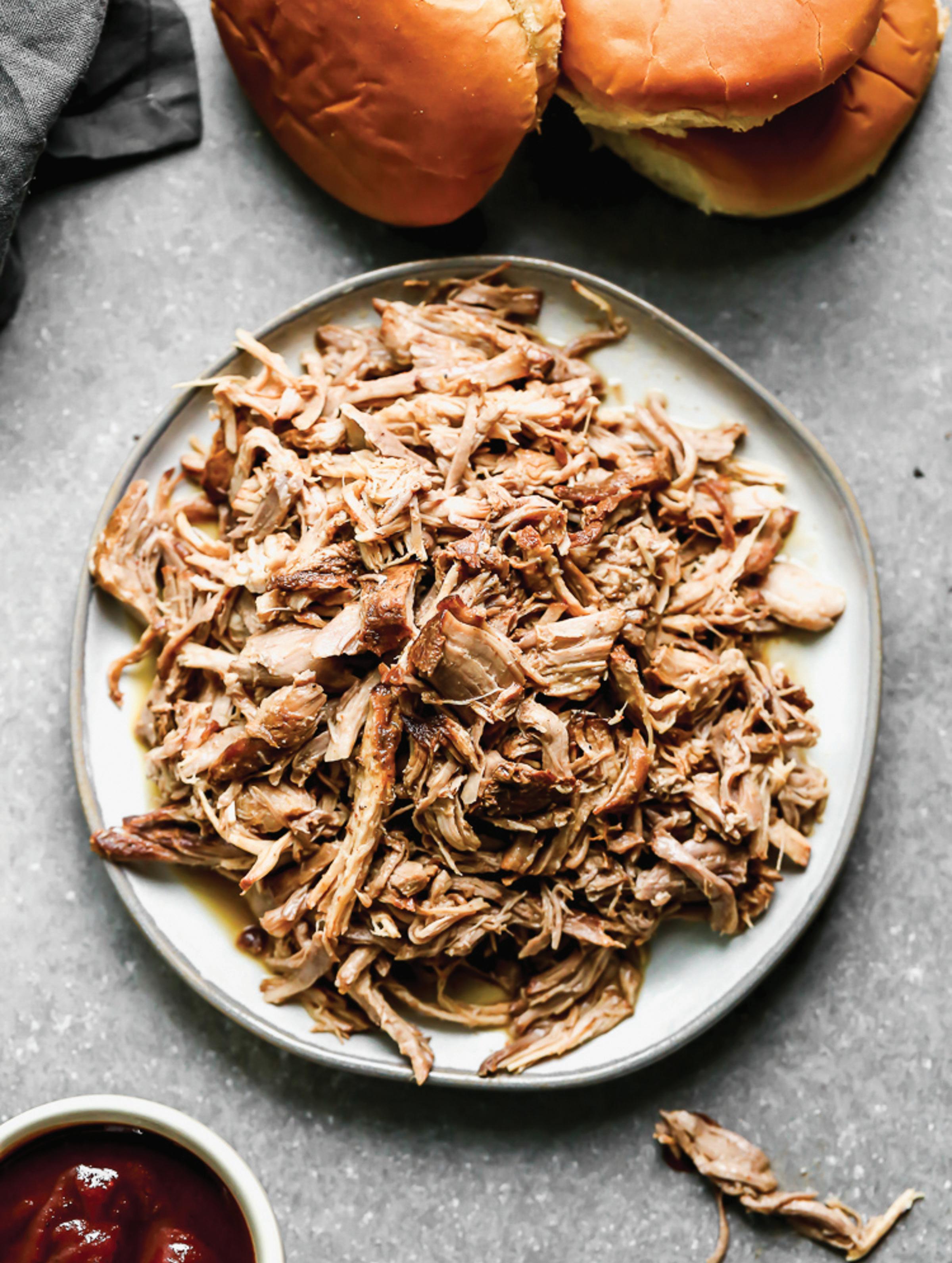
MAKES 6 SERVINGS
RECIPE BY LAUREN ALLEN, TASTES BETTER FROM SCRATCH
This easy recipe is made with pork shoulder (or butt), pantry spices, and Coca-Cola to tenderize the meat and add sweetness to the seasonings. The result is perfect, tender, and juicy pork to serve in a sandwich, with nachos, tamales, tacos, burritos, or quesadillas.
1 (4-pound) pork shoulder, or butt
2 tablespoons oil (optional if searing)
1 tablespoon brown sugar
1 tablespoon chili powder
1 teaspoon onion powder
1 teaspoon garlic powder
1 teaspoon cumin
1 teaspoon kosher salt
1 teaspoon black pepper
1 (12-ounce) can Coca-Cola (not diet; see Cook’s Notes) Barbecue sauce for coating meat (optional)
1. Trim pork of excess fat and cut into 4 pieces.
2. Combine spices in a small bowl and rub all over the pork. (This can be done the night before and refrigerate the pork).
3. Sear (optional): Heat a few tablespoons of oil in a Dutch oven pot over medium-high heat. Add the meat and sear for a few seconds on all sides.
4. Place pork in your slow cooker and pour Coca-Cola around it. Cover and cook on low (recommended) 8 hours or high for 4 to 5 hours, until pork is tender and shreds easily with a fork.
5. Serve it in pulled pork sandwiches (just add barbecue sauce and top with slaw, if desired). Also use atop nachos, in tamales, tacos, burritos, or quesadillas, or stir into baked beans. Serve it with a green salad, fruit, baked beans, potato salad, chips, veggies and dip.
Cook’s Notes
■ The Coca-Cola adds sweetness and tenderizes the meat (diet soda won’t produce as great of results). Root beer would make a good substitute. If you don’t want to use soda, you can substitute another acid, like ½ cup apple cider vinegar mixed with 1 cup apple juice.
■ Store leftover pulled pork in an airtight container in the refrigerator for 2 to 3 days or freeze up to 3 months. If frozen, thaw overnight in the refrigerator.
■ How much pulled pork per person? This recipe will yield about 2 pounds of cooked pulled pork, enough to serve about 6 people (5 ounces per serving). If you want to estimate how much pulled pork you should make for a party or event, keep these two general rules in mind: One pound of pulled pork will feed approximately 3 people (about 5 ounces per serving). Cooked pulled pork will lose about half its weight as it cooks (so a 5-pound raw pork roast will cook down to 2½ pounds of meat).
Nutrition (per serving, pork only): Calories: 310, Fat: 13g (Sat: 5g), Cholesterol: 124mg, Sodium: 554mg, Carb: 9g, Fiber: 1g, Sugar: 7g, Protein: 36g
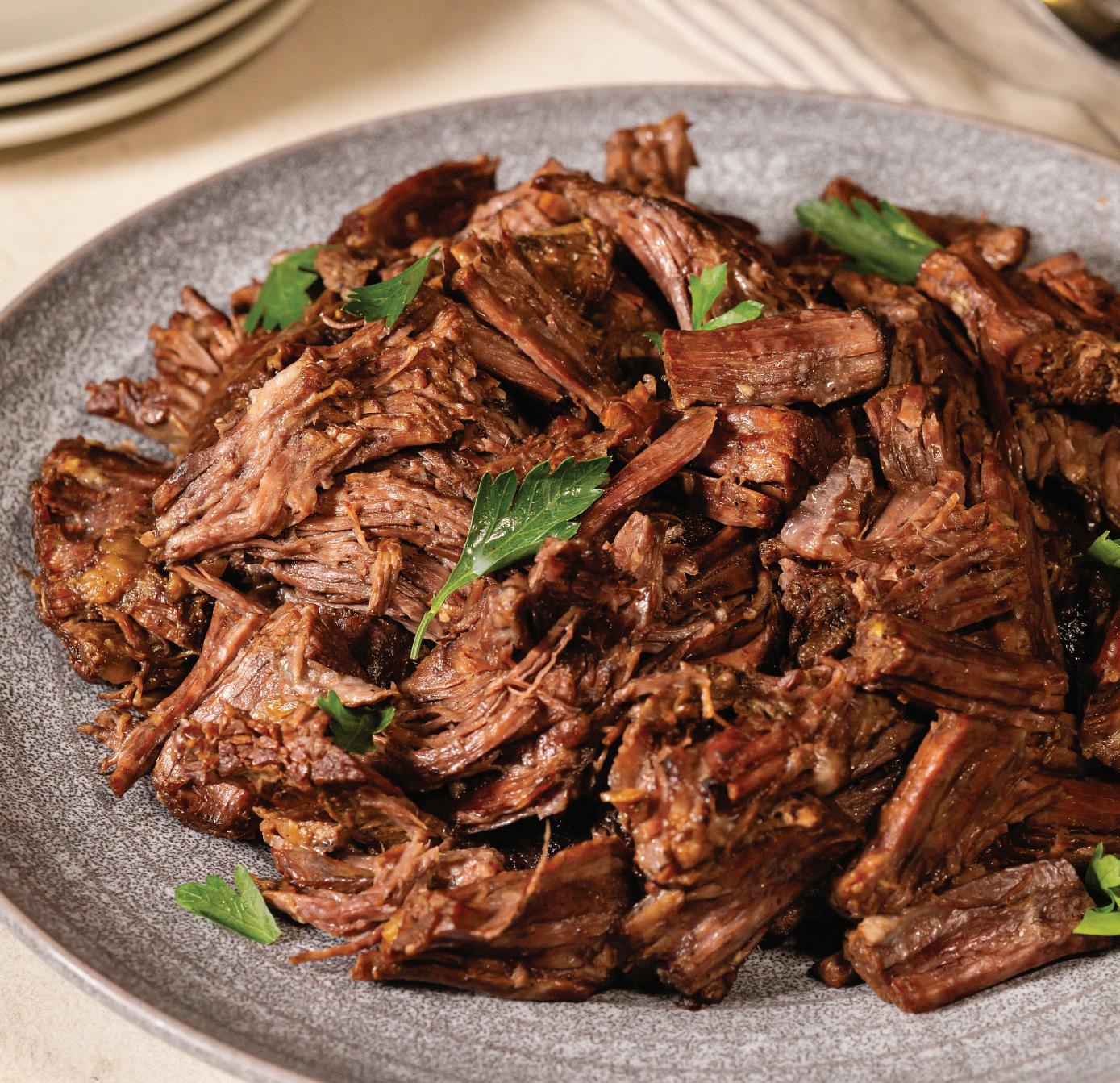

WHAT’S FOR DINNER
Start with this base meat and spice it to your liking for use in a number of meals: Stir in barbecue sauce and serve it on buns, mix in salsa and serve it in tacos, and more.
1 (2-21⁄2 pounds) beef shoulder roast
1 tablespoon vegetable oil (optional)
1 large onion, chopped
2 tablespoons minced garlic
Salt and pepper, to taste
1. For optional browning, heat oil in large nonstick skillet over medium heat until hot. Brown beef shoulder roast on all sides.
2. Place onion and garlic in 31⁄2- to 5- quart slow cooker and place roast on top. Cover and cook on high 5 to 6 hours or low 9 to 10 hours or until roast is fork tender.
3. Remove roast from slow cooker. Skim fat from cooking liquid, if necessary and reserve 1 cup onion mixture. Shred beef with 2 forks. Combine shredded beef and reserved onion mixture. Season with salt and pepper, as desired.
Nutrition (per serving): Calories: 230, Fat: 8g (Sat: 3.5g), Cholesterol: 110mg, Sodium: 125mg, Carb: 3g, Fiber: 0g, Sugar: <1g, Protein: 37g
MAKES 8 SERVINGS (AS SANDWICHES)
RECIPE BY NATASHA KRAVCHUK, NATASHASKITCHEN.COM
This slow cooker chicken is so easy to make—everything just goes into the slow cooker without any special prep. It's fall-apart tender, juicy, and delicious. Serve as-is or in buns with coconut coleslaw and dill pickle chips.
3 pounds (about 5 or 6) boneless, skinless chicken breasts
11/2 cups Homemade BBQ Sauce (see recipe at right), or your favorite store-bought
1/2 medium onion, grated (with juice)
1 tablespoon olive oil
1 tablespoon Worcestershire sauce
2 tablespoons brown sugar
1. Stir together all sauce ingredients in a 5- or 6-quart slow cooker.
2. Add chicken and turn to coat. Cover and cook on high 3 to 4 hours or on low for 6 to 7 hours. Chicken is done when cooked through and easy to shred.
3. Remove chicken to a cutting board and shred each breast using 2 forks. Place shredded chicken back in the slow cooker and stir to coat with the sauce.
Nutrition (per serving, chicken with Homemade BBQ sauce): Calories: 240, Fat: 4g (Sat: 0.5g), Cholesterol: 75mg, Sodium: 420mg, Carb: 20g, Fiber: 0g, Sugar: 18g, Protein: 29g
To make about 4 cups shredded chicken that you can use for any number of meals from tacos or pasta to sandwiches, salads, and more, place 2 pounds (about 4) boneless, skinless chicken breasts and 1 cup stock, broth, or water in a 4-quart or larger slow cooker. Cover and cook 4 to 5 hours on low or 2 to 3 hours on high until the chicken is tender and registers an internal temperature of 165°F. Transfer the chicken to a clean cutting board or large plate, and while it is still warm, use 2 forks to shred the meat. If not using it immediately, store the shredded chicken with some of its cooking liquid to keep it moist. Refrigerate it in an airtight container for up to 4 days or in the freezer for up to 4 months. –M.S.
MAKES 2 1/4 CUPS, ABOUT 20 SERVINGS
11/2 cups tomato ketchup
1/2 cup apple cider vinegar
1/4 cup Worcestershire sauce
3/4 cup packed light brown sugar
2 tablespoons yellow mustard
1 tablespoon paprika or to taste
2 teaspoons onion powder
1 teaspoon ground black pepper, or to taste
4 garlic cloves, minced 1/2 cup water
1. Combine all ingredients in a saucepan, bring to a boil, then lower the heat and simmer uncovered for 30 minutes or until sauce is thickened.
2. Add more sugar or seasonings to taste if desired, then remove from heat. Cool completely to room temperature then cover and store in the refrigerator up to 2 weeks.
Cook’s Note: Right off the heat, you will still be able to smell some vinegar and it will taste a little spicy, but the sauce will mellow out in flavor as it melds in the refrigerator.
MAKES 8 SERVINGS
1/2 cup mayonnaise
1/4 cup coconut milk, original, unsweetened
1 teaspoon horseradish cream sauce
2 teaspoons granulated sugar
2 teaspoons apple cider vinegar or lemon juice
1/2 medium green cabbage, thinly sliced
1/4 small purple cabbage, very thinly sliced
1. In a small bowl or measuring cup, whisk together mayo, coconut milk, horseradish sauce, sugar, and apple cider vinegar or lemon juice.
2. In a medium bowl, combine green cabbage and purple cabbage.
3. Once the dressing is creamy and smooth, pour it over the prepared cabbage and stir well. Just before serving, give it a quick stir to make sure any dressing at the bottom coats the cabbage.
Nutrition (per serving): Calories: 130, Fat: 11g (Sat: 2g), Cholesterol: 5mg, Sodium: 110mg, Carb: 6g, Fiber: 2g, Sugar: 4g, Protein: 1g
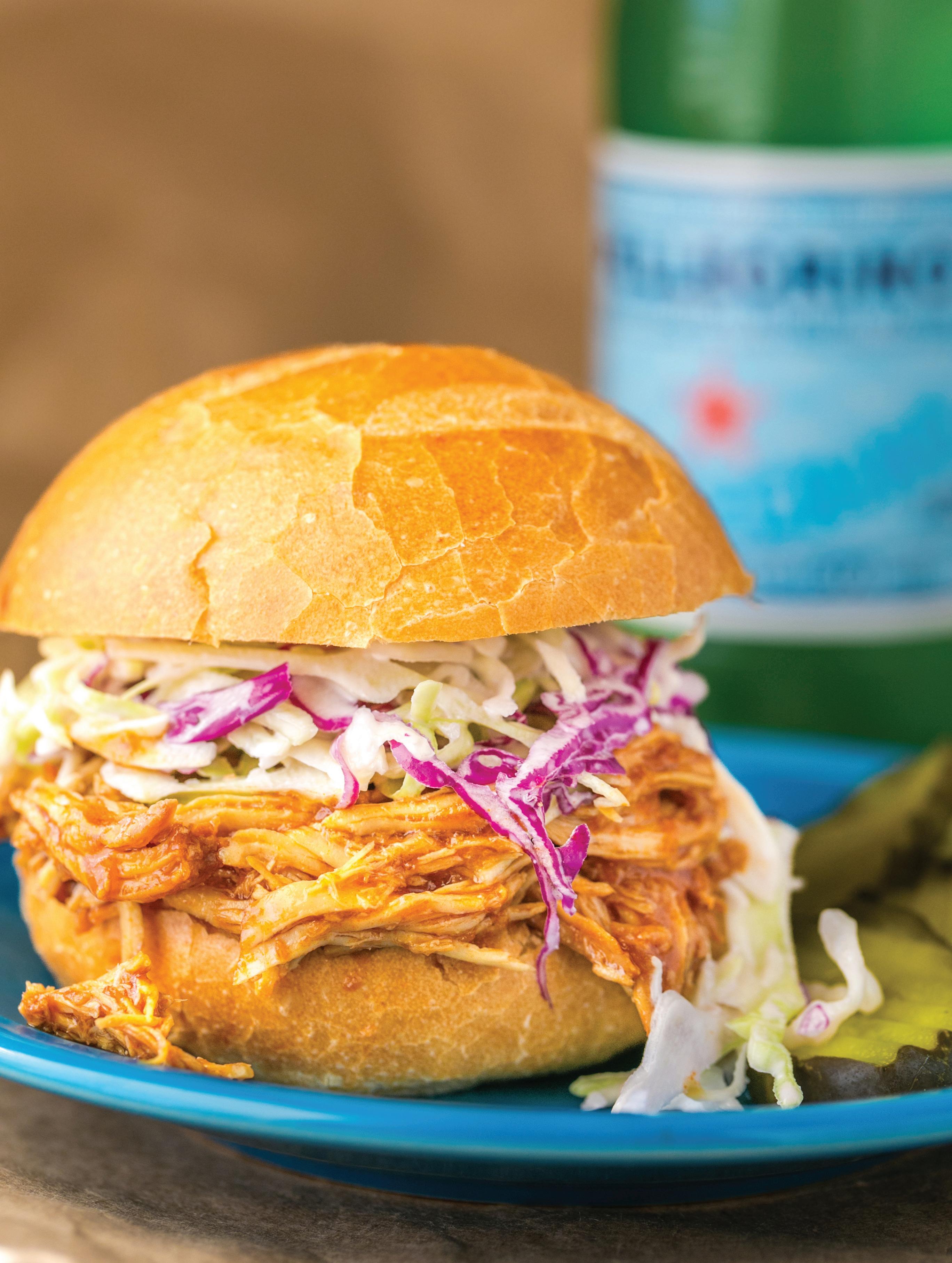
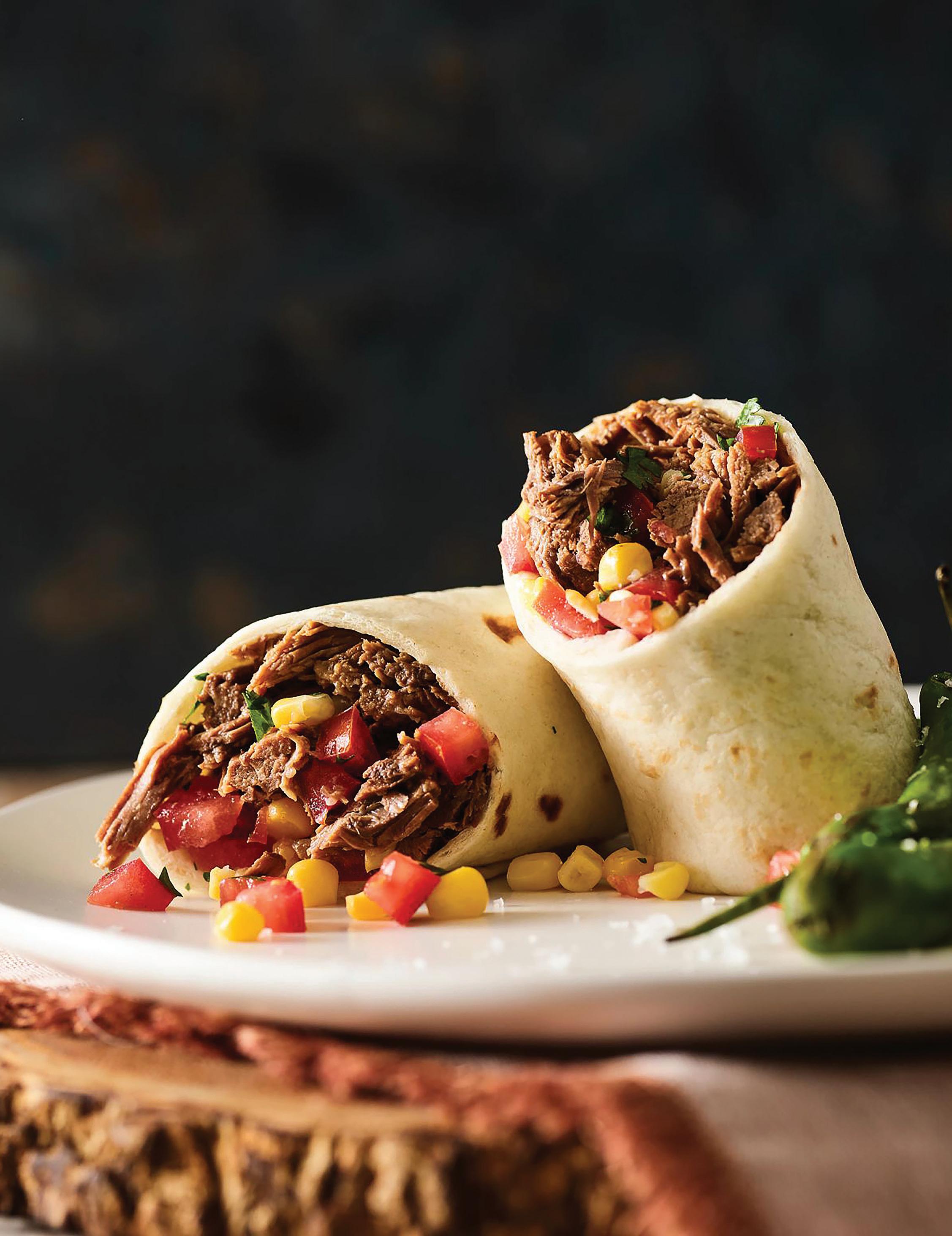
While it might be tempting to lift the lid of your slow cooker to take a peek at your meal’s progress, doing so breaks the seal created by the steam between the lid and the cooking pot. So, each time the lid is lifted, you would need to add an extra 20 minutes to the total cooking time.

Shredded beef gets a punch of flavor from salsa, and a quick tomato-corn relish is folded into a tortilla along with the beef for a hearty handheld meal.
for the beef
1 medium onion, quartered
3 teaspoons minced garlic
1 (2-1/2 to 3 pounds) boneless beef shoulder roast or bottom round rump roast
3/4 cup water
1 teaspoon salt
1/2 teaspoon pepper
2 (16-ounce) jars chunky salsa, divided
8 flour tortillas (10-inch diameter), warmed Fresh cilantro, for garnish (optional)
for the tomato-corn relish
1 cup frozen corn, defrosted
1 cup chopped fresh tomato
2 tablespoons chopped fresh cilantro
1. Cut beef shoulder roast into 4 even pieces. Place onion and garlic in a 41/2- to 51/2-quart slow cooker, and top with beef. Add water, salt, and pepper. Cover and cook on high 5 to 51/2 hours or on low 9 to 91/2 hours or until beef is fork tender. (No stirring is necessary during cooking.)
2. Remove beef and cool slightly. Strain cooking liquid, skim fat, and reserve liquid. Shred beef with 2 forks. Place beef in a 2-quart microwavesafe dish and add 1/2 cup of the reserved cooking liquid.
3. Combine Tomato-Corn Relish ingredients in medium bowl and stir in 1/4 cup salsa.
4. Add remaining salsa to beef and mix well. Cover and microwave on high 8 to 10 minutes or until heated through, stirring once.
5. Top each tortilla with 3/4 cup beef mixture, leaving 11/2 inch border around edge. Top beef with about 1/4 cup relish. Fold right and left sides of tortillas over filling; fold bottom edge over and roll up. Garnish with cilantro, if desired.
Nutrition (per serving): Calories: 444, Fat: 12g (Sat: 3g), Cholesterol: 68mg, Sodium: 1623mg, Carb: 51g, Fiber: 6g, Protein: 32g
RECIPES BY KATHY KORDALIS
Adelicious array of options in the salad category—from leafy greens to vegetable salads, and those that include pasta, grains, beans, eggs, cheese, meat, and seafood— keep things interesting. No matter your favorite base ingredients or toppings, there is bound to be a salad you’ll like that also helps work more healthy veggies into your diet. Plus, they are perfect for summer sides and main meals.
“Since antiquity the restorative green salad has been celebrated,” writes Kathy Kordalis in the intro to her new book, “Sensational Salads.” These earliest salads were wild greens and herbs seasoned with salt, but still a welcome change after a dull winter diet. We’re lucky today to have so many options year-round that go way beyond those simple salads, whether we’re in the mood for something light, substantial, or somewhere in between.
In her energizing salads category, the Miso Brown Rice Salad with Tofu and Ginger Dressing demonstrates simplicity at its best, it travels well, and is as delicious on the day it’s made as the following day, says Kordalis. Try that recipe from the book here, as well as a twist on pasta salad, a main-meal salad popular with some Los Angeles celebs, a juicy sweet and savory Grilled Watermelon and Feta Salad that’s perfect alongside grilled meat and veggies, and a shareable coconut poached shrimp and fish platter with greens and more goodies. With all the flavors, textures, and options, these summer salads won’t disappoint. –mary subialka

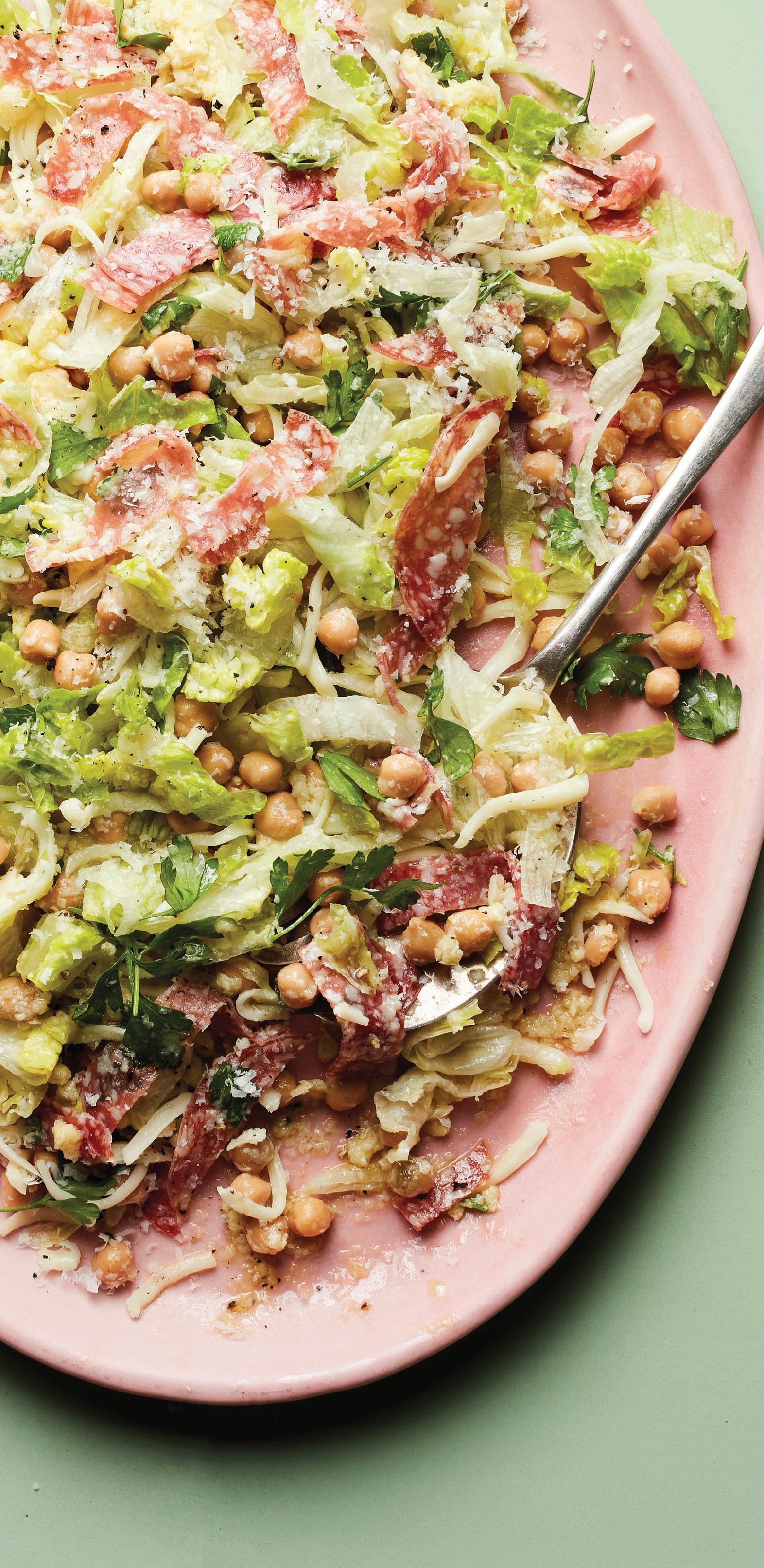
This salad is a classic salad from the Los Angeles institution La Scala. Eaten by all sorts of celebrities and favored by the Kardashians. The lettuce in this salad is best thinly sliced for the dressing to really coat the leaves. It will become a favorite in your home. –Kathy Kordalis
1 iceberg lettuce, sliced
1 romaine lettuce, sliced
1 (14-ounce) can chickpeas/garbanzo beans, drained and rinsed
4½ ounces Italian salami, julienned 3½ ounces mozzarella, grated
1 cup fresh parsley, roughly chopped
for the dressing
⅓ cup extra virgin olive oil
2 tablespoons red wine vinegar
2 teaspoons Dijon mustard
1 cup grated Parmesan cheese, plus extra to garnish
Sea salt and freshly ground black pepper
1. Place the iceberg lettuce, romaine, chickpeas, salami, and mozzarella in a large salad bowl. Set aside.
2. To make the dressing, whisk together the olive oil, red wine vinegar, mustard, salt, and pepper in a measuring cup or a small bowl. Stir in the grated Parmesan.
3. Gently dress and toss the salad and serve with extra Parmesan on top.
Editor’s Note: If desired, use low-fat and/or low-sodium ingredients to reduce calories and sodium per serving or adjust portion size.
Nutrition (per serving): Calories: 1100, Fat: 84g (Sat: 25g), Cholesterol: 115mg, Sodium: 2710mg, Carb: 46g, Fiber: 12g, Sugar: 12g, Protein: 50g

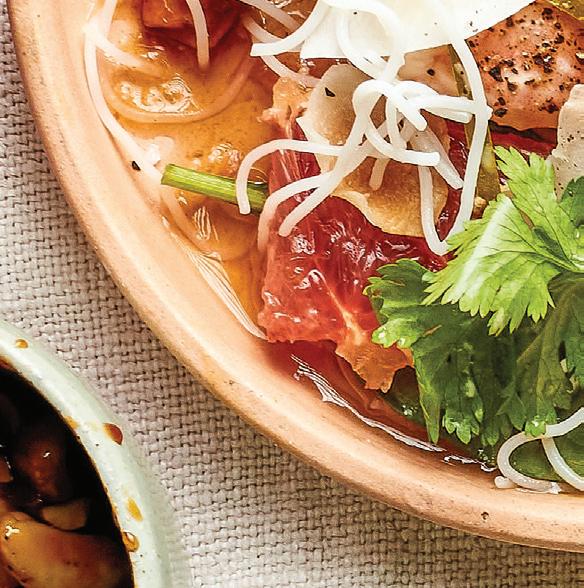
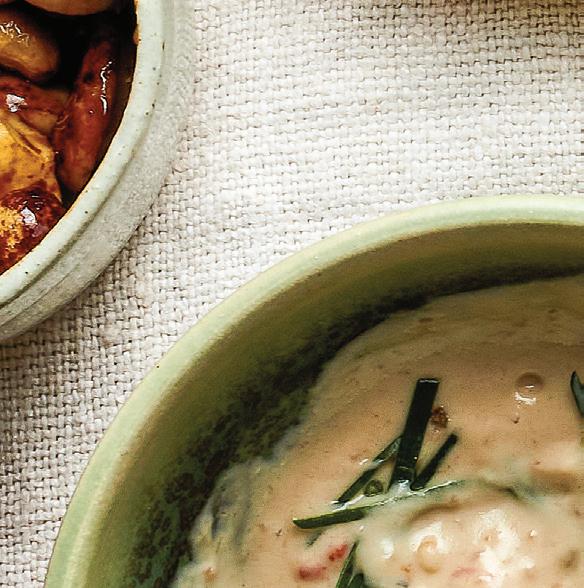



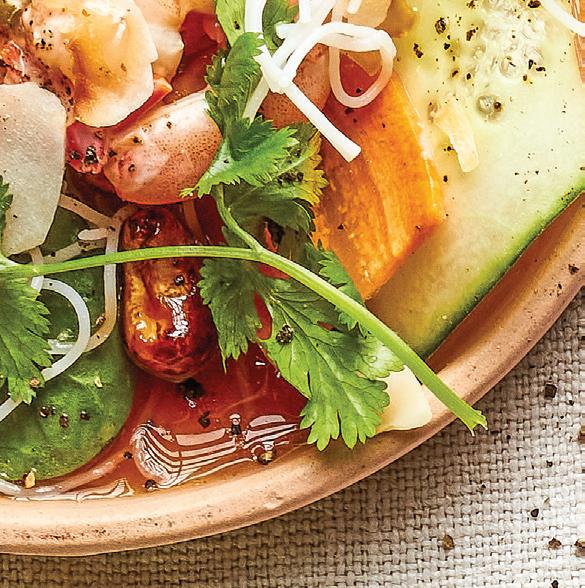
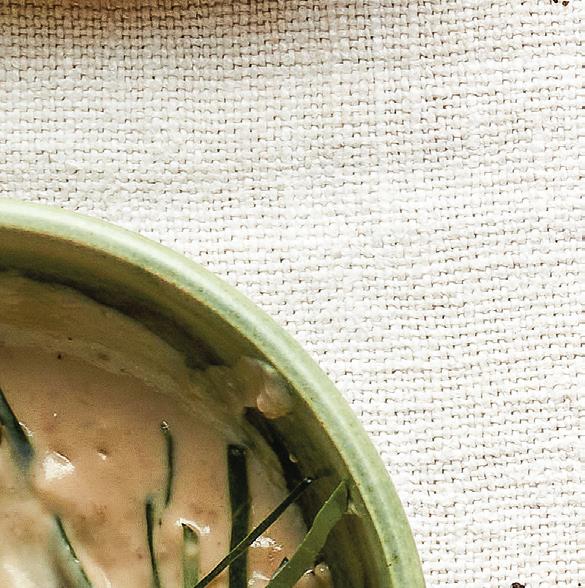

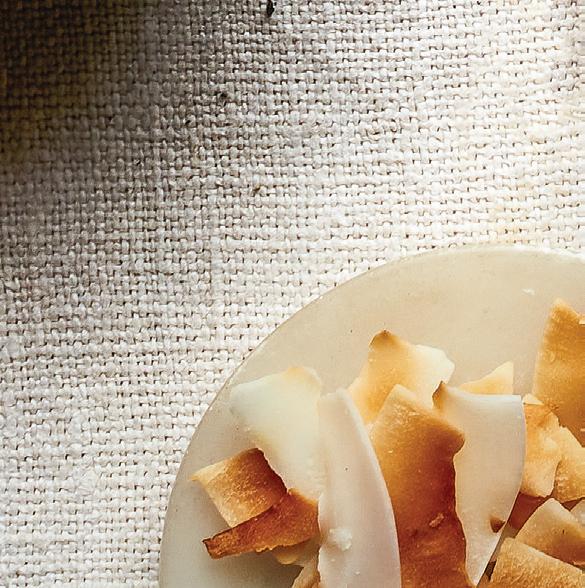

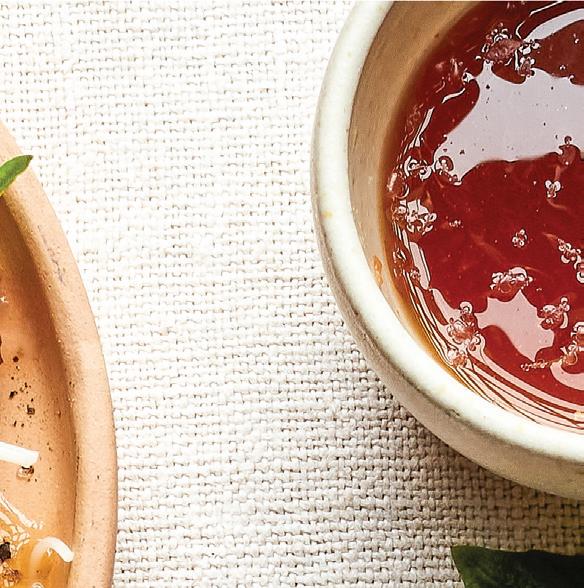
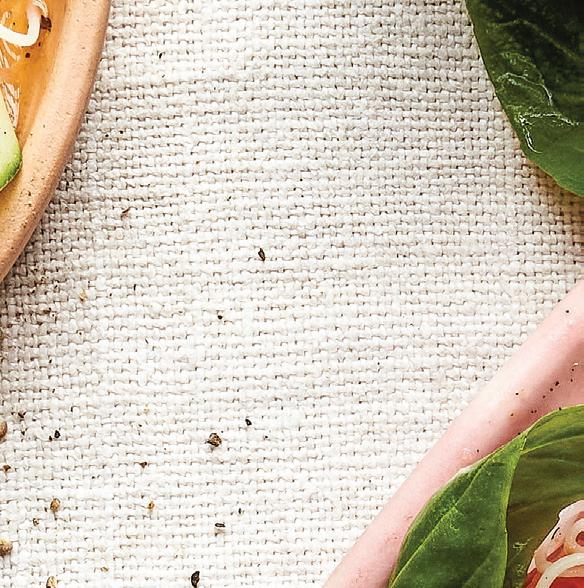
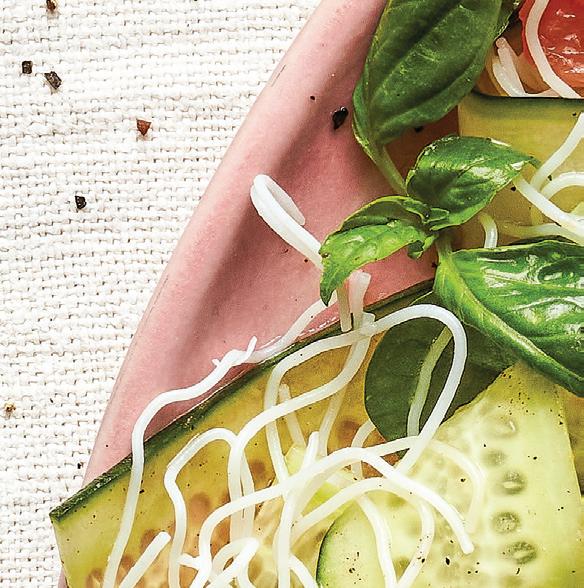
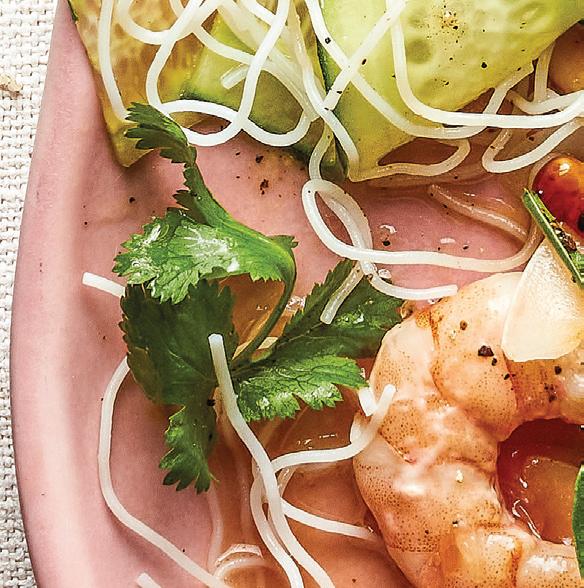

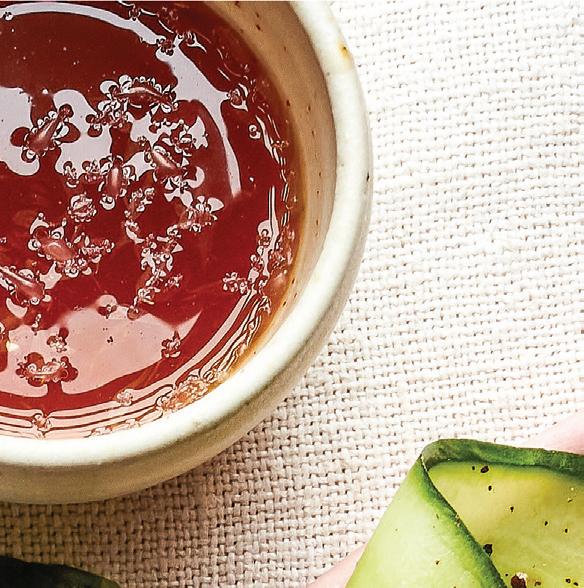

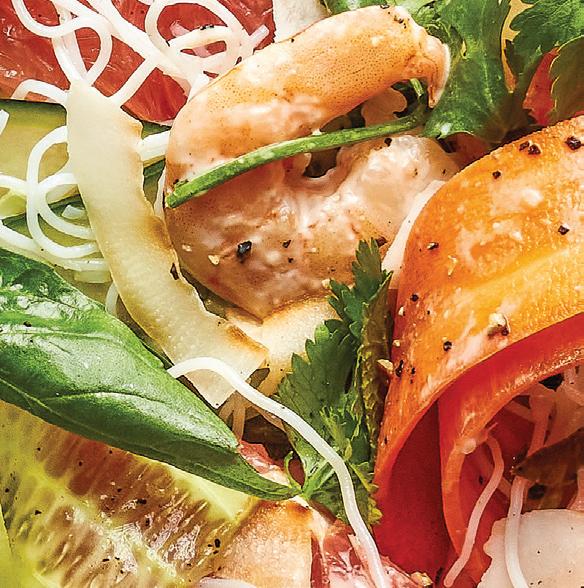
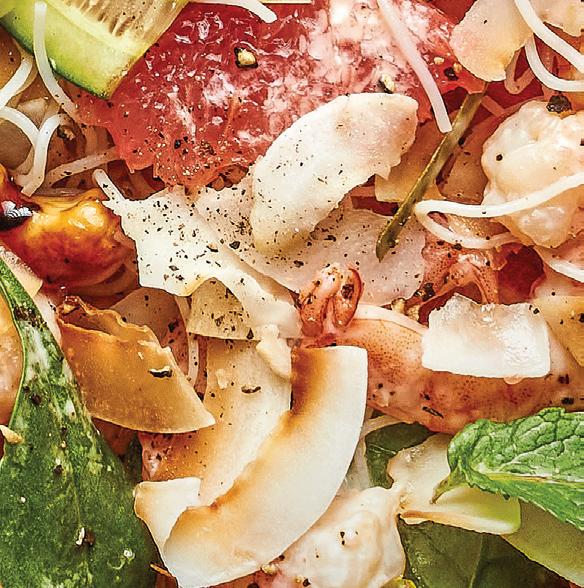



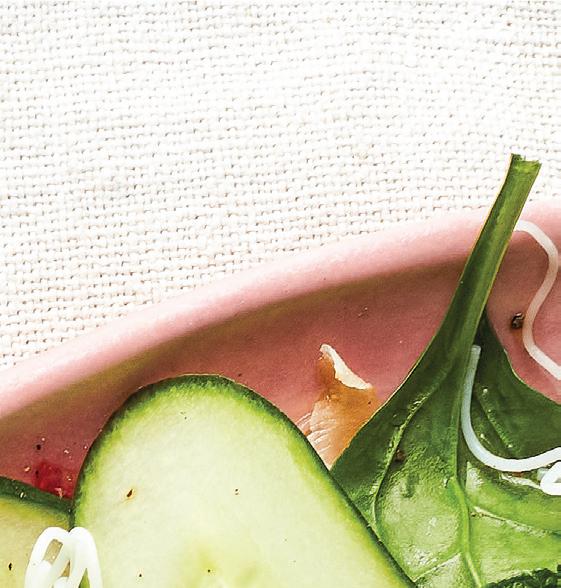

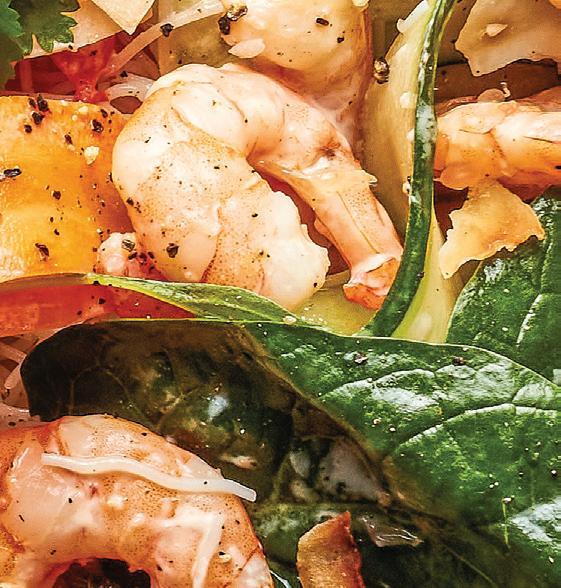
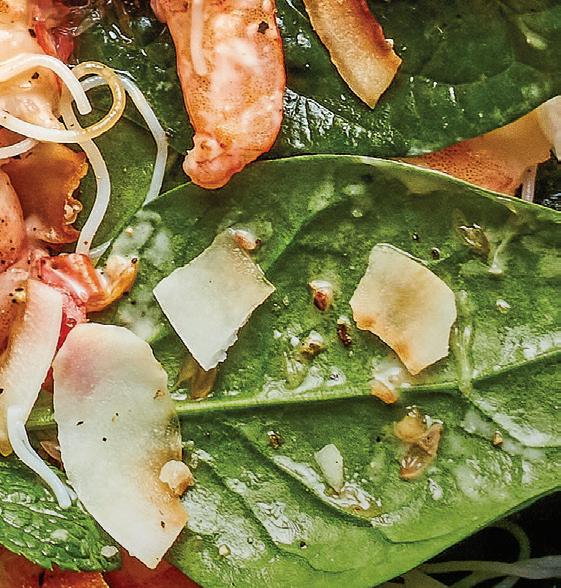
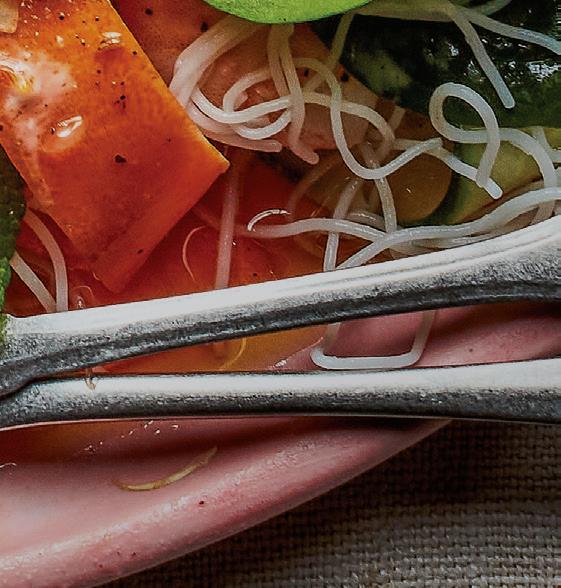




MAKES 2 SERVINGS
This fresh and lively citrus salad makes a gorgeous appetizer, side salad, or delicious lunch. You’ll find it unique and refreshing, and so will your guests. –k.k.
for the shrimp
3½ cups coconut milk
1 tablespoon fish sauce
1 tablespoon soy sauce
¾ ounce galangal, thickly sliced (see Editor’s Notes)
4 lime leaves, thinly sliced (see Editor’s Notes)
2 shallots, thinly sliced
2 small red chilies, thinly sliced, plus extra (optional) to serve
1 lemongrass stalk, bruised
20 uncooked shrimp, peeled and cleaned Grated zest and juice of 2 limes, plus extra wedges to serve
for the dressing Juice of 1 pink grapefruit Juice of 1 lime
3 tablespoons fish sauce
1 tablespoon soy sauce
2–3 tablespoons brown sugar (or to taste)
1–2 teaspoons Thai chili sauce, to taste
for the sticky chili cashews
⅔ cup raw cashews
1 tablespoon flavorless oil
2 tablespoons soy sauce
1 tablespoon honey
1 tablespoon sweet chili sauce
1 teaspoon brown sugar
for the salad
11½ ounces fresh rice noodles, cooked
1 pink grapefruit, peeled and segmented
1 long cucumber, shaved lengthwise
1 carrot, shaved lengthwise
2 cups baby spinach
¾ cup toasted shaved coconut
3 cups mixed Thai or holy basil, mint, and cilantro, leaves picked
1. First, prepare the shrimp. Place the coconut milk, fish sauce, soy sauce, galangal, lime leaves, shallots, chilies, and lemongrass in a saucepan and bring to a simmer over a medium-high heat to infuse for about 8 to 10 minutes. Add the shrimp and simmer for about 1 to 2 minutes until they just begin to color, then remove from the heat. Stir in the lime juice and leave to stand to let the residual heat cook the shrimp through for 1 to 2 minutes. Remove the cooked shrimp and then return the pan to the heat to reduce the cooking liquor (juice) by half.
2. Combine all the dressing ingredients together in a cup, stirring well to dissolve the sugar.
3. For the sticky chili cashews, preheat the oven to 400°F. Place the cashews on a baking sheet lined with baking paper. Drizzle with the oil, soy sauce, honey, sweet chili sauce, and brown sugar and mix well. Bake for 10 minutes, turning once or twice, until sticky.
4. On a platter, place the noodles, grapefruit, cucumber, carrots, spinach, and toasted coconut, then top with the shrimp. Drizzle with the dressing, mix well, and top with the sticky chili cashews and the mixed fresh herbs. Serve some of the cooking liquor on the side.
Editor’s Notes
■ If galangal is not available, fresh ginger root is the best substitute, but it is spicier and less floral than galangal so reduce quantity to ½ ounce.
■ If lime leaves are not available, you can substitute an extra lime, zested, as an alternative.
■ Try using low-sodium ingredients to reduce total sodium per serving, if desired.
Nutrition (per serving): Calories: 1260, Fat: 71g (Sat: 45g), Cholesterol: 90mg, Sodium: 4830mg, Carb: 128g, Fiber: 12g, Sugar: 53g, Protein: 35g
This substantial salad works perfectly as a side dish for a barbecue or large gathering. A little goes a long way, and the tastes combine beautifully when paired with grilled meats. –k.k.
7 ounces orecchiette
2 cups mixed spinach and arugula
1 cup mixed edamame beans, baby peas, and broad beans
2 small cucumbers, quartered lengthwise and chopped
3 spring onions/scallions, finely sliced
⅓ cup fresh flat-leaf parsley, roughly chopped
⅓ cup fresh mint, leaves picked and chopped
2 jalapeños, thinly sliced into rounds
3 tablespoons capers, drained
Grated zest of 1 lemon
3½ ounces artichoke hearts
⅓ cup pumpkin seeds, toasted
½ teaspoon dried hot red pepper flakes (optional)
Freshly grated pecorino, to garnish (optional)
for the dressing
Juice of 1 lemon
1 shallot, finely chopped
1 teaspoon maple syrup
1 teaspoon wholegrain mustard
⅓ cup extra virgin olive oil
Sea salt and freshly ground black pepper
1. Cook the orecchiette in a large saucepan of salted boiling water until al dente. Drain the pasta in a colander, then set aside to drain while you make the dressing.
2. In a serving dish, whisk the lemon juice and zest, shallot, maple syrup, and mustard. Whisking constantly, slowly drizzle in the olive oil until the mixture is emulsified. Season with salt and pepper.
3. In a large bowl, combine the pasta, spinach and arugula, edamame, peas, and broad beans, cucumbers, spring onions, herbs, jalapeños, capers, and lemon zest. Toss together for 1 to 2 minutes, until the spinach and arugula have reduced in volume and becomes slightly wilted.
4. Add the artichoke hearts and pumpkin seeds and toss gently until just combined. Season to taste with salt, pepper, pepper flakes, and pecorino, if using.
Nutrition (per serving): Calories: 500, Fat: 27g (Sat: 4g), Cholesterol: 0mg, Sodium: 270mg, Carb: 53g, Fiber: 6g, Sugar: 8g, Protein: 16g



MAKES 4 SERVINGS
This is a beautifully refreshing summer salad that is ideal for serving at a barbecue party alongside grilled meat and vegetables and perfect for scaling up to feed large crowds. –k.k.
1 (4-inch x 1½-inch) chunk watermelon, skin and seeds removed
½ lemon
½ bunch fresh flat-leaf parsley leaves
½ bunch fresh mint leaves
1½ cups arugula
10½ ounces mixed tomatoes, quartered Extra virgin olive oil, to drizzle
3½ ounces feta, cut into thick slices
Sea salt and freshly ground black pepper, to taste
1. Grease a ridged stovetop griddle pan with cooking oil spray and place over a high heat. Griddle the watermelon and the lemon half, flesh-side down, for about 2 minutes. Carefully turn the watermelon on its side and cook for a further 2 minutes. Remove the lemon from the pan and set aside. Repeat the turning and cooking process on the other side of the watermelon so that all sides are charred.
2. Combine the herbs, arugula, and tomatoes in a bowl. Drizzle with a little olive oil and toss to coat. Season with salt.
3. Place the grilled watermelon on a plate, top with the feta slices, and the herb salad. Season with salt and pepper and serve the grilled lemon on the side for squeezing over.
Nutrition (per serving): Calories: 140, Fat: 9g (Sat: 3.5g), Cholesterol: 20mg, Sodium: 300mg, Carb: 14g, Fiber: 3g, Sugar: 9g, Protein: 6g
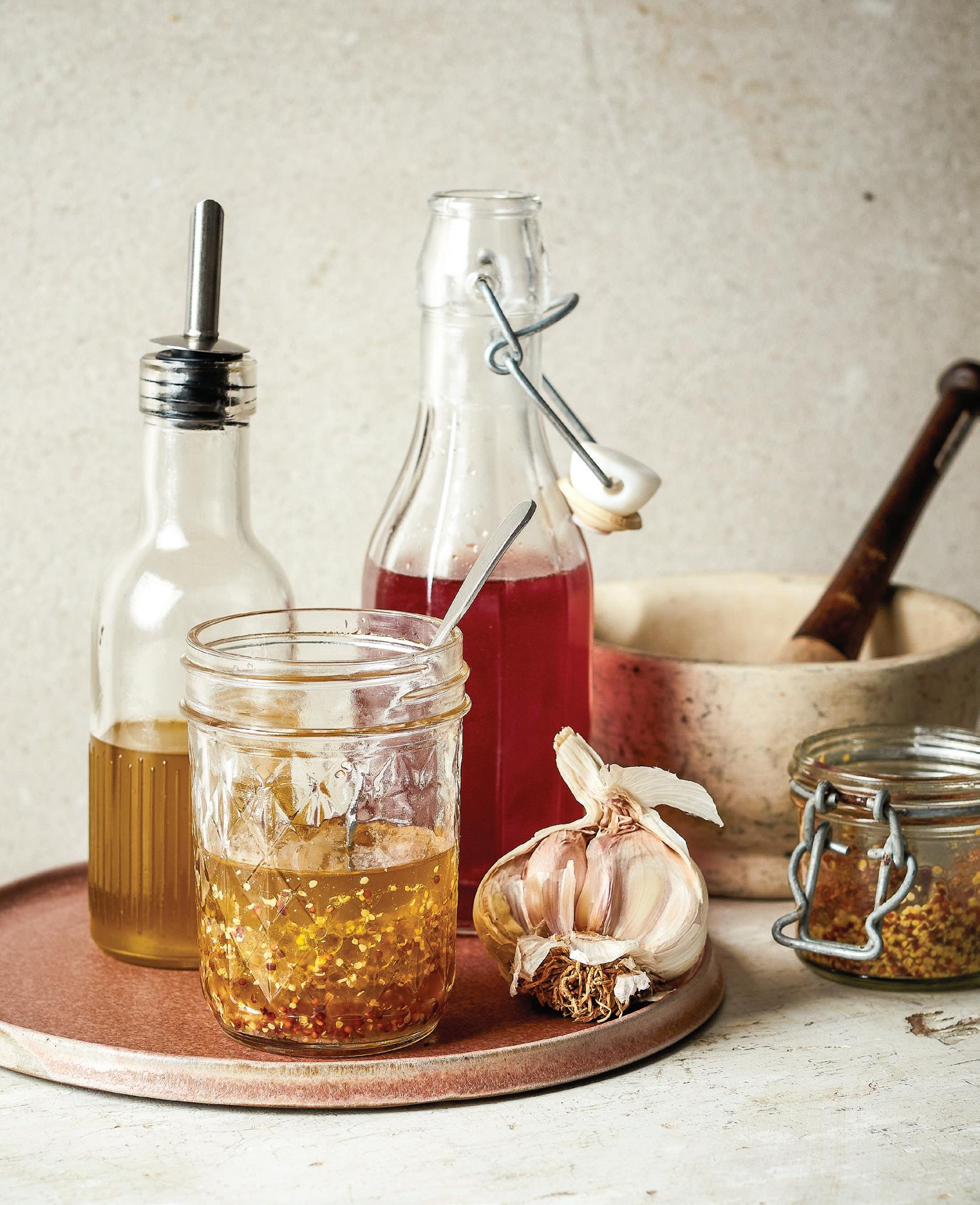
A proper dressing is a mixture of a good oil with some acid, such as vinegar or lemon, maybe some other flavor such as mustard, finely chopped shallots, and salt and pepper. Dressings are elevated with salt and pepper. It truly is the secret to a good dressing. So, you must taste it as you go along.
To master a good dressing, you must understand the mother of all dressings, the basic French vinaigrette. Other salad dressings are derivatives on this basic salt/acid/oil formula with a world of substitutions available to you. Master this standard recipe and you will understand them all. –k.k
you will need:
2 tablespoons good vinegar or 1 tablespoon lemon juice
1 teaspoon Dijon or wholegrain mustard
Pinch of sea salt
6 tablespoons good oil
Other flavors of choice
Sea salt and freshly ground black pepper
Place the vinegar or lemon juice, mustard (to thicken and emulsify), and salt in a glass jar with a screw lid, then tighten the lid and shake vigorously. Add the oil. At this point you can add crushed garlic or finely chopped shallot, to suit your taste. Tighten the lid again and shake until it has thickened. Now, season to taste, which means... taste it, then add salt or vinegar or oil, shake it up, and taste again.
This is a salad packed with nourishing elements that I could eat every day for lunch or dinner. It is definitely one of those dishes that you can make on a Sunday for your prep-ahead lunches. It travels well, and the miso ginger dressing is all it needs for a toasty, savory, and fresh finish. –k.k.
for the salad
1¼ cups (generous) brown sushi rice, cooked according to package instructions
7 ounces edamame beans
3½ ounces radishes, sliced
2 golden beets, grated
Handful of cilantro
Pinch of dried hot red pepper flakes
for the ginger dressing
Thumb-size piece of fresh ginger, grated
4 spring onions/scallions, thinly sliced
3 tablespoons white miso
1 garlic clove, crushed
1 tablespoon rice vinegar
2 tablespoons sesame oil
for the tofu
1 (10½-ounce) pack tofu
Thumb-sized piece of fresh ginger, grated
¼ cup soy sauce
2 tablespoons white miso
2 tablespoons honey
Pinch of hot red pepper flakes
1 tablespoons cornstarch
1. First, make the dressing. Mix all the ingredients together and set aside. Heat the oven to 425°F.
2. Wrap the tofu in paper towels or a kitchen towel and place on a baking sheet. Weigh down with something heavy, like a skillet, and let it sit for 10 minutes. Unpack and unwrap tofu, then transfer to a cutting board and cut into 2-inch cubes.
3. Whisk together ginger, soy sauce, white miso, honey, and pepper flakes. Add tofu and gently toss to coat. Sprinkle all with cornstarch and mix until incorporated. Let sit 10 minutes.
4. Remove the tofu from the marinade and spread the cubes out on a baking sheet lined with baking paper. Bake in the preheated oven for 25 to 30 minutes, turning halfway through, until golden brown and a thin crust forms.
5. Divide the rice between 2 plates, then top with edamame, sliced radishes, beetroot, and roasted tofu. Drizzle with the dressing and finish with cilantro and pepper flakes.
Editor’s Note: Try using low-sodium ingredients to reduce total sodium per serving, if desired.
Nutrition (per serving): Calories: 750, Fat: 28g (Sat: 4g), Cholesterol: 0mg, Sodium: 3330mg, Carb: 90g, Fiber: 14g, Sugar: 35g, Protein: 40g
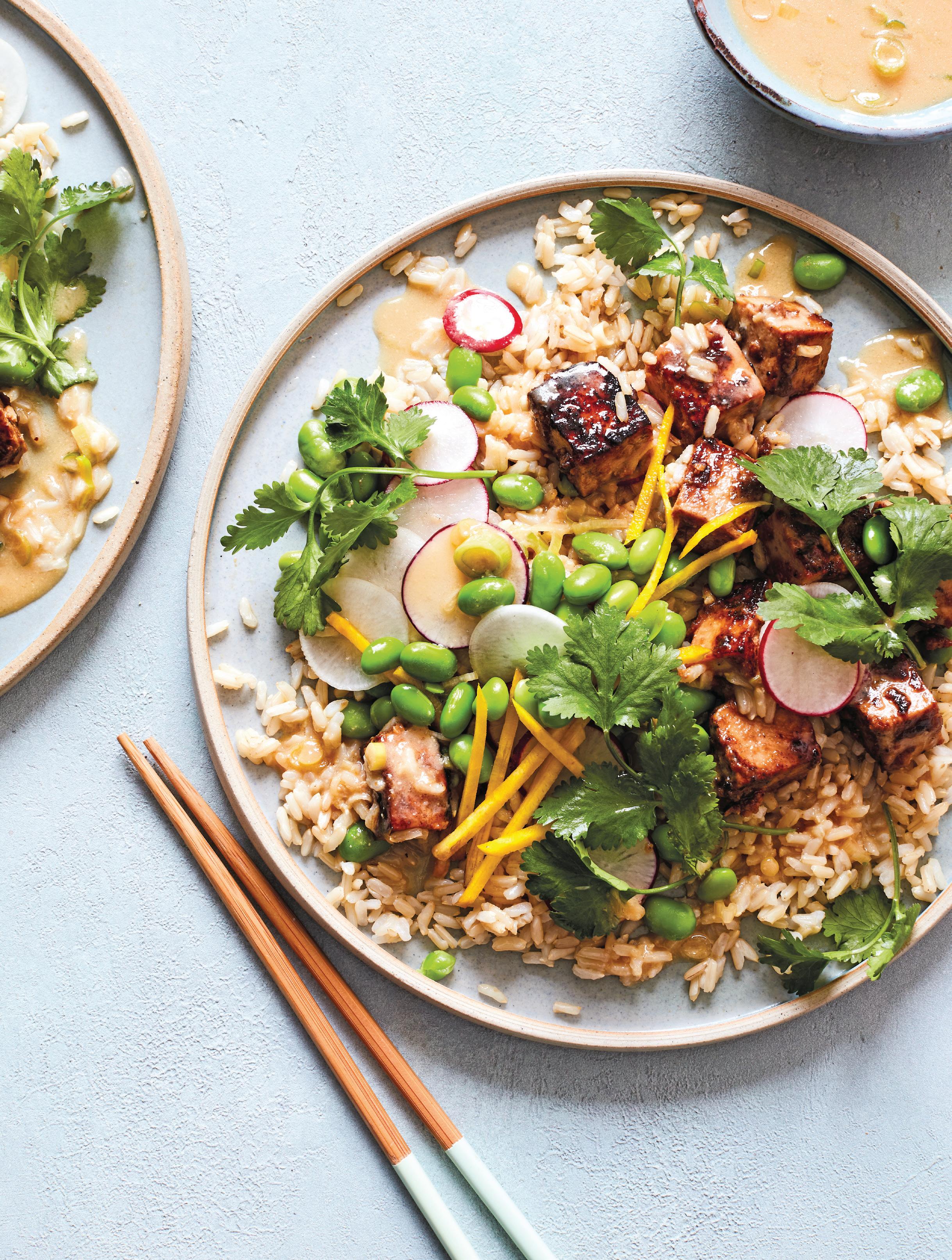
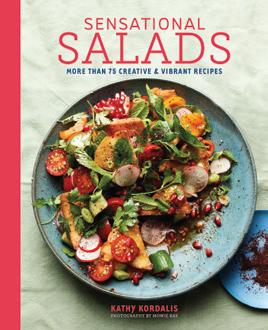

RECIPES AND PHOTOS FROM “SENSATIONAL SALADS: MORE THAN 75 CREATIVE & VIBRANT RECIPES” BY KATHY KORDALIS © 2024 REPRINTED WITH PERMISSION FROM RYLAND PETERS & SMALL. PHOTOS BY MOWIE KAY.

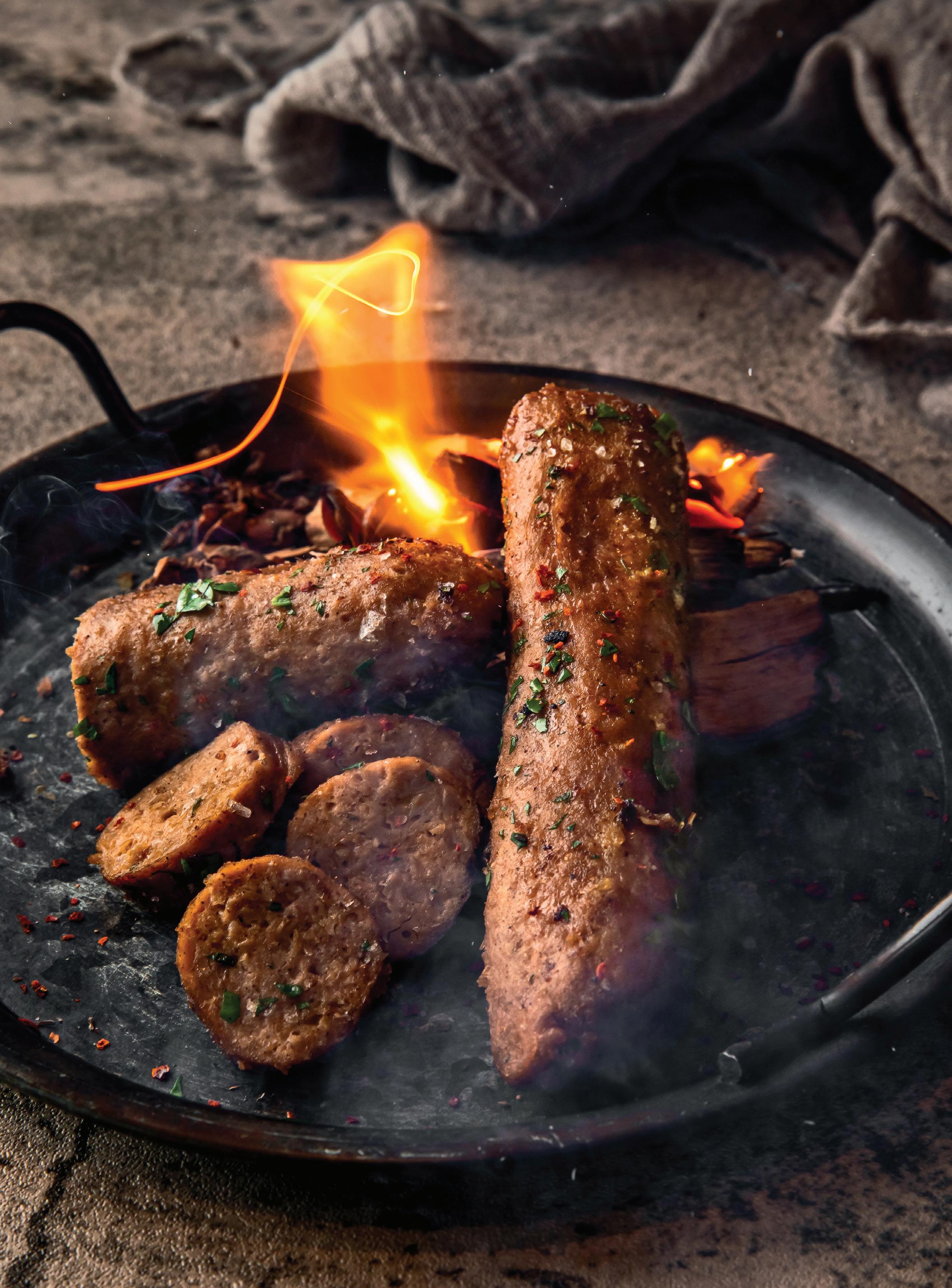
AElevate your barbecue game with innovative plant-based creations and irresistible grilled goodness
RECIPES
s more people embrace plant-based eating for health, environmental, and ethical reasons, chefs and home cooks alike are innovating with creative and delicious vegan dishes. Vegan entrees are no longer just salads; they encompass a wide range of flavorful and satisfying meals, from hearty plant-based burgers to creamy vegan pastas. And when it comes to barbecue, the evolution of a vegan version has been remarkable, with chefs mastering techniques to replicate smoky flavors and juicy textures without using meat. Explore this tantalizing world of meatless wonders with Terry Sargent’s cookbook “Vegan Barbecue.” In this collection of recipes, Sargent shares his journey from a traditional chef to a pioneer in vegan grilling, offering a mouthwatering array of plant-based dishes that capture the essence of barbecue without sacrificing flavor or texture. From smoky “meats” to savory sides, these recipes redefine barbecue, proving that plant-based eating can be just as delicious and satisfying as its meat-centric counterpart. Get ready to fire up the grill and indulge in a feast of innovative and delectable vegan barbecue creations. –alesha taylor
Smoked Beer and Fennel Bratwurst MAKES 5 SERVINGS
Sound the alarms! Summer’s in the air! Once the brats come out and hit the smoker, it’s an official party! These vegan brats are drenched in IPA and spiced with fennel. Add some caramelized onion and serve in a pretzel bun. Game over! –terry sargent
1¼ cups vital wheat gluten
¼ cup nutritional yeast
1 teaspoon fennel seeds
1 teaspoon granulated garlic
1 teaspoon granulated onion
1 teaspoon rubbed sage
½ teaspoon dry mustard powder
½ teaspoon smoked paprika
½ teaspoon kosher salt
½ teaspoon freshly ground black pepper
¼ teaspoon ground allspice
½ cup canned cannellini beans, drained and rinsed
1 tablespoon white miso paste
2 tablespoons soy sauce
1 cup IPA-style beer
¼ teaspoon liquid smoke
1. Combine the wheat gluten, nutritional yeast, fennel seeds, granulated garlic, granulated onion, sage, mustard powder, smoked paprika, salt, black pepper, and allspice in a large bowl. Whisk together until thoroughly combined.
2. Combine the beans, miso, soy sauce, beer, and liquid smoke in a food processor and process until thoroughly mixed and smooth.
3. Add the wet ingredients to dry and mix to form a loose dough. Cover and let rest while cutting 5 large square sheets of aluminum foil and preparing the smoker for a 45-minute smoke session (165°F to 220°F).
4. Pour 1 to 2 inches of water into a baking pan.
5. Cut the dough into 5 equal pieces and shape into logs 5 to 6 inches long. Roll each log in foil and twist edges to seal. (You can use parchment paper in between the brats and the foil if you wish.)
6. Place in the baking pan covered with aluminum foil in the oven and steam for 45 minutes. Remove from the oven and let rest 30 minutes, if you can.
7. Unwrap the brats and place them in the prepared smoker and smoke for 45 minutes. Enjoy out of the smoker, dry fry in a pan, or grill for additional browning.
Nutrition (per serving): Calories: 190, Fat: 1.5g (Sat: 0g), Cholesterol: 0mg, Sodium: 840mg, Carb: 15g, Fiber: 3g, Sugar: 1g, Protein: 26g
MAKES 4 SERVINGS
Another OG classic. The very first recipe I ever attempted when coming over to the “bark” side… tree bark… vegan… nevermind. Just know it’s crazy good. –t.s
for the wet mixture
1 cup Marsala wine
¼ cup tamari
¼ cup pure maple syrup
2 tablespoons hot sauce
3½ cups vegetable stock
1 (8-ounce) can tomato paste
3 tablespoons vegetable oil
for the dry mixture
2¼ cups vital wheat gluten
¾ cup chickpea flour
2 tablespoons chili powder
1 tablespoon smoked paprika
1½ teaspoons ground cumin
2 tablespoons granulated onion
2 tablespoons granulated garlic Vegetable oil
1 tablespoon kosher salt
2 cups Smoky Vidalia VBQ Sauce (see recipe below)
1. Prepare your smoker for a solid 2 hours of smoke time. Prepare a 9x13-inch baking dish by coating lightly with oil. Set aside. Preheat the oven to 375°F.
2. To make the wet mixture, combine the wine, tamari, maple syrup, hot sauce, vegetable stock, tomato paste, and oil in a large bowl and mix well.
3. For the dry mixture, in a separate bowl, combine the wheat gluten, chickpea flour, chili powder, paprika, cumin, granulated onion, garlic granules, and salt. Mix well.
4. Combine the dry mixture with half of the wet mixture. Mix until combined completely. Knead for 3 minutes until all is mixed thoroughly and the dough if firm and elastic. Form into a brisket shape (a rectangle) and place in the prepared baking dish. Lightly coat the raw seitan with oil. Add the remaining wet mixture, pouring it around the baking dish and over the raw seitan.
5. Bake for 25 minutes. Flip the loaf over. Bake for another 20 minutes. A few minutes before it’s done, remove the seitan and baste it with some
MAKES 5 TO 6 CUPS
Grass VBQ’s original barbecue sauce, named for our home state’s venerable sweet onion. Invented out of love and still the staple of the GVBQ sauce line. –t.s.
1 tablespoon canola oil
2 medium sweet onions (about 1 pound), preferably Vidalia, diced 2½ cups ketchup
½ cup apple cider vinegar
¼ cup honey
2 tablespoons fresh lemon juice
2 tablespoons vegan Worcestershire sauce
2 tablespoons Dijon mustard
½ teaspoon freshly ground black pepper
Pinch of cayenne pepper, to taste
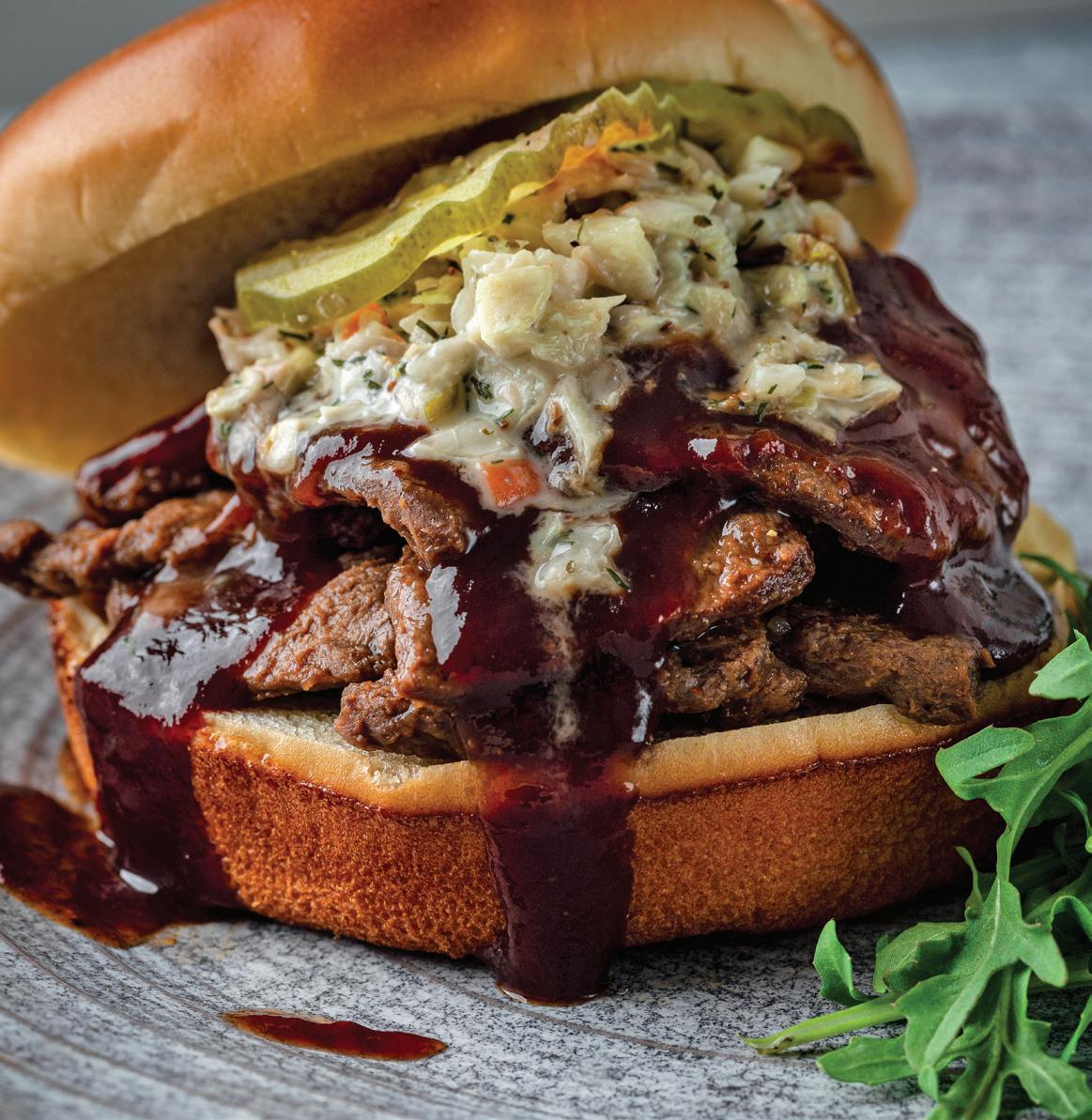
of the remaining liquid in the dish. Return to the oven for another 5 to 10 minutes. The liquid should be almost evaporated and thickened.
6. Remove the brisket from the oven and leave to cool for a few minutes. Cover the seitan with the barbecue sauce, being sure it coats all sides well. Place in the smoker and smoke for 1 hour on each side over low heat.
7. Remove from the smoker. Slice the brisket as thin as you can and serve with all your desired fixins’!
Nutrition (per serving): Calories: 670, Fat: 13g (Sat: 1.5g), Cholesterol: 0mg, Sodium: 3250mg, Carb: 87g, Fiber: 9g, Sugar: 36g, Protein: 57g
MAKES ABOUT 1¼ CUPS
I put this stuff on… everything! There’s nothing more universal than a good spice rub. This rub literally tastes great on vegetables, mock meats, even juicy fruits! It is guaranteed to be a staple in the spice cabinet. –t.s.
½ cup packed light brown sugar
½ cup smoked paprika
1 tablespoon freshly ground black pepper
1 tablespoon smoked kosher salt
1 tablespoon granulated garlic
1 tablespoon granulated onion
1 teaspoon cayenne pepper
1 teaspoon stout beer powder (optional)
1. Heat the oil in a large saucepan over medium heat. Add the onions and cook, stirring often, until translucent, 3 to 5 minutes.
2. Add the ketchup, cider vinegar, honey, lemon juice, Worcestershire, mustard, black pepper, and cayenne. Bring to a boil over high heat.
3. Reduce the heat to maintain a low simmer and cook, stirring occasionally, for 30 minutes.
4. Serve hot or at room temperature. Store extra in an airtight container in the refrigerator for up to 1 month.
Nutrition (per 1 Tbsp.): Calories: 15, Fat: 0g (Sat: 0g), Cholesterol: 0mg, Sodium: 70mg, Carb: 3g, Fiber: 0g, Sugar: 2g, Protein: 0g
1 tablespoon ancho chile powder
Combine the ingredients in a medium mixing bowl and whisk together. A wire whisk works best to incorporate air and remove lumps. Store in an airtight container at room temperature or keep in the freezer in a sealed zippered bag for up to 3 months.
Nutrition (per 1 Tbsp.): Calories: 15, Fat: 0g (Sat: 0g), Cholesterol: 0mg, Sodium: 370mg, Carb: 4g, Fiber: 0g, Sugar: 4g, Protein: 0g
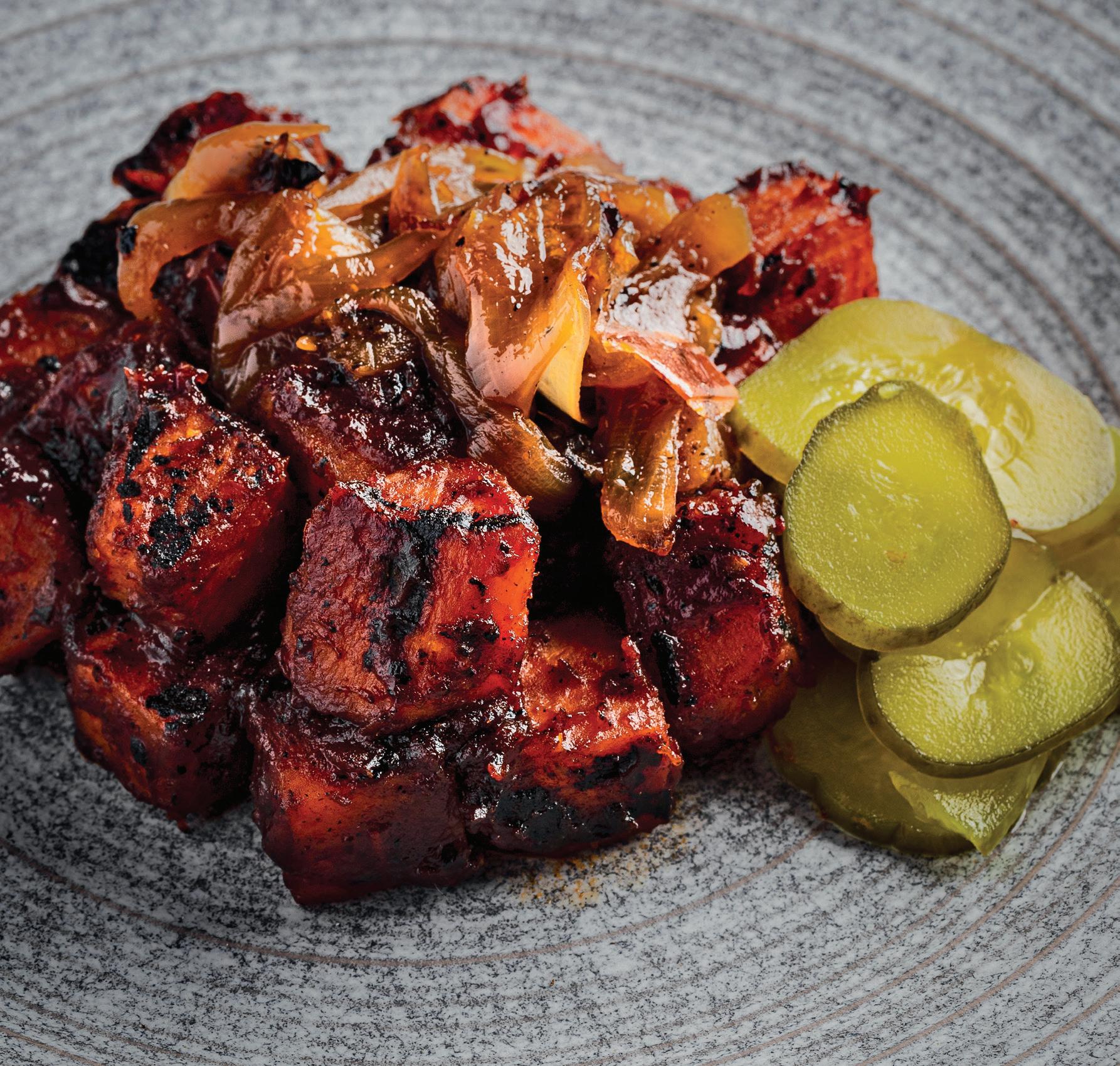
MAKES 4 SERVINGS
Here in the South, burnt ends aren’t really a staple in our pits. That honor belongs to Kansas City! Putting a little twist on ours, we’re using the mighty sweet potato. It gives us that dense meaty texture we’re looking for when it comes to burnt ends. Plus, the bonus sweetness it adds complements any kind of barbecue rub or sauce. –t.s.
2 pounds sweet potatoes, cut into ¼-inch pieces
1 sprig fresh thyme
3 cloves garlic
1 tablespoon kosher salt
2 tablespoons fresh lemon juice
1 tablespoon liquid smoke
3 tablespoons vegetable oil ¾ cup Signature VBQ Spice Rub (see recipe, page 48)
1 cup Smoky Vidalia VBQ Sauce (see recipe, page 48) ¼ cup sliced scallions, green and white parts
1. Combine the sweet potatoes with 4 quarts water in a large stockpot. Add the thyme, garlic, salt, lemon juice, and liquid smoke. Bring the water to a boil, then reduce to a simmer. Cook until fork tender, about 30 minutes.
2. Remove the potatoes from heat and drain. Discard the thyme and garlic. Allow the potatoes to cool to the touch. Toss the potatoes gently with oil in a large bowl; try not to break potatoes during tossing. Liberally sprinkle the spice rub over the potatoes. Be sure to coat as evenly as possible.
3. Arrange the potatoes on aluminum foil-lined smoker and smoke at 85°F to 120°F for 20 minutes.
4. Remove the potatoes from the smoker and arrange on a serving dish. Pour the sauce over the potatoes or serve on the side for dipping, garnish with the scallions, and serve.
Nutrition (per serving): Calories: 260, Fat: 11g (Sat: 1.5g), Cholesterol: 0mg, Sodium: 3190mg, Carb: 41g, Fiber: 3g, Sugar: 23g, Protein: 2g
MAKES 4 SERVINGS
Our signature dish at the shop! The smoke really drives through the entire dish and combines beautifully with the smooth cheese sauce. –t.s.
2 cups raw cashews
16 ounces large elbow noodles or other pasta
2 teaspoons granulated garlic
2 teaspoons granulated onion
½ teaspoon chili powder
½ teaspoon smoked paprika
2 teaspoons kosher salt
2 teaspoons yellow mustard
1. Heat the oven to 375°F.
1 cup nutritional yeast
3 cups unsweetened oat milk, divided
1 tablespoon unsalted vegan butter
½ cup panko breadcrumbs
1 teaspoon dried thyme
2 cups shredded vegan mozzarella
2. Bring a large pot of salted water to a rolling boil for the pasta. Carefully scoop out 1 cup of water and pour it into a smaller bowl over your cashews. Soak the cashews for 15 minutes until soft.
3. Cook the pasta for 7 minutes, until al dente (or according to the package directions for al dente). You don’t want your pasta to be fully cooked, as it will continue to cook as it bakes. Drain and set aside.
4. Stir together the granulated garlic, granulated onion, chili powder, paprika, and salt in a small bowl.
5. Drain the cashews and transfer to a blender or food processor. Add in the mixed spices, nutritional yeast, and 2 cups of the oat milk. Blend on high speed until creamy. Add the remaining 1 cup of oat milk and blend again. The mixture will be thin, but this is correct!
6. Toss the pasta with the vegan cheese sauce and vegan mozzarella, then pour the mixture into a large rectangular baking pan. Set aside.
7. To make the breadcrumb topping, heat the vegan butter in a small saucepan over medium heat. Add in panko breadcrumbs and thyme and cook for 2 to 3 minutes until fragrant and lightly golden. Sprinkle over the macaroni.
8. Bake for 10 minutes, then remove from the oven and allow to cool slightly.
9. Prepare the smoker for a 30-minute smoke session over low heat.
10. Place the mac ‘n’ cheeze pan in the smoker and smoked uncovered for 30 minutes. Remove from smoker and serve immediately.
Nutrition (per serving): Calories: 1150, Fat: 46g (Sat: 10g), Cholesterol: 0mg, Sodium: 1760mg, Carb: 150g, Fiber: 14g, Sugar: 11g, Protein: 39g
MAKES 6 TO 8 SERVINGS
Carrot… dawgz?? YES, carrot dawgz. This is always my sleeper go-to when I need to bring a dish to a cookout. Carrots and other root vegetables are dense and hearty enough to work as meat substitutes. With just the right amount of smoked flavor, these root vegetables can be the best guilt-free stadium food you ever had. Pair these bad boys with some nice hearty potato salad. –t.s.
6-8 carrots, peeled
¼ cup soy sauce
¼ cup apple cider vinegar
2 tablespoons pure maple syrup
1 tablespoon liquid smoke
1 teaspoon yellow mustard
1 teaspoon minced garlic
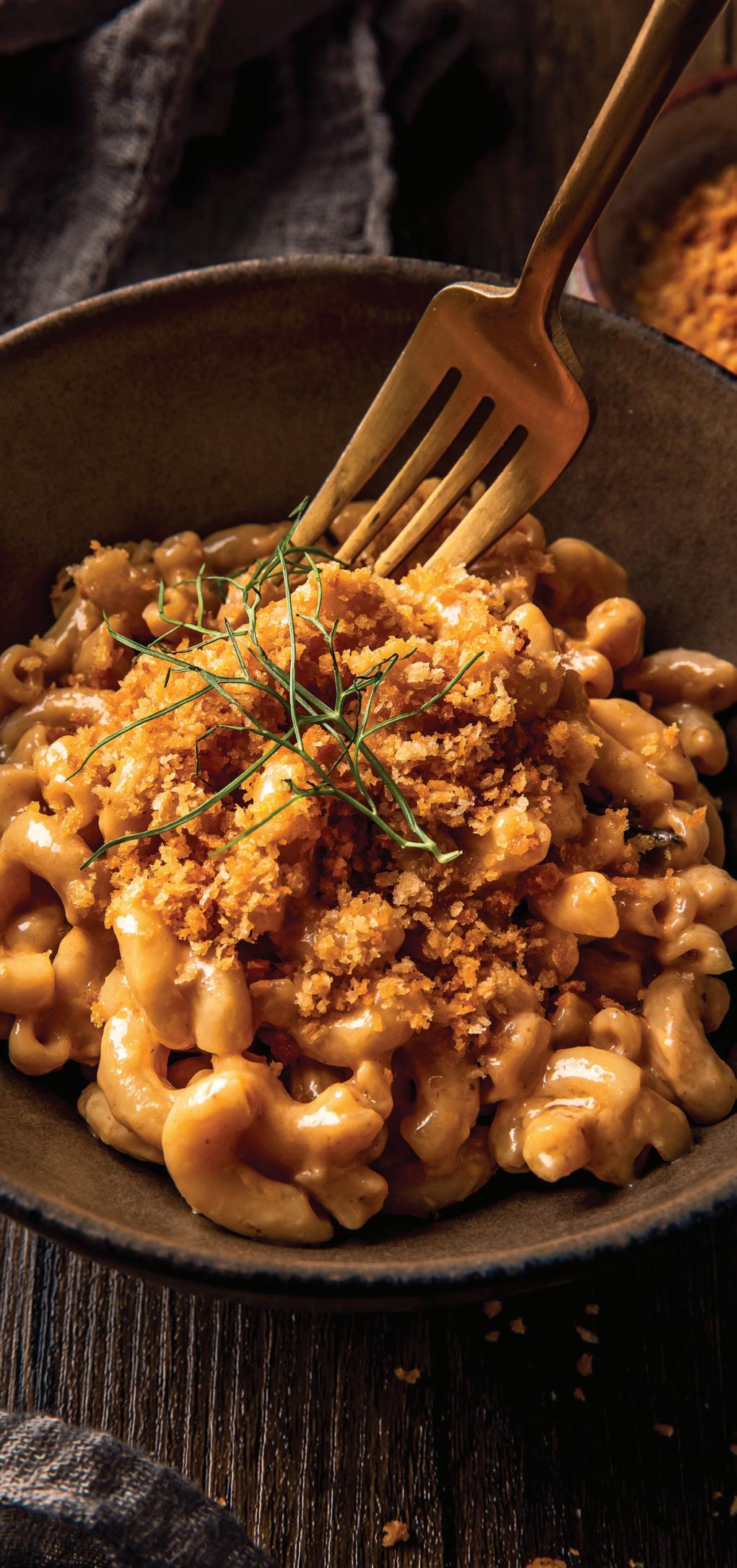
1. Use a peeler to shape the carrots into hot dog shapes and cut to the length of the buns.
2. Bring a medium pot of salted water to a boil, add the carrots, and boil until fork tender, about 10 minutes. Drain the carrots and rinse with cold water until cooled. Place in a zippered bag.
3. Whisk together the soy sauce, cider vinegar, maple syrup, liquid smoke, mustard, garlic, granulated onion, and salt and pour into the bag with the carrots. Marinate for at least 4 hours; overnight is better. The longer they marinate, the more “dawg” flavor.
1 teaspoon granulated onion
1 teaspoon kosher salt
to serve
1 tablespoon vegetable oil
6-8 hot dog buns
Toppings, such as slaw and vegan Cincinnati chili
4. Remove the carrots from the bag and pat dry. Prepare the dawgz at 85°F to 120°F for 20 minutes.
5. To serve, heat the oil in a skillet over medium heat. Sear the dawgz until browned all over. Slip into buns and top your dawgz with all of your favorite toppings.
Nutrition (per serving): Calories: 180, Fat: 3.5g (Sat: .5g), Cholesterol: 0mg, Sodium: 980mg, Carb: 32g, Fiber: 3g, Sugar: 9g, Protein: 6g
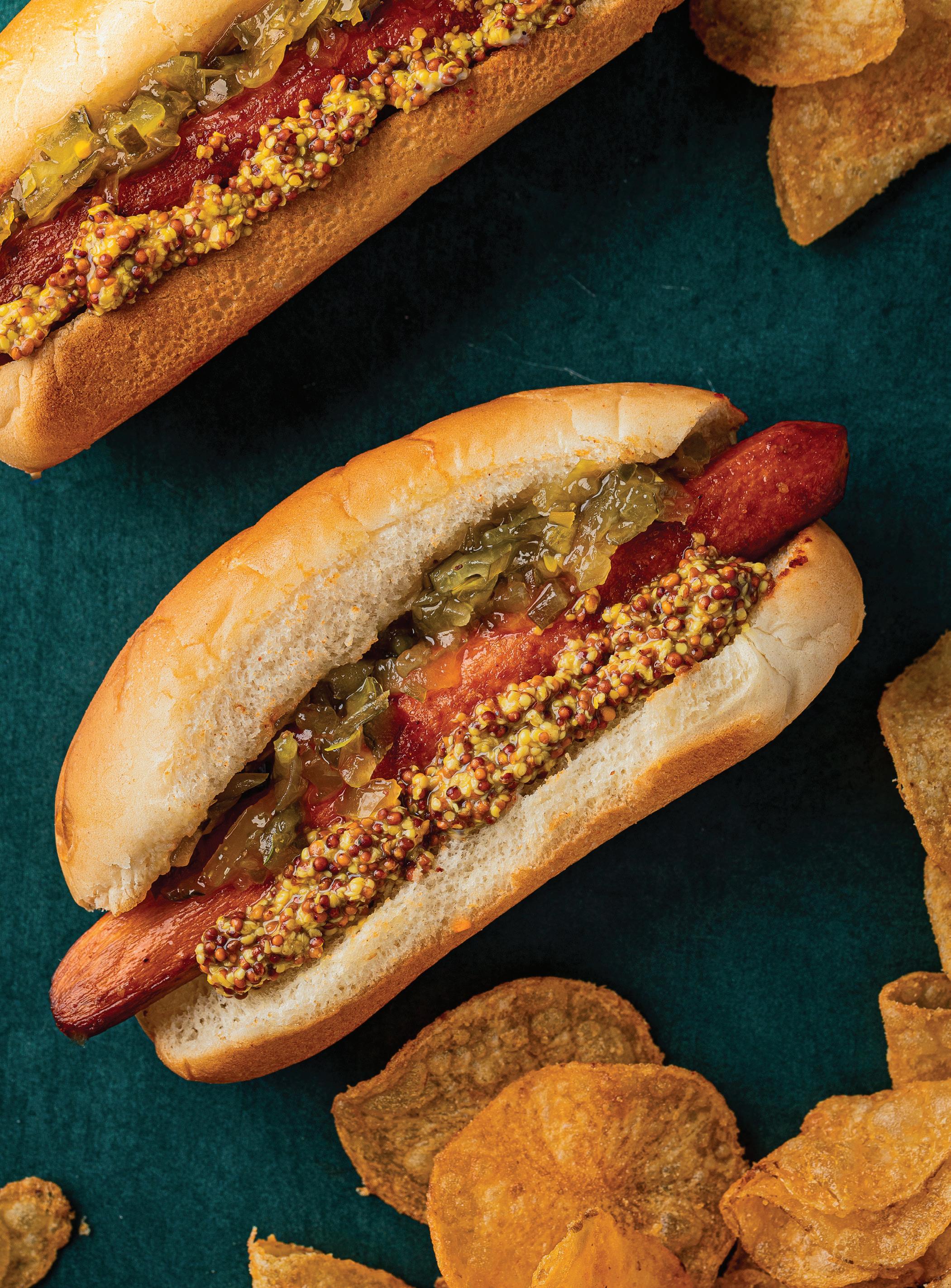


RECIPES AND PHOTOS FROM “VEGAN BARBECUE: MORE THAN 100 RECIPES FOR SMOKY & SATISFYING PLANTBASED BBQ” BY TERRY SARGENT, ©2023
REPRINTED WITH PERMISSION FROM THE QUARTO GROUP.
Fresh off the release of his new book “Everyday Delicious,” chef Rocco DiSpirito reflects on food, family, and a life in the kitchen
BY EMMA ENEBAK
If you owned a television set in the early aughts, then it is likely you have heard of chef Rocco DiSpirito. The James Beard Award-winning chef, media personality, and a No. 1 New York Times best-selling cookbook author is hardly a name that needs introduction. At the height of his fame, DiSpirito appeared on everything from “Dancing with the Stars” to “Days of Our Lives” and “The Ellen DeGeneres Show.” He has authored 14 cookbooks, headed a three-star restaurant, and was even named People’s “Sexiest Chef Alive” in 2003. But despite all this public exposure, there seems to be a cloud of mystery surrounding DiSpirito’s career. Since largely retreating from the restaurant industry in the early 2000s, his professional life has been a matter of considerable public scrutiny—a quick Google search will generate headlines like “What Happened to Chef Rocco DiSpirito?” and “Where is Rocco DiSpirito Now?” The question may seem complicated, but the answer is actually quite simple: DiSpirito is still in the kitchen—he never left.
His latest cookbook “Everyday Delicious” makes this abundantly clear. Filled with 30-minute “(ish)” home-cooked meals, the book gets back to DiSpirito’s basics, celebrating the simple joy of cooking for and with the people he loves most.
“It’s really a reminder that the most wonderful kind of cooking, and the best part of life, is the time you spend at the table every day with friends, family, and loved ones,” DiSpirito shares.
It is a concept that harkens back to his Italian American roots before his career launched him into the public eye, and his encounters with food were limited to his busy family kitchen in the Jamaica neighborhood of Queens, New York. Growing up in a big immigrant family (including his parents and two siblings),
food was a cornerstone of DiSpirito’s daily life. After settling in the U.S. in the 1950s, his parents re-created their familiar Italian farming lifestyle in the heart of New York—raising everything from rabbits to pigeons and growing vegetables year-round to cook each meal from scratch.
“Some of my earliest memories are of my mom making prosciutto from scratch in our kitchen,” DiSpirito says. “It wasn’t until later on in my 30s that I realized what a tremendous gift it all was—what a treasure.”
It seems only fitting that this food-centric upbringing led him to attend the Culinary Institute of America at the age of just 16. DiSpirito then climbed the rungs of the culinary world quickly, acquiring a knack for fusion cuisine and working with renowned chefs including Jonathan Waxman and David Bouley. He soon became executive chef of Union Pacific, a three-star restaurant that dominated New York City at a time DiSpirito calls “the glory days of New York fine dining.” The opening of his next restaurant, self-named Rocco’s, was documented on his hit reality TV show “The Restaurant,” a program which effectively launched him into the public spotlight. This newfound fame made his eventual departure from Rocco’s—and the restaurant industry altogether—a rather public affair. Although, according to DiSpirito, he still works in restaurants quietly and conducts yearly popups.
“One of the big misconceptions is that I went from being a working chef to some other kind of person,” he says. “Even when I’m writing books or doing TV, I’m still at my core a cook. I mean, to this day, that’s what I do. That’s what I’m doing today. It’s what I did yesterday.”
“Even when I’m writing books or doing TV, I’m still at my core a cook. … That’s what I’m doing today. It’s what I did yesterday.”
–ROCCO DISPIRITO

MAKES 4 SERVINGS
Cavatelli, meaning “little hollows,” has a hollow center and ridged texture that’s perfect for sopping up as much delicious sauce as a single pasta can possibly manage—it gets gloriously lost in all the nooks and crannies. This recipe was part of my Mama Nicolina’s weekly rotation. The natural bitterness of broccoli rabe is transformed with a quick blanching and plenty of garlic. The final flavor is nutty and mild, a lovely match for sweet Italian sausage and a simple butter, red chile, and Parmesan sauce. –Rocco DiSpirito
Salt
1½ pounds broccoli rabe
¼ cup extra virgin olive oil
1½ pounds sweet Italian sausage, casings removed
6 garlic cloves, thinly sliced
Pinch of red pepper flakes
1 pound cavatelli
5 tablespoons cold unsalted butter
½ cup finely grated Parmesan cheese, plus more for garnish
1. Bring a large pot of generously salted water to a boil. Blanch the broccoli rabe in the boiling water until fork-tender, about 1 minute. Drain and run under cold water to stop the cooking process. Once cooled, squeeze out any excess water, chop into bitesize pieces, and set aside.
2. Fill the stockpot with fresh water. Bring to a boil and generously season with salt.
3. In a deep saute pan, heat the olive oil over medium-high heat and cook the sausage,
His “Everyday Delicious” cookbook gets to the heart of this, stripping the glamorous facade from DiSpirito’s professional life and instead presenting cooking as a basic part of his—and all readers’—personal life. It is a change in pace from his previous cookbooks, the last nine of which explored health and wellness, touching on topics like “keto comfort food” and “the pound a day diet.” DiSpirito had his sights set on releasing another ketofocused cookbook when the onset of the pandemic in 2020 quickly shifted his focus.
“I spent most of my adult life in professional kitchens and I suddenly found myself at home, cooking like everybody else,” DiSpirito recalls. “I realized that my next book should be that.”
For DiSpirito, the pandemic was a time that dramatically altered his relationship with food. Meals became more about the flavors and experiences rather than the number of calories and macros on each plate. And cooking soon shifted from a career necessity to a daily ritual that sparked connection and joy—offering him a window into cherished family memories. In this sense, “Everyday Delicious” is a book vastly different from anything else DiSpirito has published.
“My books have always been inspired by my personal life,” he says. “It’s just that [during the pandemic] my personal life changed. Because for me, personal life was always professional life. This book just tells the story of my daily journey with food and family.”
The recipes highlighted in the book range from quick and easy basics to celebratory feasts, inviting chefs of all levels to get into the kitchen and discover the magic of cooking good food for great company. DiSpirito hopes it can inspire people with busy lives to spend just 30 minutes in the kitchen each day and see how valuably that time and energy can pay off—for both themselves and those they love.
In dishes like the OG Spaghetti Carbonara and the BetterThan-Store-Bought Chicken Parmesan, DiSpirito presents
breaking it up, until it is lightly caramelized, about 10 minutes.
4. Add the garlic and red pepper flakes and saute until aromatic. Add the broccoli rabe, reduce the heat to low, and let simmer while you cook the pasta.
5. Add the cavatelli to the boiling water and cook to al dente according to the package directions. Scoop out 1 cup of the pasta water, drain the pasta, and set aside.
6. Add ¾ cup of the pasta water to the pan with the sausage and broccoli rabe and stir to deglaze. Add the butter and Parmesan and stir until the sauce is emulsified.
7. Add the pasta to the sauce and stir to coat. If the sauce is too thick, add the remaining ¼ cup pasta water to thin. Serve garnished with more Parmesan.
simple but beloved classics that pack a lot of flavor into a short prep time. See the recipe above for Mama Nicolina’s Cavatelli with Broccoli Rabe and Sweet Sausage, a simple, foolproof pasta that DiSpirito’s late mother (who passed away in 2013) made in her weekly rotation. Meanwhile, dishes such as the Garlic and Horseradish Crusted Rib Roast with Root Vegetable and Red Wine Gravy are something to aspire to, meant for special occasions, experimentation, or lazy days that afford the luxury of time, because, according to DiSpirito, “sometimes it’s worth it” to spend more time in the kitchen.
But the one thing each of these recipes has in common is that they are meant to be cooked for and with friends and family. And they are meant to be practiced, shared, and mastered in a way that is not perfect, but personal to each reader.
DiSpirito’s best tips for “mastering” these recipes? Taste as you go. “A lot of people forget that our most valuable cooking tool is our palate,” he says. When following recipes, DiSpirito encourages readers to add their own twists and, above all, trust their guts, because only they know what will be the most delicious and satisfying to them and their guests.
In the end, he feels we are all still learning. “I’m still a very curious student of cooking,” DiSpirito says. “Every day I’m learning more.”
The recipes you’ll find in “Everyday Delicious” represent nearly 40 years of learning, hand-picked from professional kitchens, TV spots, beloved mentors, busy parents, and vivid childhood memories. If you take anything away from them, DiSpirito hopes it is a hint of the joy and satisfaction that he still feels every time he steps into the kitchen.
“There are a few things that we do every day that make us feel most alive, most loved, most cherished,” he says. “Cooking is one of them.”



RECIPE EXCERPTED FROM “EVERYDAY DELICIOUS” © 2024 BY ROCCO DISPIRITO USED BY PERMISSION OF RODALE BOOKS, AN IMPRINT AND DIVISION OF PENGUIN RANDOM HOUSE LLC, NEW YORK. ALL RIGHTS RESERVED. NO PART OF THIS EXCERPT MAY BE REPRODUCED OR REPRINTED WITHOUT PERMISSION IN WRITING FROM THE PUBLISHER.
















Mix up party-size cocktails for breezy summer entertaining
by mary subialka




I’s hot. If you want to enjoy relaxing with your guests, sipping a cold, refreshing cocktail with them rather than dashing back and forth mixing individual drinks, then whipping up a pitcher is the perfect solution. It’s easy to make any of your favorite cocktails in party-size portions, but it’s hot—who wants to think of math calculations? So, we’ve done that for you. Here are a few ideas that will pair deliciously with your summer cookout fare—especially grilled chicken, pork, and shrimp as well as pulled pork sandwiches—plus cool main-meal salads. If steak is on your menu, mix up the Bourbon Lemonade. Each cocktail recipe is sized for about 8 servings. Adjust mixers and sweeteners to your taste.


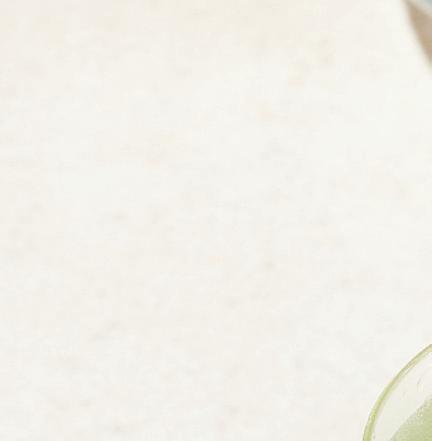

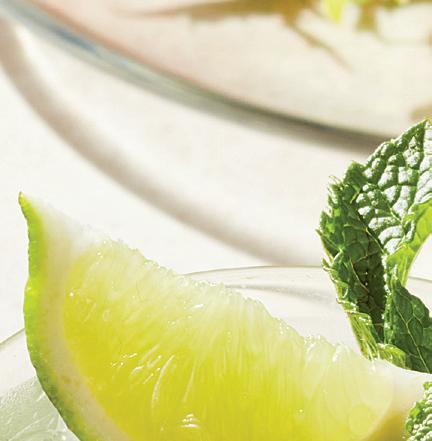

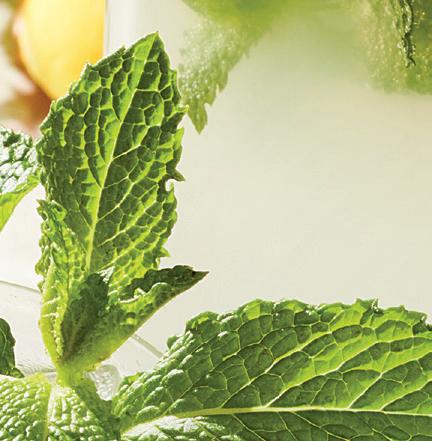
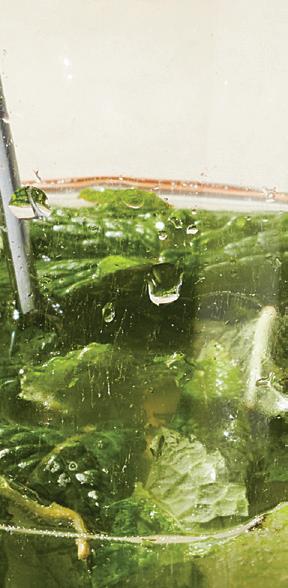

Bourbon Lemonade
Pour 16 ounces (2 cups) bourbon whiskey, 8 ounces (1 cup) simple syrup, and 32 ounces (4 cups) lemon juice into a pitcher and stir to mix. To serve, fill each lowball glass with ice cubes, pour in the cocktail mixture, and garnish with lemon slices and mint leaves.


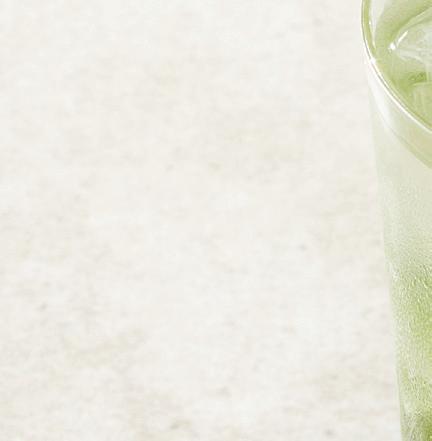
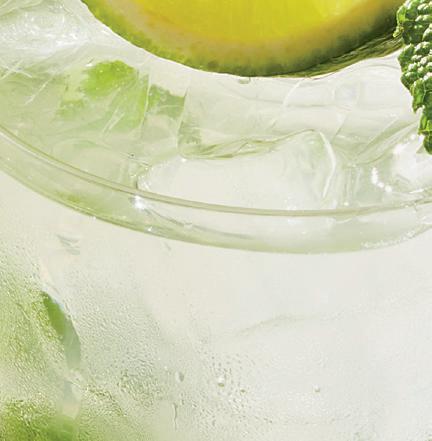
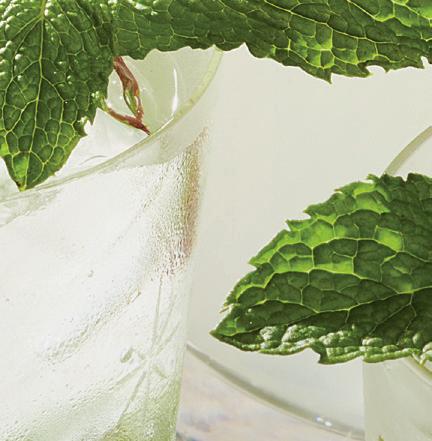

Gently muddle about 70 mint leaves in the bottom of your pitcher. Add 16 ounces (2 cups) white rum, 4 ounces (1⁄2 cup) fresh lime juice, 4 ounces (1⁄2 cup) simple syrup, and stir. Add 3 to 4 cups club soda to taste and stir gently. Pour over ice in each serving glass, and garnish with a lime wedge. (If you want to make this ahead, cover and refrigerate, leaving out the club soda until just before serving.)






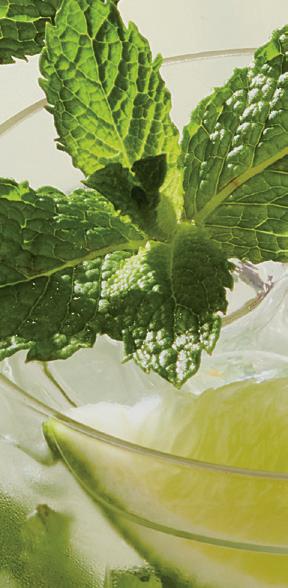
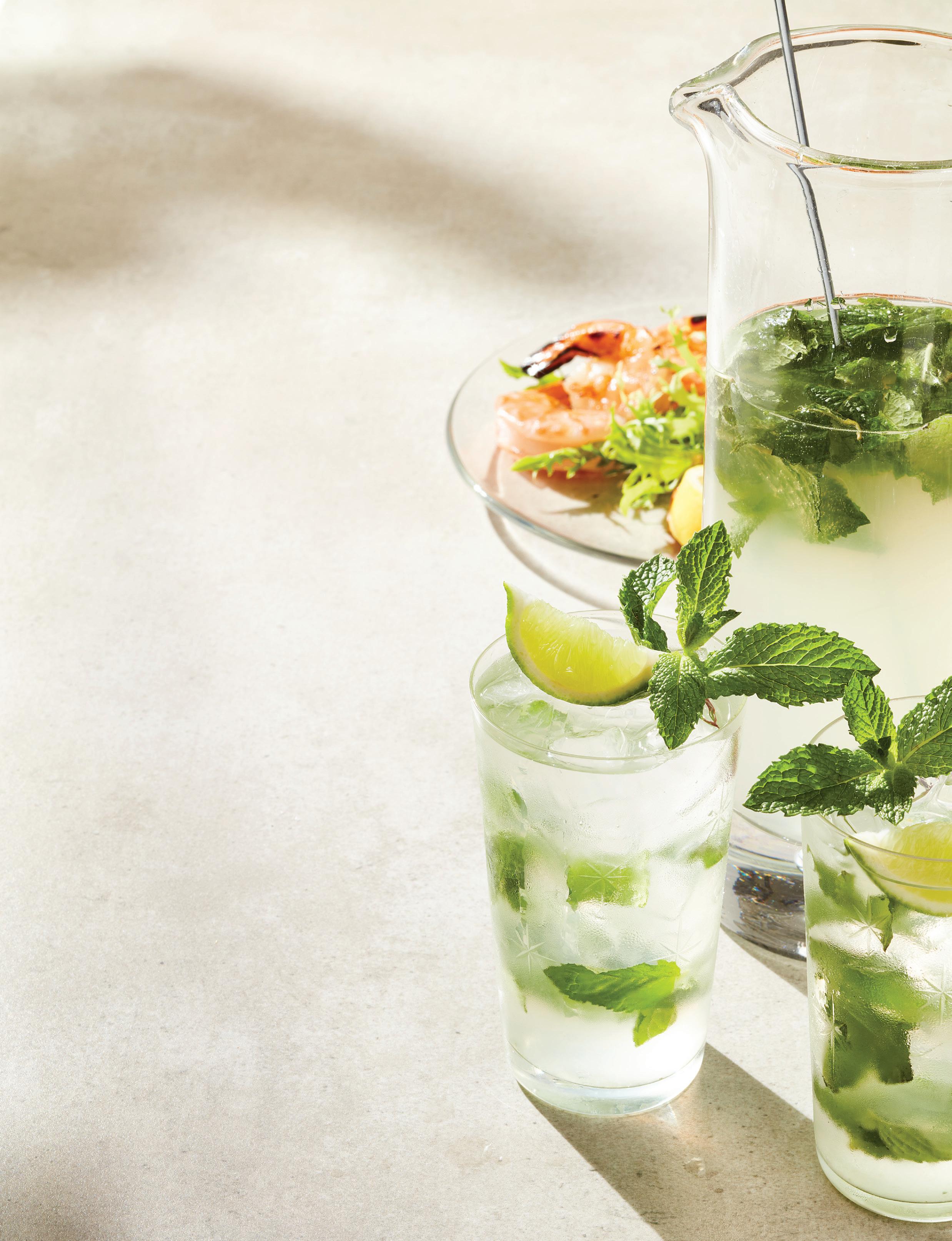
Skinny Margarita


Mix 16 ounces (2 cups) silver tequila, 4 ounces (1⁄2 cup) fresh lime juice, 4 ounces (1⁄2 cup) fresh orange juice, and 1⁄3 cup light agave nectar in a pitcher and stir. Use a lime wedge to moisten half of each glass rim and dip in salt, if desired. Pour each serving over ice in the prepared glass and garnish with a lime wedge.




